Management of burial grounds, application for burial, exhumation, private burial and restoration of lairs - regulation: consultation analysis
Analysis report of our consultation on the management of burial grounds, application for burial, exhumation, private burial and restoration of lairs in Scotland.
Findings
1.1 Commencement of Part 1 of the 2016 Act
Question 1. What do you think is an appropriate timeframe for burial authorities and the general public to prepare for the changes to the sale of right of burial? (Para 19)
This question asked respondents to select one option from a list of predetermined options (quantitative data), and in addition allowed a free text box for further comments (qualitative data).
Quantitative data
Forty-nine (49) of the 59 respondents answered this question. The most frequent (n=26) response to this question was ‘12 months’, making up the majority of those who answered the question. Table 2 and Figure 1 (below) show the responses broken down by respondent type (individual or organisational response, and whether, or not, respondents were part of the funeral sector).
| Respondent Type | Number of Responses (Q1) | |||
|---|---|---|---|---|
| 3 months | 6 months | 12 months | Another timeframe | |
| Individual - working in funeral sector | 0 | 0 | 3 | 0 |
| Individual - not working in funeral sector | 1 | 0 | 6 | 7 |
| Organisation - funeral directors | 0 | 2 | 0 | 0 |
| Organisation - burial and/or cremation authority or local government | 0 | 7 | 15 | 3 |
| Organisation - trade body | 0 | 2 | 1 | 0 |
| Organisation - other | 0 | 0 | 1 | 1 |
| All respondents | 1 | 11 | 26 | 11 |
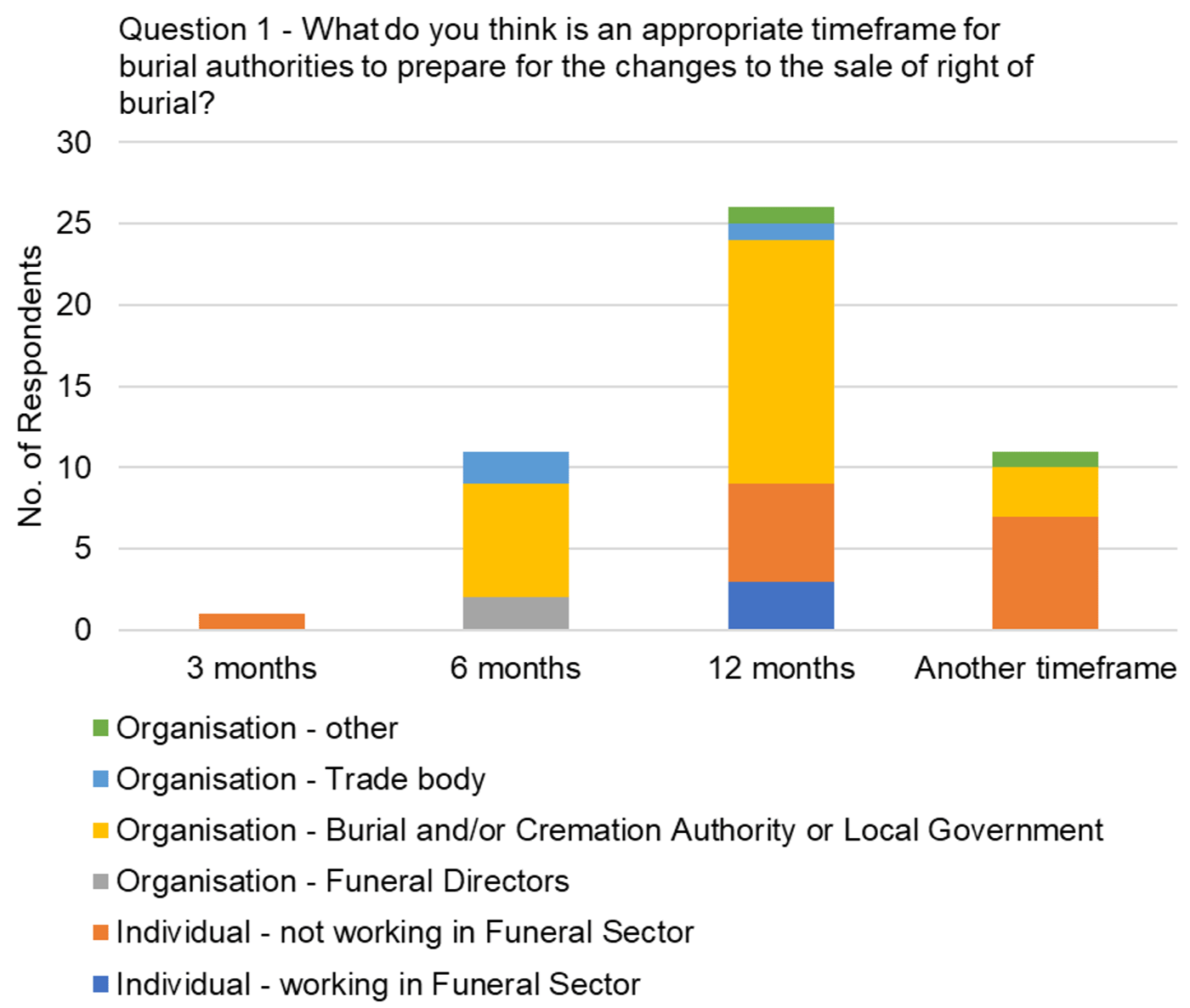
Qualitative data
Respondents were asked to give reasons for the option they selected and 45 provided comment. These comments have been summarised in three themes:
Theme 1 – Organisation preparation and impact
Over half the respondents, in particular those representing organisations, gave reasons that centred on the need for a time period that would accommodate the internal procedures and resourcing restrictions that might limit how quickly these changes to process could occur. These respondents mostly suggested 6 or 12 months would be required. Some noted that this might vary depending on the size of a burial authority and its existing procedures or resources. Some also suggested that the necessary changes, including those to IT systems might incur a cost, others mentioned potential impact to business income that these changes might bring.
“A minimum of 12 months would be needed to implement this due to the following:
- Time is needed to review and implement processes needed to administer the changes
- Time is needed to plan and get budgetary approval for the additional resources which would be needed from a change in process”
[Organisation response, burial authority]
Theme 2 – Public Communications
Several respondents, including organisations who raised issues around Theme 1 also commented on the need for communication with the public that would ensure the public was informed about the changes. It was felt that this would require a time period sufficient to allow this to be successful, most suggesting this should be 12 months.
“…regards the public, the changes in regulations could have a major impact on some people and they need a good amount of time to get used to the idea and to think about any arrangements they may need to make”
[Organisation response, trade body]
Some of the respondents commenting on the need for sufficient public communication also made comments that suggested a level of misunderstanding about what was proposed, which is explored in the next theme.
Theme 3 – Opposition and potential misunderstanding
The 25 year right of burial was not, in itself, subject to discussion in this consultation paper as it is set out in the primary legislation[2]. However, a small number of respondents were opposed to the changes to the sale of right of burial and used this space to voice this opposition.
In addition, as with some commenting around public communication, some responses showed evidence in their comments that these changes had been misunderstood as being applied to existing lair rights as opposed to sales of new lairs.
For clarity, changes to the sale of right of burial will not be retrospective. Any right sold before the commencement of the relevant provisions (which will build in the agreed grace period) will continue on the terms agreed at the time of sale which, depending on a burial authority’s policy at that time, could be for an indefinite period or could be for a set period if the burial authority has already taken steps to limit the duration of the right of burial.
1.2 Management of burial grounds
Question 2. Please provide any views you have on the proposed minimum content of the management plan, including whether any suggested content should be added to, or removed from, the plan. (para 22-25)
This question offered space for comments (qualitative data), without options to select from a predetermined list.
Qualitative data
Fifty-one (51) respondents provided comments. Around one third simply agreed with the proposed content of the management plan without further elaboration.
Around two thirds of respondents provided more extensive comments which tended to offer suggestions for additions to the management plan or removal from the list of examples given. These are summarised below.
Suggestions for additions:
- A complaints procedure
- A procedure for dealing with any historic buildings or structures, including boundary walls
- A register of statutory designations affecting the burial ground
- The management of burial records and access to them
- Historical and ecological conservation
- Community engagement initiatives
- An estimate of how many years of new lair supply are left, updated annually
- Procedures for booking burials
- Sustainability and environmental impacts and considerations (e.g. recycling procedures, what can be left on graves etc.)
- Management of car parks
- Risk assessment and responsibilities where work is caried out on site by third parties
- A procedure for dealing with unauthorised memorials
- key stakeholder consultation for any proposed changes or extensions to the burial grounds, including biodiversity changes.
- Contingency arrangements expanded to include catastrophic collapse and loss (e.g. coastal erosion, landslip, and flooding)
Suggestions for removal included:
- The reference to ‘business hours’ which is not always relevant to burial grounds run by volunteers.
- Documenting the operation and servicing of equipment which may be onerous and difficult (as some equipment is hired in)
- That the defined categories of active, inactive and historic burial grounds are problematic
Additional suggestions included:
- A two-tier approach to management plans with a main strategic overview plan with additional site specific plans.
- a template for creating the burial management plan that so that plans are consistent in terms of their content and structure across all burial authorities
Question 3. Who do you think should be able to inspect or view a management plan on request? (para 26)
This question asked respondents to select as many options as they wanted from a list of predetermined options (quantitative data), and in addition allowed a free text box for further comments (qualitative data).
Quantitative data
Fifty-three (53) of the 59 respondents answered this question but since respondents were able to select more than one option the responses shown add up to more than the number of respondents. The most frequent response selected was “Inspectors” with almost all those answering selecting this. Around half of respondents answering the question selected all of the first five options (i.e. Inspectors, Scottish Government, Members of the public, Another burial authority and Other parties) without selecting “No one”.
Table 3 and Figure 2 (below) show the number of respondents who selected each option [NB. Respondents could select more than one option].
| Question 3 - Who do you think should be able to inspect or view a management plan on request? | No. of Responses |
|---|---|
| Inspectors | 52 |
| Scottish Government | 47 |
| Members of the public | 45 |
| Another burial authority | 34 |
| Other parties | 29 |
| No one - internal document only | 1 |
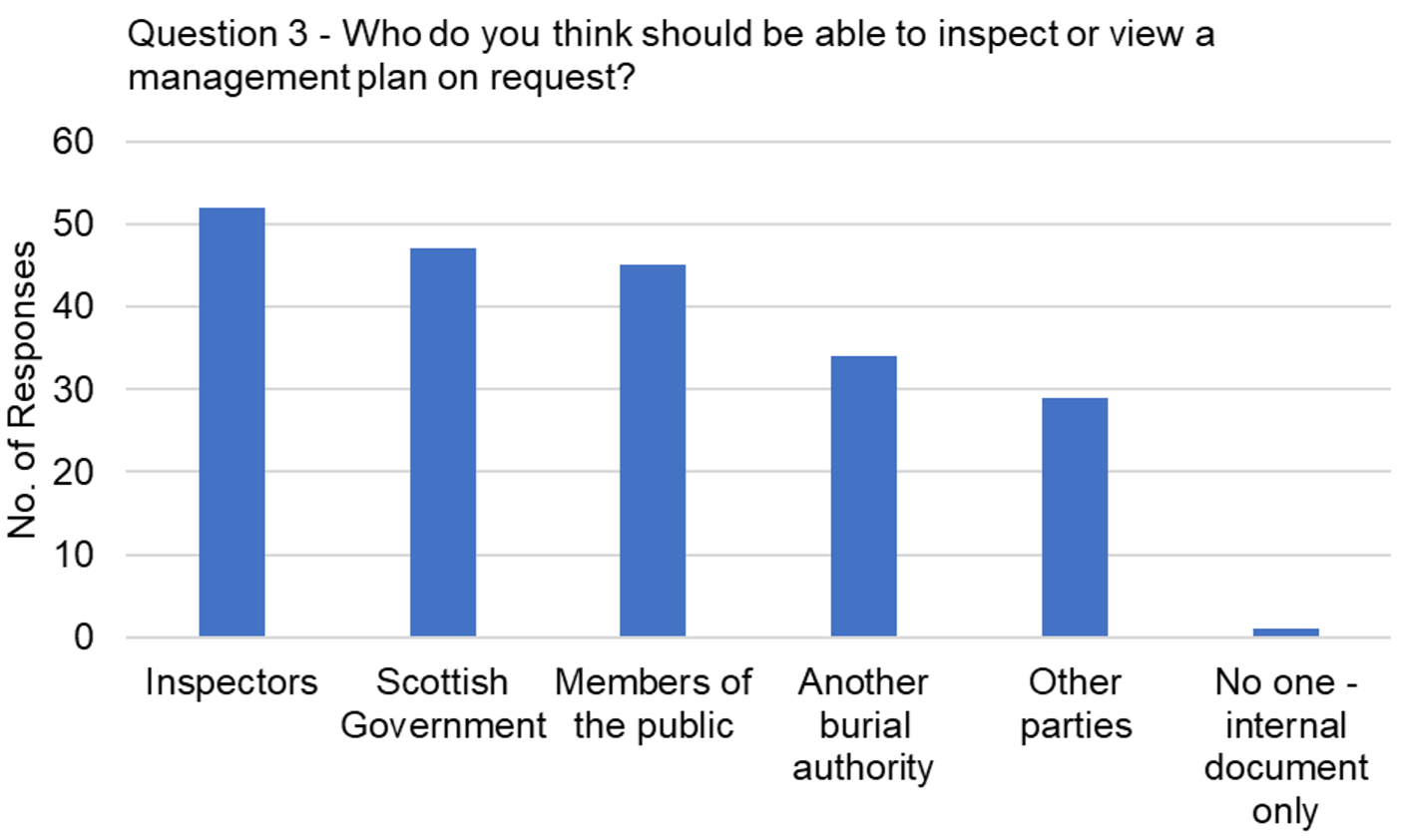
Qualitative data – Please give reasons for your answer
Respondents were asked to give reasons for the options they selected and 48 provided comment. Almost all respondents shared the view that management plans should be fully transparent and publicly available to all. Whilst many were open to making management plans available on request, others went further and stated that management plans should be published online for all to view. Some of these respondents also recognised the value that management plans would have for the local community. Others highlighted the need for restrictions on any confidential personal or commercial information.
Of the small minority that selected inspectors and/or Scottish Government only, concerns were noted around providing too much information to the public, particularly for faith groups at risk of faith based attacks. Other comments focused on reaching a balance on public accessibility:
“Members of the public and other operators in the sector will seldom if ever have rights in any other sector to view detailed management plans of organisations. There should be a balance between what the public is able to access and what a burial authority has to maintain in order to satisfy its regulator (e.g. the Inspector) or the government.”
[Organisation, burial authority]
Question 4. What timeframe should burial authorities be given to put a management plan in place after the regulations come into force? (para 27)
This question asked respondents to select one option from a list of predetermined options (quantitative data), and in addition allowed a free text box for further comments (qualitative data).
Quantitative data
Fifty-four (54) of the 59 respondents answered this question. The most frequent response (n=25) was ‘12 months’ should be given to put a management plan in place after regulations come into force.
Table 4 and Figure 3 (below) show the responses broken down by respondent type (individual or organisational response, and whether, or not, respondents were part of the funeral sector).
| Respondent Type | Number of Responses (Q4) | ||||
|---|---|---|---|---|---|
| 3 months | 6 months | 12 months | Other | Don't Know | |
| Individual - working in funeral sector | 0 | 0 | 2 | 0 | 0 |
| Individual - not working in funeral sector | 2 | 6 | 6 | 3 | 0 |
| Organisation - funeral directors | 1 | 0 | 1 | 0 | 0 |
| Organisation - burial and/or cremation authority or local government | 1 | 7 | 13 | 5 | 1 |
| Organisation - trade body | 0 | 1 | 2 | 0 | 0 |
| Organisation - other | 0 | 0 | 1 | 2 | 0 |
| All respondents | 4 | 14 | 25 | 10 | 1 |
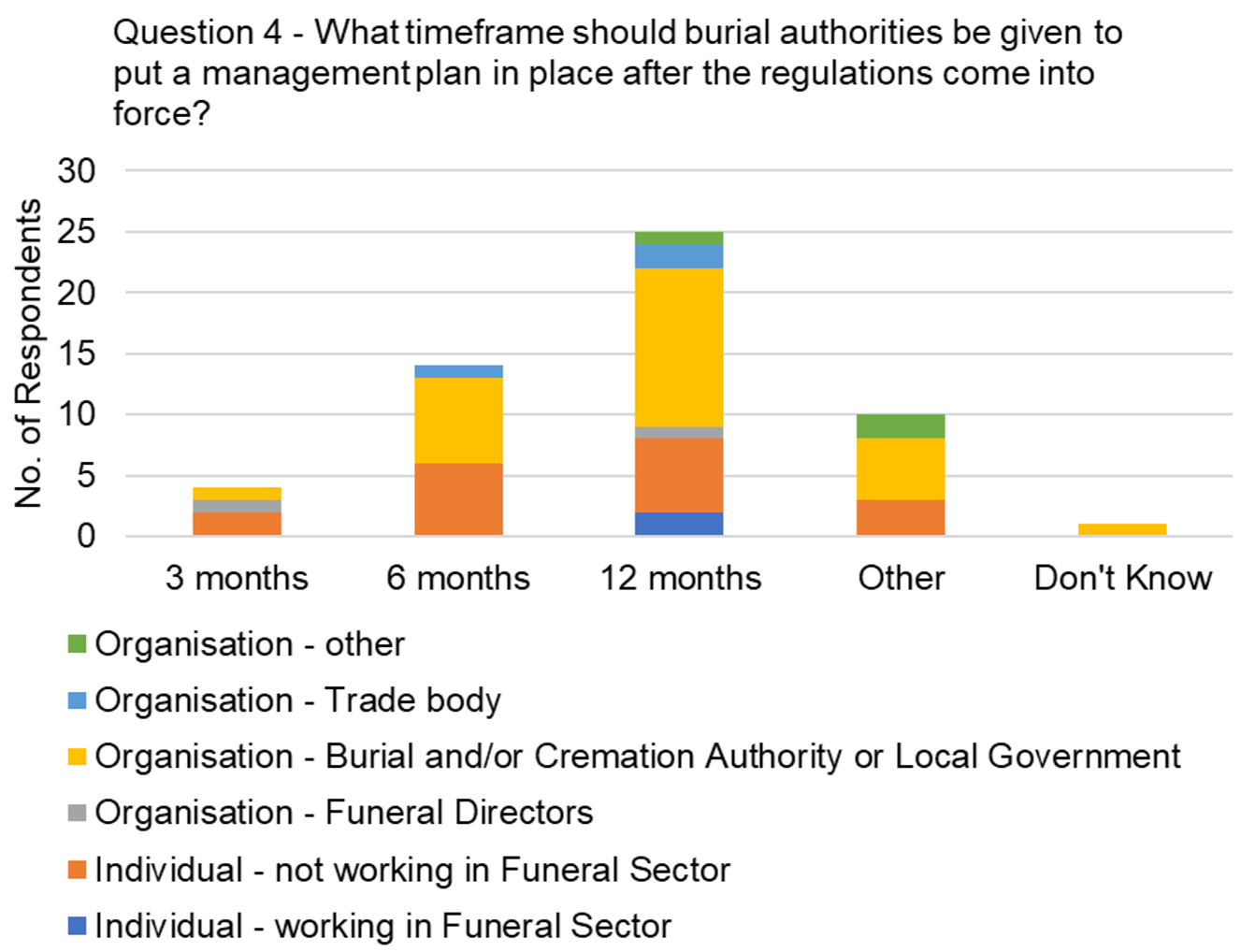
Qualitative data
Respondents were asked to give reasons for their answers and 47 provided comment here. Some of these comments simply reiterated the answer they had previously selected from the options, others provided more substantial comments.
For those who selected ‘Other’ 6 respondents specified an alternative timeframe and all of these were between 12 and 24 months, and 2 of these respondents suggested a phased approach should be used, particularly for larger authorities:
“We recommend a phased approach would allow for plans to be fully considered and to build in detail, planned and processed. We would see the overall completion of the overarching Strategic Management Masterplans within 12 months by the Burial Authorities, with individual management site management plans following and completed within 5 years depending on the number and complexity of the sites within the remit of the Authority.”
[Organisation response, local government]
The majority of the more substantial comments focussed on describing reasons why time would be needed for authorities to put management plans in place. These included:
- Time to collate necessary information and produce the plan
- Time to adjust any existing management plans to meet the requirements
- Resourcing considerations including staff availability and other existing priorities
- Time to allow for internal governance and standard procedures within local authorities in particular, including any consultation and guidance that was sought as part of this
“18 months would be a reasonable time to formalise a management plan in the context that most council’s will likely have no additional resources made available to produce this document, 18 months will allow the plan to be produced without need to compromise ongoing routines operations, or seek additional administrative resources etc. Publication will require appropriate governance arrangements and committee approval, which could become protracted as rules related to public memorial items will be included in management plans.”
[Organisation response, local government]
Several participants also commented on the likelihood of variation across different authorities, especially depending on the size and number of burial grounds managed and whether or not they already have a management plan in place.
“A timeframe of at least a year should be permitted to ensure that the creation of a management can be planned in with other work priorities. In addition some local authorities may have a larger number of cemeteries, each with different requirements within the management plan, thereby influencing the time needed to create the document.”
[Organisation response, burial authority]
Question 5. Do you think that burial authorities should be required to review the management plan annually? (para 27)
This question asked respondents to select one option from a list of predetermined options (quantitative data), and in addition allowed a free text box for further comments (qualitative data).
Quantitative data
Fifty-three (53) of the 59 respondents answered this question. The majority (n=32, 60%) of respondents answered ‘Yes – it sounds right’, agreeing that burial authorities should be required to review the management plan annually, and (n=19, 36%) answering that this was too often.
Table 5 and Figure 4 (below) show the responses broken down by respondent type (individual or organisational response, and whether, or not, respondents were part of the funeral sector).
| Respondent Type | No. of Responses (Q5) | |||
|---|---|---|---|---|
| Yes - it sounds right | No - it's too often | No - it's not often enough | Not sure | |
| Individual - working in funeral sector | 1 | 1 | 0 | 0 |
| Individual - not working in funeral sector | 8 | 7 | 1 | 1 |
| Organisation - funeral directors | 1 | 1 | 0 | 0 |
| Organisation - burial and/or cremation authority or local government | 19 | 8 | 0 | 0 |
| Organisation - trade body | 2 | 1 | 0 | 0 |
| Organisation - other | 1 | 1 | 0 | 0 |
| All respondents | 32 | 19 | 1 | 1 |
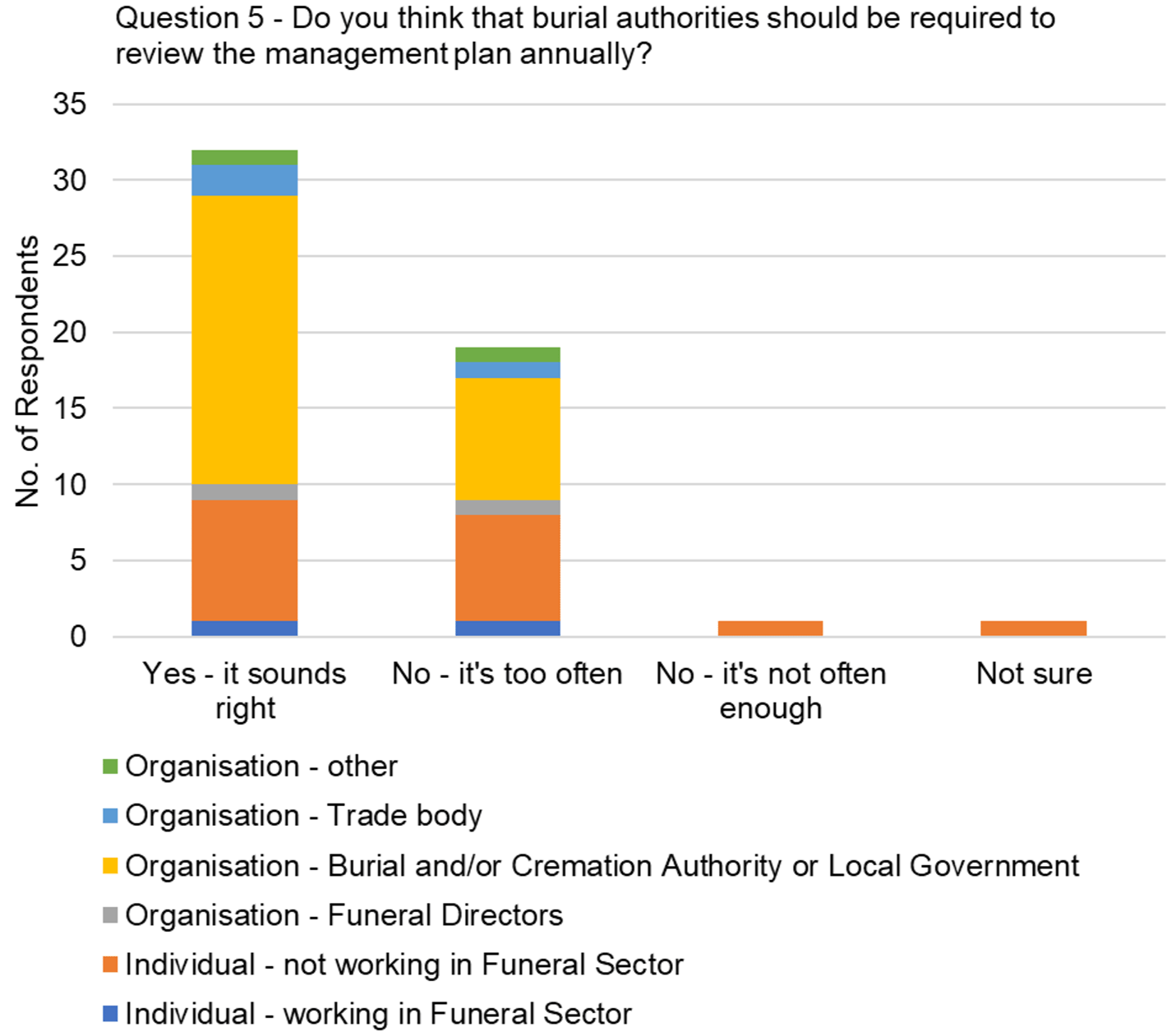
Qualitative data
Respondents were asked to give reasons for their answers and 48 provided comment here. Some reiterated the response from the first part of the question, others offered more substantial comment. These have been summarised into three themes:
Theme 1 – Good practice
The most frequent comments related the proposed annual review with ideas around good practice. This was only raised by respondents who agreed with the proposed annual timing of review and the majority of these kind of comments were made by respondents representing organisations. Comments included those seeing annual reviews as an important way of: keeping up to date with relevant changes that might affect the management plan; supporting compliance and improvement; keeping in line with other reviews/management plans and other bodies (e.g. cremation authorities).
“Local authorities are constantly evolving and changes happen frequently, therefore any management plan would have to be reviewed annually.”
[Organisation response, burial authority]
“Having a set review timeframe allows changes/amendments to be established as routine and also keeps the cemetery management plan in line with crematorium management plan.”
[Organisation response, burial and cremation authority]
Theme 2 – Labour
There was a mix of comments in terms of how labour or resource intensive such a review might be for burial authorities. Some felt that this would be burdensome for burial authorities whereas others felt that since some of the information contained within would remain the same over time that this would mean reviews would be feasible. Lack of change over time was also mentioned by some respondents as a reason for less frequent reviews.
“This would be time consuming and we have limited resources we wish to focus on customer service. Suggest every 5 years would be adequate.
Most but not all of this information such as cemetery locations will be on our web pages and updated annually.”
[Organisation response, local government]
“Yes, we agree an annual review is appropriate in most cases. It may be that certain elements of the management plan would remain valid for a much longer periods, however, this could be accounted for in the scope of any review that takes place to help with resourcing pressures.”
[Organisation response, burial authority]
There were some comments looking for clarity on what a review might entail. As in Question 4, internal local authority processes and governance were mentioned as potential barriers to annual review, if the review required revising and publication.
“The extent of the review and any Scottish Government reporting associated with the review will directly determine if an annual review is too often. If the review only requires a confirmation that existing document is fit for purpose, and publication of any annual performance measures, one year would be appropriate. If public consultation is required and committee approval etc and publishing revised document etc. then 5 years would be more appropriate. 5 years would be in line with Open Space Plan revisions. I’d suggests a 5 year revision of the management plan, and an annual review. The later may form part of a wider authorities’ annual performance reporting as opposed to unique reporting associated with burial service.”
[Organisation response, local government]
Theme 3 – Alternative timeframes
Although the majority of respondents answered ‘Yes – it sounds right’ 21 did not answer this way. Of those, 16 offered alternative timeframes that they thought were more suitable. Two respondents suggested 2 yearly, 3 suggested 3 yearly, 6 suggested 5 yearly and 3 suggested 5-10 yearly. Additionally two respondents made comments around a more flexible approach (see point below).
Some respondents, including those who agreed with an annual review suggested more variable or flexible review timeframes. Several felt there should be scope for additional reviews of the management plan outwith the regular timing, if issues arose that required it. One respondent felt that reviews of the management plan should only be done on this basis, without a set timeframe.
Some respondents suggested there might be an element of flexibility or basing reviews on response to risk when determining how frequent these reviews should be e.g. less frequent for inactive and historical grounds. Similarly one respondent suggested aligning management plans with the frequency of inspections.
Annual reviews could lead to it becoming an admin exercise. We would support a two year review as a minimum but could see a case for extending this to three years for inactive or historical grounds.
[Organisation response, trade body]
It would seem sensible for the management plan review cycle to align with the relevant inspection cycle.
[Organisation response, faith based organisation]
Question 6. What is your view on the proposed list of powers to be granted to burial authorities to enable them to manage and maintain their burial grounds to a safe standard? (para 28 - 30)
The powers referenced in Question 6 are:
- carry out general maintenance and upkeep of the burial ground and all buildings and structures, walls, fences and other such erections (except headstones or memorials which are discussed separately).
- enclose, lay-out and embellish the burial ground as the burial authority considers necessary or appropriate.
- take steps to improve and maintain public access to, and within, the burial ground.
- carry out inspections, maintenance and repairs on headstones and memorials necessary to make them safe, subject to the conditions outlined below.
- impose such restrictions and conditions as the burial authority thinks necessary or appropriate in relation to the erection of a memorial, building or other structure.
This question asked respondents to select as many options as they wanted from a list of predetermined options (quantitative data), and in addition allowed a free text box for further comments (qualitative data).
Quantitative data
Fifty-four (54) of the 59 respondents answered this question. The most frequent response (n=31) was “It looks right”. Since respondents could select more than one option there was a total of 58 choices made, with 4 respondents selecting more than one option. These 4 respondents selected options that highlighted issues with the proposed list (i.e. ‘it does not look right’, ‘Some of these powers are unnecessary’ or ‘Some powers are missing’).
Table 6 and Figure 5 (below) show the number of respondents who selected each option [NB. Respondents could select more than one option].
| Question 6 What is your view on the proposed list of powers (set out in the bullet points above) to be granted to burial authorities to enable them to manage and maintain their burial grounds to a safe standard? | No. of Responses |
|---|---|
| It looks right | 31 |
| It does not look right | 8 |
| Some of these powers are unnecessary | 5 |
| Some powers are missing | 12 |
| Not sure | 2 |
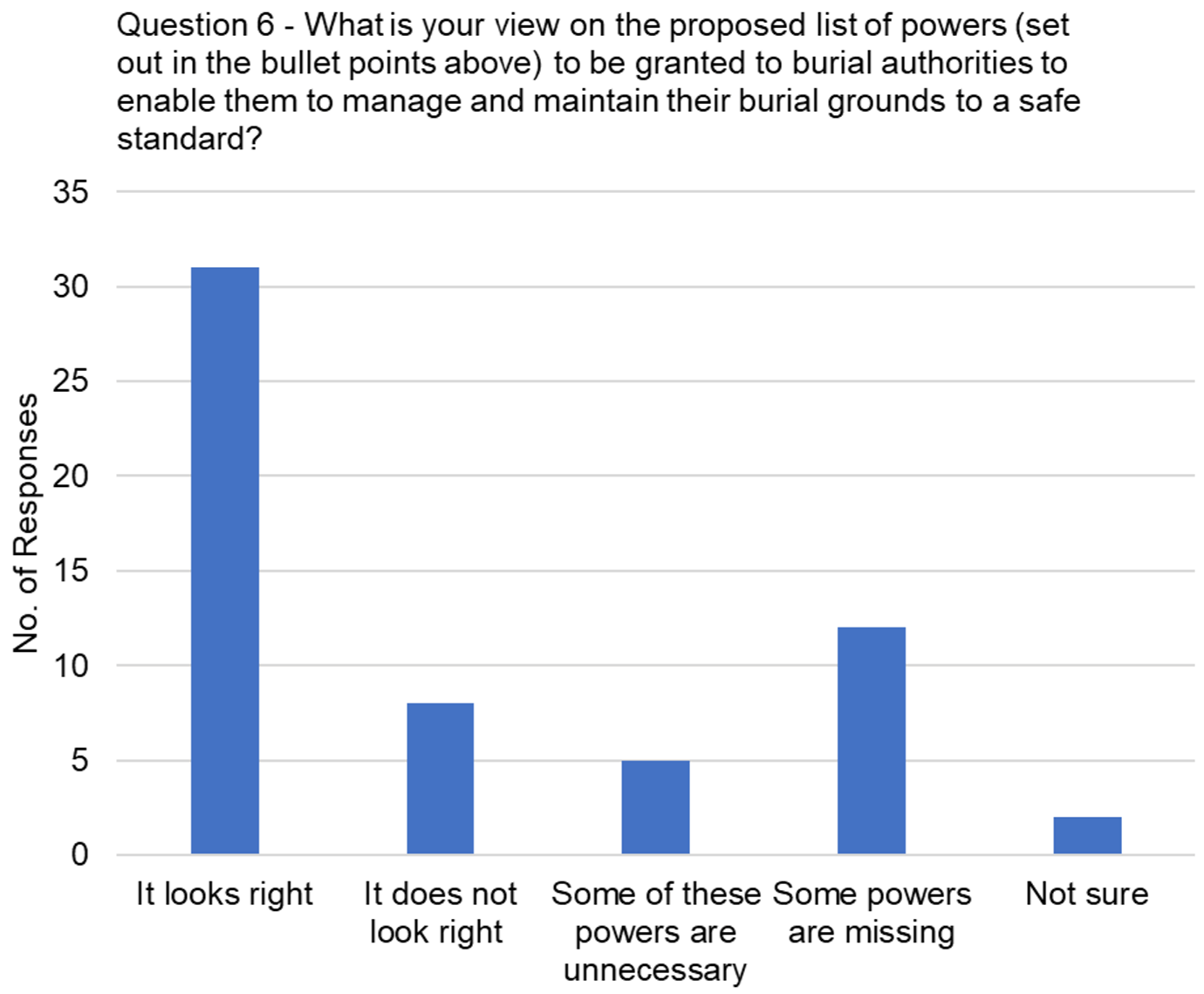
Qualitative data
Respondents were asked to give reasons for their answers and provide any further comment. Forty (40) respondents offered comments. Those who had selected “It looks right” tended to reinforce their support in the comments, while those who had selected other options gave reasons for this. There were several suggestions for additions or changes to the powers named and these have been summarised below:
Theme 1 - powers to manage public access
Several respondents suggested that the powers around public access needed to reflect balancing access with protection of the area and public safety. This included being able to restrict or manage dog access, and manage additional areas like car parks. As in previous responses issues were raised around the effect that high tourist numbers have on burial grounds, and those using them, close to scenic areas.
“Local authorities should have power to close any part of a burial ground to ensure public safety. This will become increasingly required as burial grounds that are no longer open to new burials will increasingly have limited available investment to maintain in safe condition or inspect to determine condition i.e. the council will increasingly prioritise investment to ensure active burial grounds are safe and can remain open. Any part of a burial ground closed would require due consideration of any potential public demand to visit the burial ground.”
[Organisation response, local government]
Theme 2 - powers of conservation or protection
There were suggested additions to the proposed powers that might include protection of heritage and nature, management of wildlife causing damage, and pruning or removal of plants causing damage.
Theme 3 - powers to manage removal of ‘unauthorised items’
Three respondents suggested including powers to remove items such as benches or plants.
Additional comments
One respondent suggested the power to facilitate the legal transfer of the right of burial should be included and another that the power to offer alternative lairs should be included. One respondent suggested there should be a power to recoup expenses incurred in making lairs safe where they have not been maintained sufficiently by the lair right-holder.
Two respondents commented that they felt the language used in the proposal was too vague and needed to more specific.
Question 7. Where a lair right-holder is ‘known’ (or at least some form of contact details are held), and the danger is not imminent, do you think that regulations should require a burial authority to notify the lair right-holder prior to taking corrective action to a lair, headstone or memorial? (para 36 - 40)
This question asked respondents to select one option from a list of predetermined options (quantitative data), and in addition allowed a free text box for further comments (qualitative data).
Quantitative data
Fifty-four (54) of the 59 respondents answered this question. A majority (n=38, 70%) of respondents answered ‘Yes’ that regulations should require a burial authority to notify the lair right-holder prior to taking corrective action to a lair, headstone or memorial.
Table 7 and Figure 6 (below) show the responses broken down by respondent type (individual or organisational response, and whether, or not, respondents were part of the funeral sector).
| Respondent type | Number of Responses (Q7) | ||
|---|---|---|---|
| Yes | No | Not sure | |
| Individual - working in funeral sector | 2 | 0 | 0 |
| Individual - not working in funeral sector | 12 | 3 | 2 |
| Organisation - funeral directors | 2 | 0 | 0 |
| Organisation - burial and/or cremation authority or local government | 16 | 6 | 5 |
| Organisation - trade body | 3 | 0 | 0 |
| Organisation - other | 3 | 0 | 0 |
| All respondents | 38 | 9 | 7 |
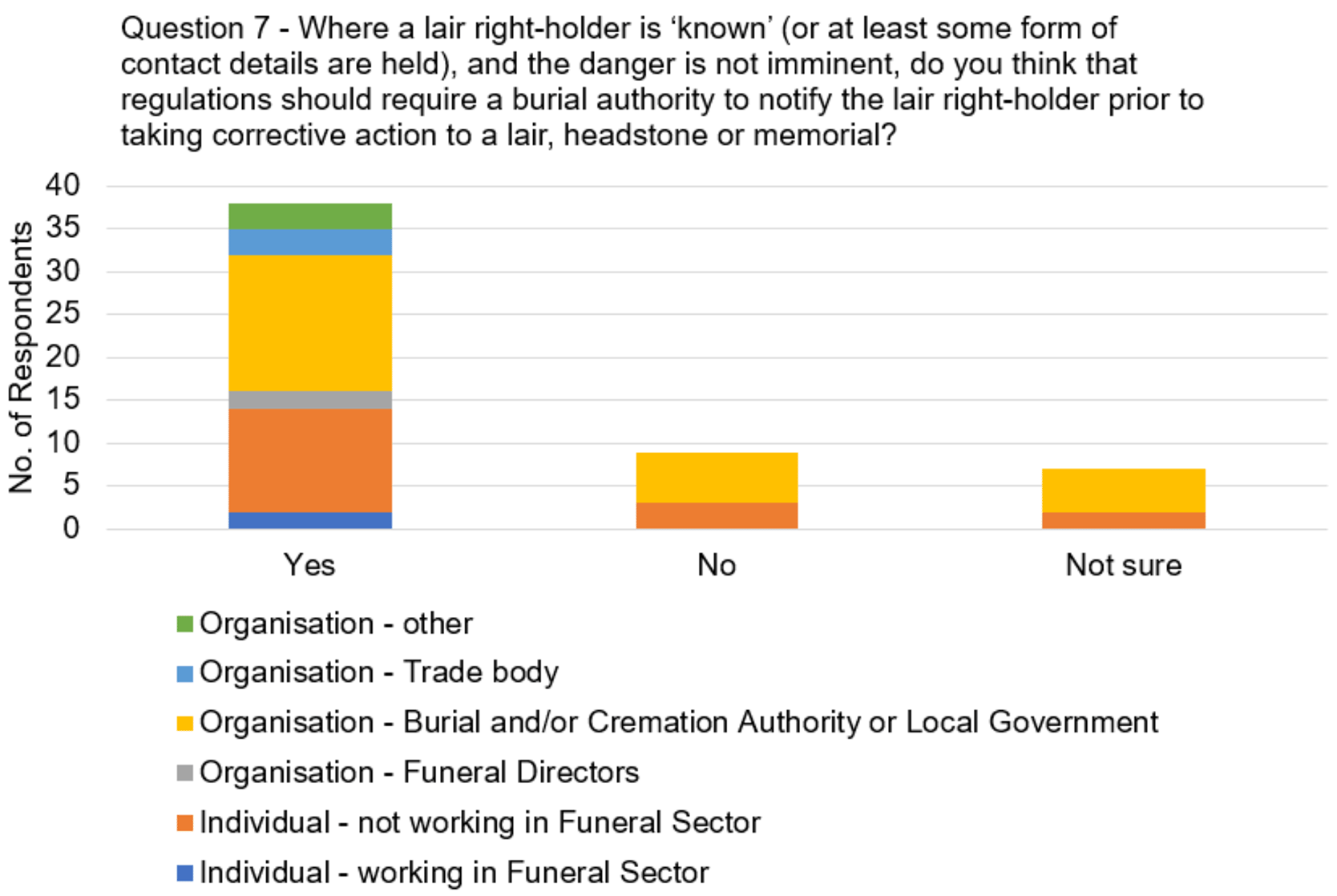
Qualitative data
Respondents were asked to give reasons for their answers. Forty-six (46) respondents offered comments.
Although there were ‘yes’ and ‘no’ options, the comments suggested that this is a more nuanced issue and there were similar issues raised across the respondent group. The majority of answers acknowledged the lair rights-holder as the responsible party for any remedial work, and the reasons why it would be appropriate to contact them. However the difficulties with making contact, and the associated administrative burden, were acknowledged in many of the comments, including the direct experience of these difficulties reported by those responding from burial authorities.
“It is very difficult to locate the lair holder, as we have found when inspecting headstones. We should be able to carry out maitenance [sic] of lairs when required, having to try and contact a lair holder will waste a lot of time when a problem is found. e.g. following recent stom [sic] Babet, we had almost 100 lairs in a cemetery that needed re-levelling, to attempt to contact each lair holder would have taken weeks, we managed to sort everything in a few days.” [Organisation response, burial and cremation authority]
Reasons for attempting contact included ensuring families have the opportunity to carry out the work themselves (and pay for this), avoiding upset to the family, and raising awareness of the responsibilities of lair rights-holders.
“Where there is no imminent danger, lair holders should be consulted at all times to prevent further distress and to ensure they are fully informed of what is happening. They could pay for repairs, which could also help keep burial authority costs down as much as possible”
[Organisation response, trade body]
Some respondents suggested that in addition to risk other considerations could be made before deciding to pursue contact e.g. how old the lair is, and when it was last opened.
“Ideally owners will take financial responsibility for repair where possible, and this step will ensure families are not unduly upset by changes where they do wish to complete maintenance themselves. If a burial authority is re-fixing an unsafe headstone (imminent danger), there should be no requirement to contact lair holder before repair or laying flat. Also, if the lair has not been opened in circa. 40 years i.e. the majority of our headstone stabilisation works relate to lairs that have not been opened for many decades, we consider that we should not have to contact families unless we damage headstone during repair i.e. to require contact in all these cases could inhibit our proactive ongoing safety programme due to additional administrative resources required.” [Organisation response, local government]
Several responses focussed on headstones or memorials in particular, regardless of the answer they had selected. In the responses from people who had answered ‘no’ or ‘not sure’ these highlighted a need for different guidance on headstones in particular, as opposed to considering this alongside other tasks that could be considered more regular maintenance.
“There should be no requirement to contact a lair owner in regards to maintenance of the lair. The levelling of ground and re-positioning of plants/pots etc is part of routine maintenance of the cemetery and would have a massive impact in the day to day maintenance of the cemeteries. This would also have an adverse effect on the excavations of lairs for burials where an adjacent lair has items on it the time involved to contact lair owners/families would cause a huge time delay in burials going ahead. This would have a massive impact on staff resources and would have a negative impact on the bereaved. Contact should only be required when it is concerning the memorial/headstone and does not have an impact on an imminent burial. When headstone/memorial has to be removed for a burial to go ahead contact can be made after the burial to inform lair owner of the reason for any works.” [Organisation response, burial authority and cremation authority]
Responses from those who answered ‘yes’ also tended to focus on headstones and memorials. Comments from this group of respondents tended to focus more on the upset this might cause families if these are laid flat without notice or contact being made. Some responses suggested more effort should be made to contact families in this case, with some feeling that not enough effort has been made in their experience.
“The lack of communication from some burial authorities with lair holders is dreadful. Lairs have been closed and even moved with no direct contact with the lair holder, only via third parties. Any work, apart from imminent endangerment, must have at least an attempt to contact the lair holder.”
[Organisation response, funeral director business]
Others suggested that there is not necessarily time to make contact when a headstone becomes unsafe. Some responses from burial authorities suggested that notices at the lair and elsewhere at the site can help notify lair rights-holders and raise awareness more generally. Another felt that phone contact could be more personal for people to receive and a quicker way of determining what the outcome might be. A further respondent commented that:
“The lair right holder should be advised that the work is taking place, but the work should commence irrespectively [sic].” [Individual response, does not work in the funeral sector]
Question 8. If you answered ‘yes’ to question 7, how long should the lair right-holder be given to carry out necessary repairs to a headstone or memorial before a burial authority takes corrective action to make the memorial safe? (para 36 - 40)
This question asked for respondents to select one option from a list of predetermined options (quantitative data), and in addition allowed a free text box for further comments (qualitative data). This question asked that only those who answered ‘yes’ to the previous question (Question 7) should answer, therefore only responses from those respondents (n=38) have been considered.[3]
Quantitative data
Thirty-seven (37) of the 38 respondents eligible for this question gave answers. Answers were varied and three options were the most frequently selected with 11 responses each: ‘3 months’, ‘6 months’ and ‘Other’.
Table 8 and Figure 7 (below) show the responses broken down by respondent type (individual or organisational response, and whether, or not, respondents were part of the funeral sector).
| Respondent Type | Number of Responses (Q8) | ||||
|---|---|---|---|---|---|
| 1 month | 2 months | 3 months | 6 months | Other | |
| Individual - working in funeral sector | 0 | 0 | 0 | 0 | 1 |
| Individual - not working in funeral sector | 1 | 0 | 4 | 2 | 5 |
| Organisation - funeral directors | 0 | 0 | 0 | 2 | 0 |
| Organisation - burial and/or cremation authority or local government | 2 | 1 | 6 | 5 | 2 |
| Organisation - trade body | 0 | 0 | 1 | 0 | 2 |
| Organisation - other | 0 | 0 | 0 | 2 | 1 |
| All respondents | 3 | 1 | 11 | 11 | 11 |
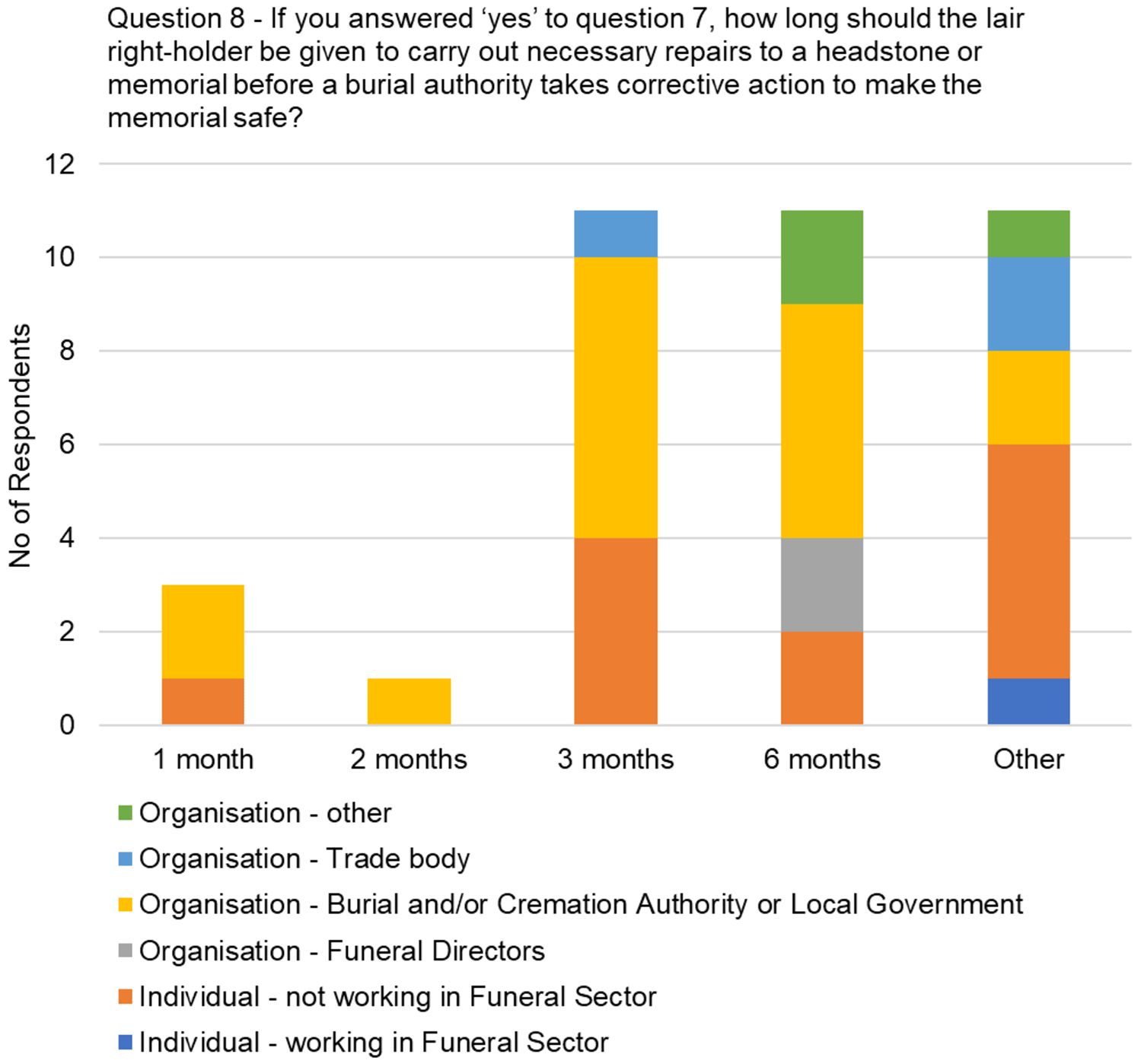
Qualitative data
Respondents were asked to give reasons for their answers. Thirty-two (32) of the 38 eligible to answer the question offered comments. Some comments were not specifically related to the question and made more general comments.
Regardless of the timeframe that respondents had selected, comments tended to centre on making sure there was a balance between allowing enough time to notify and engage in remedial action, without the situation deteriorating or becoming more of a safety risk. Some gave specific reasons for the timeframe around considering other constraining factors, like the time taken to engage a stonemason.
“Three months would be a suitable timescale. Dangers could increase if repairs are not carried out, and damage may also be unsightly which, in well maintained burial grounds, would detract from the amenity of the burial ground for visitors. It would be appropriate for lair holders to have notice, but the length of time has to be balanced with the burial authority's wider obligations and the interests of users of the burial ground.” [Organisation response, burial authority]
Several respondents suggested a variable or flexible timeframe might be more appropriate depending on the circumstances of the issue, rather than a fixed timescale set in regulations.
“There should be a sliding scale, if there is an urgent risk then the memorial headstone should be made safe immediately and lair holder contacted retrospectively. Our current practice is we ask lairholders (where a headstone has failed an inspection) to contact us within 2 months and asking them to repair within 3 months.” [Organisation response, burial authority]
Similarly it was suggested that different timescales were needed for contacting lair right-holders, and for the work itself to be started or completed.
Question 9. Where lair right-holders are unknown (contact details are outdated), please provide views on the most appropriate way to publicise the intention to carry out inspections and potential corrective action to make headstones and memorials safe. (para 41)
This question offered space for comments (qualitative data), without options to select from a predetermined list.
Qualitative data
Fifty-one (51) respondents made suggestions for publicising the intention to carry out inspections and potential corrective action to make headstones and memorials safe. There were a number of suggestions and these have been summarised below.
Theme 1 – Physical notices
More than half of the respondents suggested that physical notices should be placed at the burial ground, for example, at the entrance to the burial ground and on noticeboards or in other visible locations. Some drew attention to the ongoing nature of inspections and the need for permanent signage. In addition, a number of respondents suggested that individual notices should be placed at relevant headstones to provide contact details for the lair right-holder to obtain further information.
“Posting notification within a cemetery is the method most commonly employed by the council. We post notices that headstones are being tested, and apply red tape to those to be reinstated, notices have our contact details. We may post individual notices on headstones if there has been a lair opening recently, and we can’t contact lair holder with existing contact details.
[Organisation response, local government]
Theme 2 – Media notices
As with physical notices, a frequent suggestion was to notify lair right-holders via local media, for example, a notice in the local press, radio, relevant social media pages or on the council’s website. However, responses did highlight a number of drawbacks, including limitations in terms of reach.
“I do not think that social media is appropriate; local press does not have the reach it once did. I think that notice should comprise: i) public notice on the burial ground's website; ii) a notice on the cemetery noticeboard; and iii) a notice attached to the memorial itself.” [Organisation response, burial authority]
“Some inspections and corrective action may be modest in scale, although still necessary. In such cases, notification in local press would be expensive and inefficient. Burial grounds often serve as the resting place of people not only from within the local area, and the use of local press would have limited reach. Any wider notification through press (on a national level, for example) would, however, be even more prohibitive in terms of costs and would be inefficient and expensive. It would make better sense for notification on a public noticeboard so that those who are regular visitors to the burial ground, and who thus are genuinely interested, would be able to see notices and respond.” [Organisation response, burial authority]
Theme 3 – Discretion
A small number of respondents, whilst agreeing in principle with physical and/ or media notices, highlighted the need for discretion on the part of the burial authority.
“This may best be determined on a case-by-case basis, with potential approaches that might be used described within management plans. While social media may be excessive for a small number of memorials, if large parts of a burial ground are restricted then social media posts may be the best way to bring this to the attention of the public.” [Organisation response, burial authority]
“Very small volunteer-run burial authorities are, however, unlikely to have sufficient resources to undertake lengthy searches, or to contact lair-holders on an individual basis, and should not be required to do so.” [Organisation response, faith based organisation]
One respondent suggested that any method of notification should remain as guidance only and not be regulated.
Theme 4 – Community outreach
A minority of respondents suggested that specific outreach action should be taken to notify local groups, for example: community councils, council newsletters to residents, local clergy, care home residents and the elderly (who are less likely to use social media), friends of the cemetery groups, faith communities (including religious leaders).
“Concerted use of local networks, such as area partnerships and community councils should be utilised. Local authorities currently cascade large quantities of information relating to their work to a local level in this way, such activities should also be shared with communities.” [Organisation response, third sector]
Theme 5 – Online platform
Three (3) responses commented that there should be a dedicated space on a local or national web portal where notices are published.
“Given the scale of the problem a regular PR campaign could be arranged with local and national media directing members of the public to a clear section of the local authority’s website where notices to “make safe” memorials in particular graveyards would be published….. Once a dedicated space on a local authority website is created it needs to be publicised via social media channels. Appropriate local social media channels need to be tagged to ensure further spread. [Organisation response, third sector]
Theme 6 – Contact tracing
Two (2) respondents emphasised the need for burial authorities to use available resources to trace lair right-holders directly (e.g. by using genealogy services or available databases).
In contrast, two respondents considered that tracing and contacting lair right-holders was an unnecessary effort.
“Health & safety considerations as well as obligations outweigh other interests. It is the right-holders duty to make sure their contact details are up to date; if they don't it can be assumed that they waived any rights to be informed or consulted.” [Individual response, does not work in the funeral sector]
Theme 7 – National media campaign
Two (2) respondents suggested that a national media campaign, launched alongside regulations coming into force, would encourage lair right-holders to get in touch with burial authorities to ensure contact details are up to date.
Question 10. In relation to question 9, how long should burial authorities be required to publicise their intentions, prior to taking corrective action? (para 41)
This question asked respondents to select one option from a list of predetermined options (quantitative data), and in addition allowed a free text box for further comments (qualitative data).
Quantitative data
Fifty-two (52) of the 59 respondents answered this question. ‘Other’ timeframe was the most frequent response (n=18, 35%) but no one option received a majority of responses.
Table 9 and Figure 8 (below) show the responses broken down by respondent type (individual or organisational response, and whether, or not, respondents were part of the funeral sector).
| Respondent Type | Number of Responses | |||||
|---|---|---|---|---|---|---|
| 1 month | 2 months | 3 months | 6 months | Other | Don't know | |
| Individual - working in funeral sector | 1 | 1 | 0 | 0 | 0 | 0 |
| Individual - not working in funeral sector | 0 | 1 | 3 | 4 | 5 | 2 |
| Organisation - funeral directors | 0 | 0 | 0 | 2 | 0 | 0 |
| Organisation - burial and/or cremation authority or local government | 9 | 2 | 3 | 1 | 10 | 2 |
| Organisation - trade body | 0 | 0 | 1 | 0 | 2 | 0 |
| Organisation - other | 0 | 0 | 1 | 1 | 1 | 0 |
| All respondents | 10 | 4 | 8 | 8 | 18 | 4 |
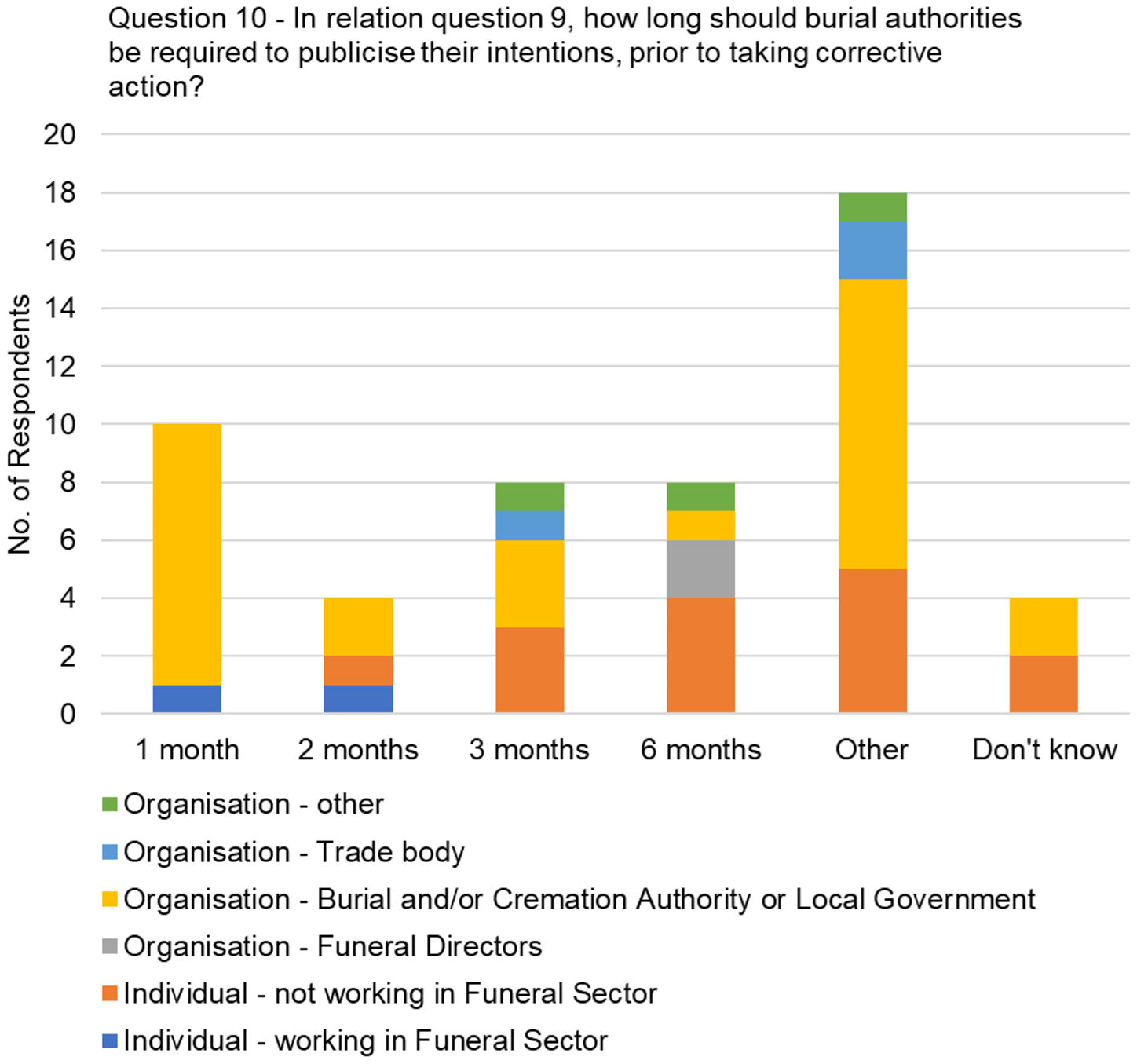
Qualitative data
Forty-two (42) respondents shared their reasons for the answer they had selected. Some comments were not specifically related to the question and made more general comments.
Question 10 asked a similar question to Question 8, this time focussing on situations where the lair holder is unknown. Similarly here although there were a range of selected timeframes, comments tended to focus on similar issues throughout. As before, respondents tended to frame their answers around striking a balance between safety and how feasible it would be to make contact with lair right-holders.
“3 months seems a reasonable length of time to balance the opportunity for people to find out about the proposal, prevent the stability of a stone from worsening, allow the BA to secure specialist heritage advice where necessary and limit the resource burden placed on the BA.” [Organisation response, ‘Other’ organisation type]
Several respondents, including those who had answered specific time frames, suggested a variable or flexible approach to this based on both risk assessment of the headstone/memorial and other considerations like the age of the lair and likelihood of being able to identify/contact the lair holder. Some suggested a variable approach but with an upper time limit. There were comments around how frequently families might visit lairs, with the possibility of only annual visits on anniversaries a reason for extending the time period closer to a year.
“1 months notice prior to inspections taking place when moving to a new cemetery. Advertise on line/website & at the cemetery the intention to commence inspections. However with regard to corrective action. Burial authorities should be able to take immediate action if the headstone requires urgent corrective action to make it safe by the means the burial authority advertises and is in their management plan. However as per previous comments memorials should be made temporarily safe and then a 12 month period before any additional measures may be taken to allow for families who we cannot be contacted (i.e. out of date information) to visit the cemetery and see the notice, if they only visit on special occasions.”
[Organisation response, burial authority]
As is also seen in the quote above, several respondents commented on the use of temporary measures to make safe a headstone/memorial to allow more time for the lair holder to be made aware.
“Circumstances may dictate different timescales. There needs to be a distinction between removing a risk from a dangerous memorial and having it repaired/ refixed. When an authority carries out a memorial inspection, it will identify those memorials that pose a risk because they are unsafe. The authority must remove that risk once it has been identified. This may be a temporary measure such as staking and banding a memorial. The lair holder should then be contacted and given options for having the memorial repaired and reinstated safely, with a time-limit for compliance after which the authority can take action” [Organisation response, trade body]
Some respondents representing burial authorities offered specific examples of their current process or experience.
“We try to publicise headstone inspections and stones which have failed inspections for at least three months before taking remedial action. In our experience if a lair is not being visited within that timescale then no-one is taking any responsibility for the stone and certainly unlikely to come forward.” [Organisation response, burial authority]
Question 11. Please provide any views you have in relation to headstones or other memorials requiring urgent attention. (para 42)
This question offered space for comments (qualitative data), without options to select from a predetermined list.
Qualitative data
Fifty-one (51) respondents provided comments. The majority of these were supportive of the proposals in paragraph 42 of the consultation that burial authorities should be able to take urgent action to make safe a headstone or memorial when there is immediate danger, prior to formal notification and consultation with lair right-holders. Some respondents detailed their own authority’s approach with some noting that obligations under health and safety legislation meant that they already had such a process in place in line with the proposals.
“Burial authorities should be permitted to make repairs required urgently without any special prior notice, and without prior consultation with the lair right-holders. Where the lair right-holder is known and contactable, it would be right to let them know that a repair has been undertaken after the event and, if time permits, even by affording them a short but realistic period of notice prior to corrective repairs being conducted. However, this right to short notice must never compromise on the safety of users of the burial ground and the burial authority has to be in a position of judging best whether short notice is practicable or safe, rather than proceeding with an urgent repair and notifying the lair right-holder afterwards.”
[Organisation response, burial authority]
There were some comments that focussed more specifically on only doing what is needed to make the area safe, rather than more significant remediation before contacting the lair holder.
“If there is risk to staff or the public, then action should be taken at the earliest opportunity, even if it is to make it safe or cordon the area off prior to notification/consultation with the lair right-holders. In this instance, the minimum work required to make the area safe should be undertaken, to allow the rights-holder to decide what happens next.” [Organisation response, trade body]
Similarly there were specific comments around the methods used to make safe a memorial or headstone, with some respondents feeling that laying stones flat should be a ‘last resort’. Some also noted that guidance on details like this was important, with this recorded in an authority’s management plan. Others voiced a need for specific guidance on more detailed aspects including timescales between any temporary action and longer term remediation.
“…the issue of large numbers of memorials either fenced off or laid flat for long periods of time is not addressed in the consultation. In the past councils have been criticised for doing this. Clear advice is required on what is acceptable for dealing with unstable memorials and time scale for leaving memorials fenced off or laying flat. What does a Council do if the owner refuses to make a dangerous memorial safe.” [Organisation response, local government]
Some respondents raised issues around the impact on heritage and nature that the work to make headstones and memorials safe could have, with particular regard to the designation status of that burial ground (e.g. Scheduled Monument).
“Urgent public health and safety clearly needs to be the overriding trigger to act but where there are also heritage interests (built and natural) these should shape the action taken. There should be very limited circumstances in practice where historic gravestones cannot be made safe in a manner which safeguards their heritage values.” [Organisation response, ‘Other’ organisation type]
Similarly, some respondents felt that part of this process should include recording (e.g. photographing) and documenting memorials and the actions taken in the process of making them safe. They also added that this information should then be made publicly available.
“Anything in urgent need of repair or making safe should be carefully documented in writing and in photographs, with this documentation made freely available online. All inscriptions must be carefully recorded. All parts or fragments must be kept and retained together, stabilised or if necessary laid down or buried in situ. The location must be carefully, accurately, and precisely recorded, and this information made freely available, both online and publicly displayed on site.”
[Individual, not working in the funeral sector]
Although the majority of responses voiced agreement that safety should be the main priority, many also mentioned the importance of contacting the lair right- holder. Some gave further reasoning that contacting lair right-holders could help with cost recovery and longer term remediation. One respondent had the alternative view that contacting lair right-holders in this circumstance was not necessary, and created administrative burden for authorities. In addition to contacting the lair right-holder, some respondents noted that general notices of inspection rounds could also help raise awareness in advance.
“…if urgent attention is required then the notice periods should be waived and the making safe work carried out as soon ass [sic] possible. Afterwards every attempt should be made to let the lair holder know explaing [sic] the reasons why the work was urgent”
[Individual, working in funeral sector]
Question 12. Please provide any comments you have on the proposed training requirements and the keeping of training records for burial authority staff. (para 47 - 49)
This question offered space for comments (qualitative data), without options to select from a predetermined list.
Qualitative data
Forty-six (46) respondents made comments. The majority of these were supportive of the proposals in paragraphs 47- 49 of the consultation that regulations will not specify the education and training requirements for burial authority staff, but that each burial authority is required to maintain an up-to-date record of all training undertaken by staff.
“We agree that staff should receive adequate instruction, supervision and training in the use of any equipment and burial ground processes, an up-to-date record should be maintained of all training undertaken by staff.” [Organisation response, burial authority]
“I support the proposals that within the regulations there is a requirement to keep records and that training requirements be set out within a future code of practice of burial. As mentioned the records will assist the inspector when assessing the authority” [Individual response, funeral director business]
A number of others, in addition to stating general support, made comments noting the positive impacts they perceived as a result of training, e.g. improved experience of service users, or more generally supportive of this as part of “good practice”.
Some comments were not specifically related to the question and made more general comments. A small number of respondents may have misconstrued the proposals. In particular, some expressed views which suggested that the level of training and education of burial authority staff was being regulated.
“There are currently no appropriate qualifications, training or CPD for office staff or the management of a privately operated natural burial ground….. If this is to be regulated, then the relevance and quality of training and qualifications will need to step up.” [Organisation response, burial authority]
For clarity, the consultation noted that it is not intended that regulations will specify the level of education and training requirements for burial authority staff.
Some respondents made more extensive comments and these either tended to focus on additional training needs or current practice, regardless of the level of support the respondent showed for the proposals. Around a quarter of responses were less clearly supportive but did not necessarily oppose the proposals. These tended to have more detailed comments and these are considered below.
Additional training
Some respondents suggested areas where specific additional training may be required, for example:
- nature conservation, historic environment and archaeological training.
- training on archiving and record keeping practices (especially around recording historic headstone information and on headstones which have been laid flat)
- training and detailed guidance on making safe, repairing and resetting historic headstones
Some of these respondents also noted the need to work with partners, such as Historic Environment Scotland (HES) to provide appropriate training. These comments are well noted and will be considered further as the burial code of practice or relevant guidance is developed to complement regulations.
Resource implications
Two (2) respondents, whilst agreeing with the proposals, highlighted that training within small or volunteer run burial authorities is often informal in-house or ‘on the job’ training and therefore not always possible or easy to formally record. One (1) respondent in particular, also expressed resource concerns.
“We agree that it would not be appropriate for education and training requirements to be set out in regulations. Furthermore, any guidance issued by Scottish Ministers should not stipulate certified training programmes but must allow for in-house training, the more especially in the case of small volunteer-run burial authorities that do not have the resources to pay for training courses for their volunteers and part-time staff – and it would also not be appropriate to expect these to cover the cost of training courses themselves.” [Organisation response, faith based]
Current practice
Several of the local authority burial authorities stated that the proposals are in keeping with their current practice. One (1) made specific note that there should be no particular standard format of documenting and reporting training as this is already done by the local authority.
“Training requirements and the keeping of training records for all staff is a function of all local authorities. The council suggest that councils (as a burial authority) are not required to complete any additional/duplicate reporting or create any new unique format of records to Scottish Government on training, but can show Inspectors existing training records if required.” [Organisation response, local government]
Suggestion for regulations to go further
One (1) respondent expressed views that the Scottish Government did not go far enough in the proposals around education and training.
“There seems a disconnect here where many cemeteries require levels of education and training for outside agencies that they do not meet themselves. This stance seems very archaic in a society demanding qualifications and ongoing training increasingly.
I'm not sure why there seems a reluctance to include education requirements in all these current consultations.” [Organisation response, funeral director business]
Question 13. Please share your views on the designation of parts of a burial ground for different faiths. (para 50)
This question offered space for comments (qualitative data), without options to select from a predetermined list.
Qualitative data
Forty-seven (47) respondents provided comments in relation to areas designated for particular faiths in burial grounds. The majority indicated clear support for the proposals, with many simply stating their agreement or reiterating the points in the consultation without further elaboration. A few supportive comments offered more substantial reasons for their agreement. For example, some of the respondents representing burial authorities shared the view that the position set out in the consultation reflects current practice and welcomed it being formalised on a legal basis.
Several responses acknowledged the varying needs across different burial authorities in different areas of Scotland and welcomed the proposal that individual burial authorities would have the discretion to determine for themselves how to action this.
“The proposal appears proportionate as not all faith groups are represented in the vicinity of all the multitude of cemeteries across Scotland. However where they are it is extremely important they are adequately catered for.” [Organisation response, funeral director business]
There were some comments by respondents that offered some support but also raised concerns over limited space, or difficulties offering a range of appropriate options for their individual authority.
“As a burial authority we have a few designated faith areas within the cemeteries. It is important that this is not a duty as having sufficient available space to accommodate all requests could be very difficult. It may be a fine line between requirement and ability due to available burial space.” [Organisation response, burial authority]
However, since the consultation proposal was that the power should be granted to individual burial authorities, these issues would be able to be considered by individual authority’s themselves under that proposal.
Six (6) respondents disagreed with the proposal. The most frequent reason given in opposition was on the basis that there should be no segregation or positive discrimination. However, some of these comments were made without elaborating on the importance of accommodating different burial norms and minority groups' practices.
1.3 Burial application and register
Question 14. Please share your view on the proposed information to be collected in the burial application forms. (Para 53)
This question asked respondents to select as many options as they wanted from a list of predetermined options (quantitative data), and in addition allowed a free text box for further comments (qualitative data).
Quantitative data
Forty-five (45) of the 59 respondents answered this question. The most frequent response (n=26) was “It looks right”. Since respondents could select more than one option there was a total of 49 choices made, with 4 respondents selecting more than one option. These four respondents selected options that highlighted issues with the proposed list (i.e. ‘it does not look right’, ‘Some of this is unnecessary information’, ‘There is some information missing’ and ‘Not sure’).
Table 10 and Figure 9 (below) show the number of respondents who selected each option [NB. Respondents could select more than one option].
| Question 14 Please share your view on the proposed information to be collected in the burial application forms. (Para 53) | No. of Responses |
|---|---|
| It looks right | 26 |
| It does not look right | 9 |
| Some of this is unnecessary information | 5 |
| There is some information missing | 7 |
| Not Sure | 2 |
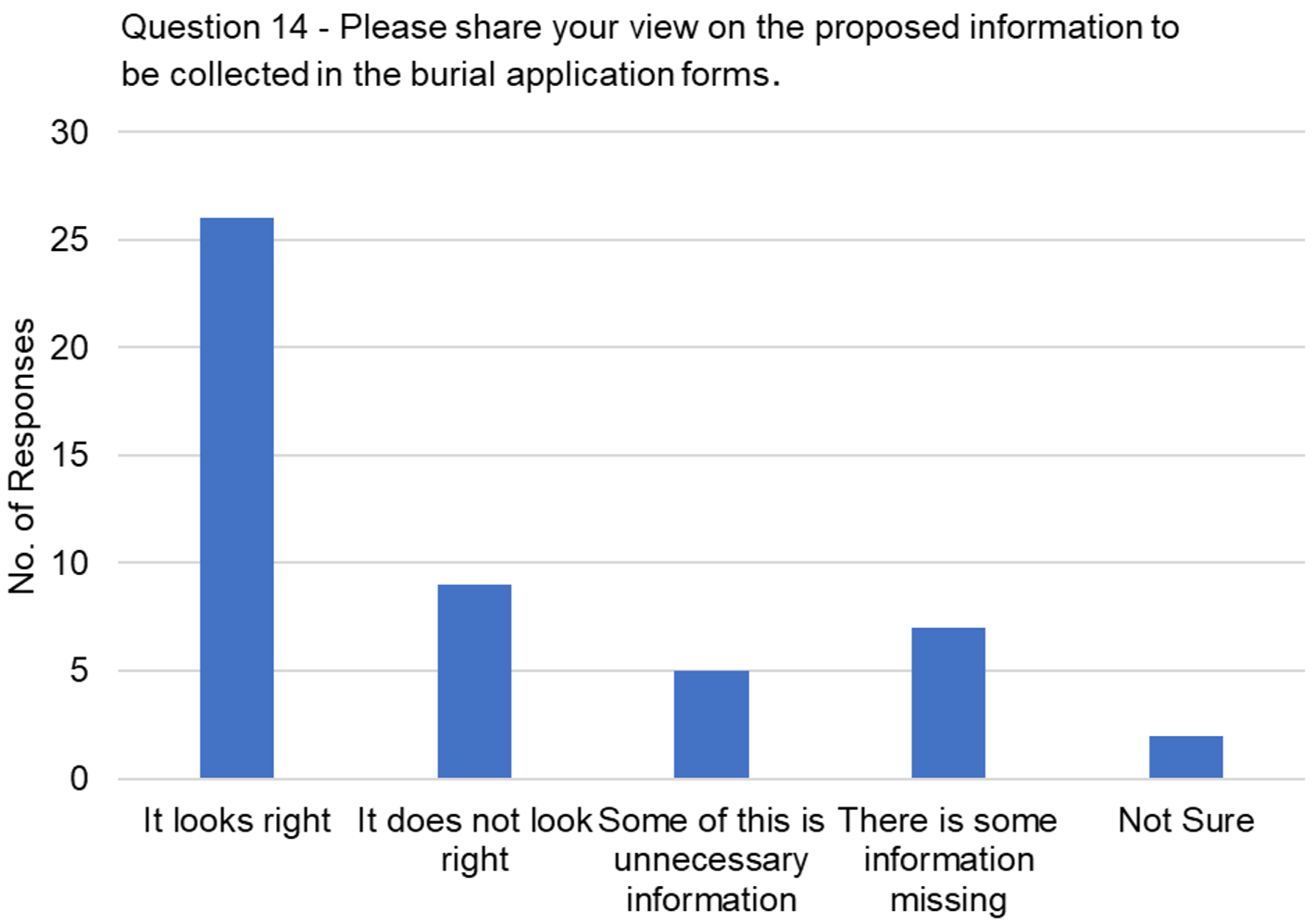
Qualitative data
Forty-two (42) of the respondents provided comments. Around half stated their clear support for the proposed content of the burial application forms. A few supportive comments offered more substantial reasons for their agreement and these focussed on the respondents’ views that the content was thorough, relevant, necessary, clear and comprehensive.
“This provision looks right. A standardisation and simplification of this process across all 32 local authorities is welcome and overdue to reduce the ad hoc and outdated procedures that have developed over the past 30 years.” [Organisation response, third sector]
Around half of respondents, who were still generally supportive of the burial application form content, made additional comments. These views are summarised below.
There is some information missing
Some respondents were of the view that some information was missing from the proposed information to be collected in the burial application forms. The most frequent suggestion was the need for more information around the shape of the coffin, the materials it is made from and the type of handles.
Some respondents were of the view that a declaration of the entitlement to open the lair should be included on the form as well as clarity around the transfer of the right of burial where the lair right-holder is deceased.
Other suggested additions included:
- whether the deceased is embalmed (sometimes required for natural/ woodland burials)
- the age of the deceased
- a ‘division’ as well as the lair number and section of the burial ground
- a note to the applicant about the potential disturbance of a previous ashes internment, where applicable.
- number of funeral director staff attending the burial service
- whether ceremonial cords will be used
- the day, date and time of the burial service and estimated arrival time
- a question about local connection
- account details for payment
Only some of the information is necessary
A minority of respondents were of the view that some of the information listed was either not necessary or not appropriate. Some responses commented that for natural/ green burials the weight of the deceased is not required, although it is recognised for many burial authorities this can assist with planning and staff resource.
One (1) respondent queried the need to record religion. This is only proposed to be included in the burial application form for local authority arranged burials (i.e. where no-one else is making the arrangements). Local authorities have a duty under section 87 of the 2016 Act to have regard to whether the person was of a particular religion or belief.
The following specific suggestions were made for removal from the application form:
- Unique identification number for pregnancy loss
- Information on ‘father/ other parent’ in the burial application form for pregnancy loss and stillborn baby
- Sex of stillborn baby
Views in opposition of a standardised, statutory form
A small minority of respondents expressed concerns about standardised burial application forms and their incompatibility with existing digital platforms.
“We have invested a lot of time and money into developing an online application process, which is much more efficient than a paper form….. The requirement to use a standard form is going to be a backward step.” [Organisation response, burial authority]
One (1) respondent commented on the need for flexibility.
“Not sure that a statutory burial form is required, due to the complexities and differences between sites. Perhaps some standard information could be specified, but with the option to adapt the form to suit local needs” [Organisation response, trade body]
Number of forms
Four (4) respondents commented on the number of forms, expressing the view that one single form would be preferable to 7 individual forms.
The remaining respondents did not share a view on the number of application forms, however, one respondent did welcome the alignment between the burial forms and the cremation forms, of which there are currently seven.
“When working in the service, the cremation paperwork was never any issue, as this needed to be 100% completed correctly otherwise Cremation would not go ahead. The burial paperwork however was not always filled out with the same level of care, and a lot of time was sued chasing Funeral Directors/ Families to correct this. By making both applications the same, this should prevent a discrepancy between how they are filled out.” [Individual response, not working in funeral sector]
Faith concerns
Two (2) respondents highlighted the difficulty of using a standardised burial application. These comments were made in the context of faiths which require the burial to takes place as soon after death as possible and for which arrangements are currently made over the phone to prevent delays.
“Burial application forms such as are proposed are entirely inappropriate for Jewish funerals. As has already been stated, the burial takes place as soon after death as possible, often on the same day. In order to expedite matters, all arrangements are made by telephone; much of the proposed information is unavailable at that time, and requiring it to be provided in advance of the funeral would cause delays that would be extremely distressing to the bereaved. Furthermore, once the bereaved have stated that they want a Jewish funeral, the care of the deceased, the coffin, and the burial procedure are all standard – there are no detailed choices to be made. Burial applications should not, therefore, be mandatory.” [Organisation response, faith based organisation]
Question 15. Please indicate if you think anything may be missing from the proposed accompanying documentation list, or should be removed from it. (para 54-55)
This question offered space for comments (qualitative data), without options to select from a predetermined list. Thirty-six (36) respondents commented on the question. These have been summarised under two headings.
Qualitative data 1 – Please indicate if you think anything may be missing from the proposed list of accompanying documentation and please explain your reasoning.
The vast majority of respondents agreed with the proposed list of accompanying documentation and did not think anything was missing. Answers tended to be short and simply indicated the respondent was content with the list, without further comment.
Of those who made more extensive comments, the most frequent suggestion was to formalise and standardise the transfer of the right of burial, for example, by use of indemnity forms and statutory declarations. One (1) respondent asked a specific question around what regulations would be required for an exhumed deceased moved from a lair elsewhere. Another respondent suggested that a lair certificate should be required, even for body parts after post-mortem or anatomical examination, if the burial is to be in an existing lair.
Two respondents (2), in relation to the application for burial of pregnancy loss by a health authority, highlighted the need for a medical certificate of pregnancy loss or a health authority/medical practitioner confirmation that the pregnancy has ended.
Qualitative data 2 - Please indicate if you think anything should be removed from the proposed list of accompanying documentation and please explain your reasoning
As above, answer tended to simply agree with the proposed list of accompanying documentation, without elaborating further. Of those who did add more extensive comments, these have been summarised below.
Theme 1 – Lair certificate
The most common area of concern, expressed mainly by burial authority respondents, was around the lair certificate. In particular, a number of respondents did not think the lair certificate should be a requirement of regulations as these are sometimes lost or mislaid by families over time and this could lead to delays for burials. Some burial authorities currently ask applicants to sign an indemnity where the lair certificate cannot be found. One respondent, representing a burial authority, explained that lair certificates were not routinely issued until recently. Another added:
“I feel having to produce a lair certificate could cause issues. If our records agree with the application there should be no issue in the burial taking place. If there is a difference a lair certificate could be produced to prove who is the correct lair holder. Again if lair certificate is required it could hold up the burial as a duplicate lair certificate would need to be produced and only the lair holder can apply for that meaning a lair transfer would need to be facilatated [sic] prior to the burial causing families further distress at a difficult time.” [Organisation response, burial authority]
One (1) respondent highlighted that there should be a clear explanation that a lair certificate is only required if the rights to the lair have already been purchased in advance, not for families who are purchasing a lair at the time of need.
Theme 2 – Body parts
In relation to the burial of body parts following post-mortem or anatomical examination, one respondent queried the requirement for a Form 14 (Certificate of Registration of Death), as one would already have been submitted at the time of the burial or cremation of the body itself (if carried out by the same authority). For cremation, a Form 14 is required to accompany the application.
Question 16. Do you think that an application for the burial of ashes in a burial ground should be accompanied by a cremation certificate, where available? (para 57)
This question asked respondents to select one option from a list of predetermined options (quantitative data), and in addition allowed a free text box for further comments (qualitative data).
Quantitative data
Forty-five (45) of the 59 respondents answered this question. A majority (n=39, 87%) of respondents answered ‘Yes’, that an application for the burial of ashes in a burial ground should be accompanied by a cremation certificate, where available.
Table 11 and Figure 10 (below) show the responses broken down by respondent type (individual or organisational response, and whether, or not, respondents were part of the funeral sector).
| Respondent Type | No. of Responses (Q16) | ||
|---|---|---|---|
| Yes | No | Not Sure | |
| Individual - working in funeral sector | 2 | 0 | 0 |
| Individual - not working in funeral sector | 9 | 2 | 1 |
| Organisation - funeral directors | 2 | 0 | 0 |
| Organisation - burial and/or cremation authority or local government | 22 | 1 | 1 |
| Organisation - trade body | 3 | 0 | 0 |
| Organisation – other | 1 | 0 | 1 |
| All respondents | 39 | 3 | 3 |
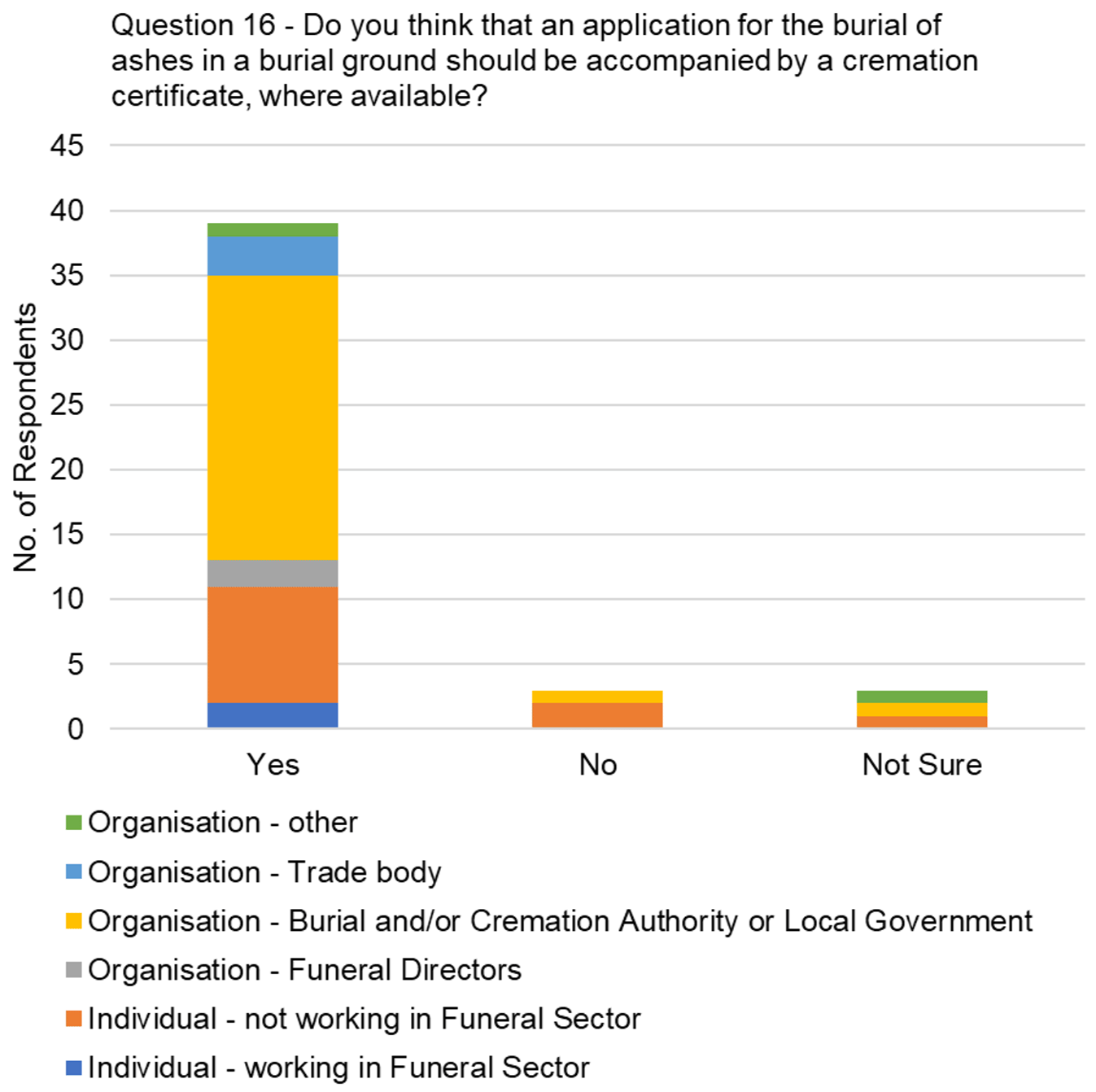
Qualitative data
Thirty-eight (38) respondents gave reasons for the answers they chose. Of the respondents who answered ‘yes’, the most frequent reason given was around identifying the ashes and ensuring that the ashes being presented for burial are of the person being recorded in the register.
“Confirmation of identification and place of cremation will provide protection for staff and operators regards what they are interring, reassurance to grieving families, and confidence to members of the public.” [Organisation response, trade body for funeral directors]
Connected to this, some respondents added that requiring a cremation certificate could help avoid abuse of the system, i.e. prevent a person using something claimed to be ashes as a route to pre-purchase a lair, where this may otherwise be restricted.
Other comments centred on the need to ensure the death was appropriately registered and the cremation was legitimate (although another respondent stated that a Form 14 would have been required for the cremation, and so did not consider the cremation certificate to be essential). Some respondents highlighted that the possession of a cremation certificate does not confirm the contents of the ashes, only confirmation that a cremation took place. Another respondent shared similar views, but still considered the benefits of requiring a cremation certificate:
“Without entering into too much detail it is impossible to determine whether the ashes within the casket are as described however an accompanying cremation certificate gives some comfort we are interring the remains as certified.” [Organisation response, burial authority]
A minority of respondents questioned what the rationale was and whether this was substantial enough to potentially risk distress to families caused by having to source the cremation certificate. Comments tended to point to the possibility that ashes might have been held on to by someone for a long time and that a cremation certificate may not be available, or the death may have happened overseas and the paperwork is unavailable.
There were contradictory views from two authorities whose experiences suggested that one had not had anyone have difficulty presenting a cremation certificate, and the other had experienced this. Some respondents suggested alternatives, and this is discussed in the next question.
Question 17. Where a cremation certificate is not available, and it is not possible to obtain a copy, do you think that an applicant should be able to submit one of the following instead (para 56 - 57):
- an extract copy of the cremation register entry or;
- a Certificate of Registration of Death (Form 14) or equivalent or;
- an abbreviated copy of the full death entry made in The Statutory Register of Deaths.
This question asked respondents to select one option from a list of predetermined options (quantitative data), and in addition allowed a free text box for further comments (qualitative data).
Quantitative data
Forty-four (44) of the 59 respondents answered this question. A majority (n=34, 77%) of respondents answered ‘Yes’ that the named alternatives (see above) were acceptable as evidence in place of a cremation certificate in circumstances where a certificate is not available and an application for burial of ashes in a burial ground is being made.
Table 12 and Figure 11 (below) show the responses broken down by respondent type (individual or organisational response, and whether, or not, respondents were part of the funeral sector).
| Respondent Type | No. of Responses (Q17) | ||
|---|---|---|---|
| Yes | No | Not Sure | |
| Individual - working in funeral sector | 2 | 0 | 0 |
| Individual - not working in funeral sector | 10 | 1 | 0 |
| Organisation - funeral directors | 1 | 1 | 0 |
| Organisation - burial and/or cremation authority or local government | 17 | 4 | 3 |
| Organisation - trade body | 3 | 0 | 0 |
| Organisation – other | 1 | 0 | 1 |
| All respondents | 34 | 6 | 4 |
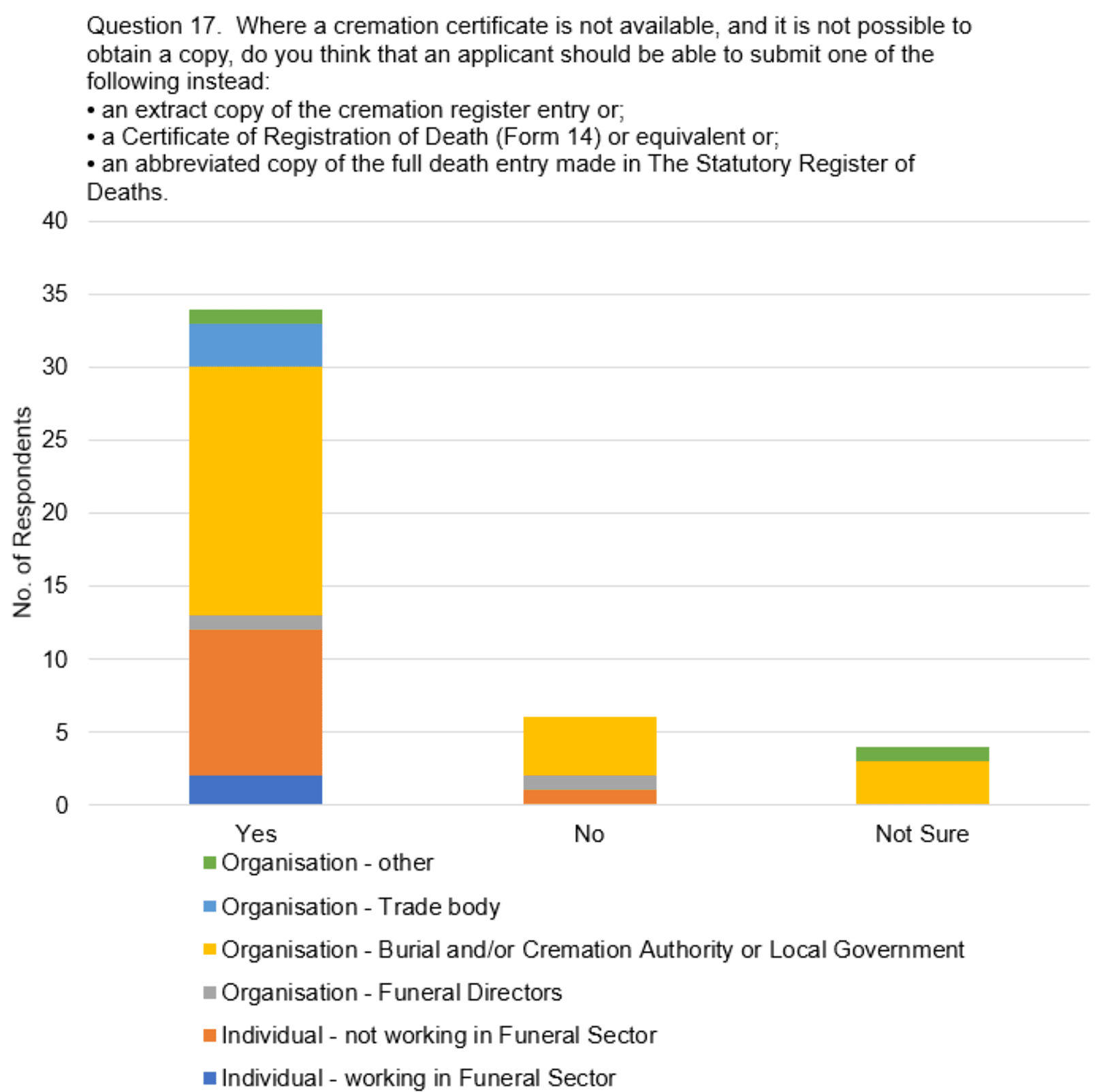
Qualitative data
Thirty-four (34) respondents gave reasons for their answer. Some of these simply restated the rationale given in the previous question. Around a third of those who answered ‘yes’ felt that only the “extract copy of the cremation register entry” should be accepted and not the other two options given. The reason given for this was that this was the only evidence that confirmed a cremation had taken place.
Alternatives or additions included:
- An email or letter of comfort from the crematorium
- That any evidence should also be “notarised by an appropriate official”
- Internal sharing of cremation register information where the cremation and burial authority are a part of the same local authority
- That these should only be accepted for older ashes, and not any after the regulations come into force, for which a cremation certificate should be required
- That an alternative process would need to be considered for ashes from cremations in another country.
A small minority of respondents did not feel that these substitute documents would be necessary and that copies of the cremation certificate could be readily obtained, but this was countered by one respondent whose experience was that this could be difficult. One (1) respondent, as answered similarly in question 16, felt that a declaration by an applicant on the application form would suffice without the need for a cremation certificate at all.
Question 18. Please share your view on the proposed information to be collected in the burial register entries. (para 58 - 59)
This question asked respondents to select as many options as they wanted from a list of predetermined options (quantitative data), and in addition allowed a free text box for further comments (qualitative data).
Quantitative data
Forty-five (45) of the 59 respondents answered this question. The most frequent response (n=31) was “It looks right”. Since respondents could select more than one option there was a total of 46 choices made, with only one respondent selecting more than one option, selecting both ‘Some of this is unnecessary’ and ‘Not sure’.
Table 13 and Figure 12 (below) show the number of respondents who selected each option [NB. Respondents could select more than one option].
| Question 18 Please share your view on the proposed information to be collected in the burial register entries. (para 59) | No. of Responses |
|---|---|
| It looks right | 31 |
| It does not look right | 3 |
| Some of this is unnecessary information | 3 |
| There is some information missing | 6 |
| Not sure | 3 |
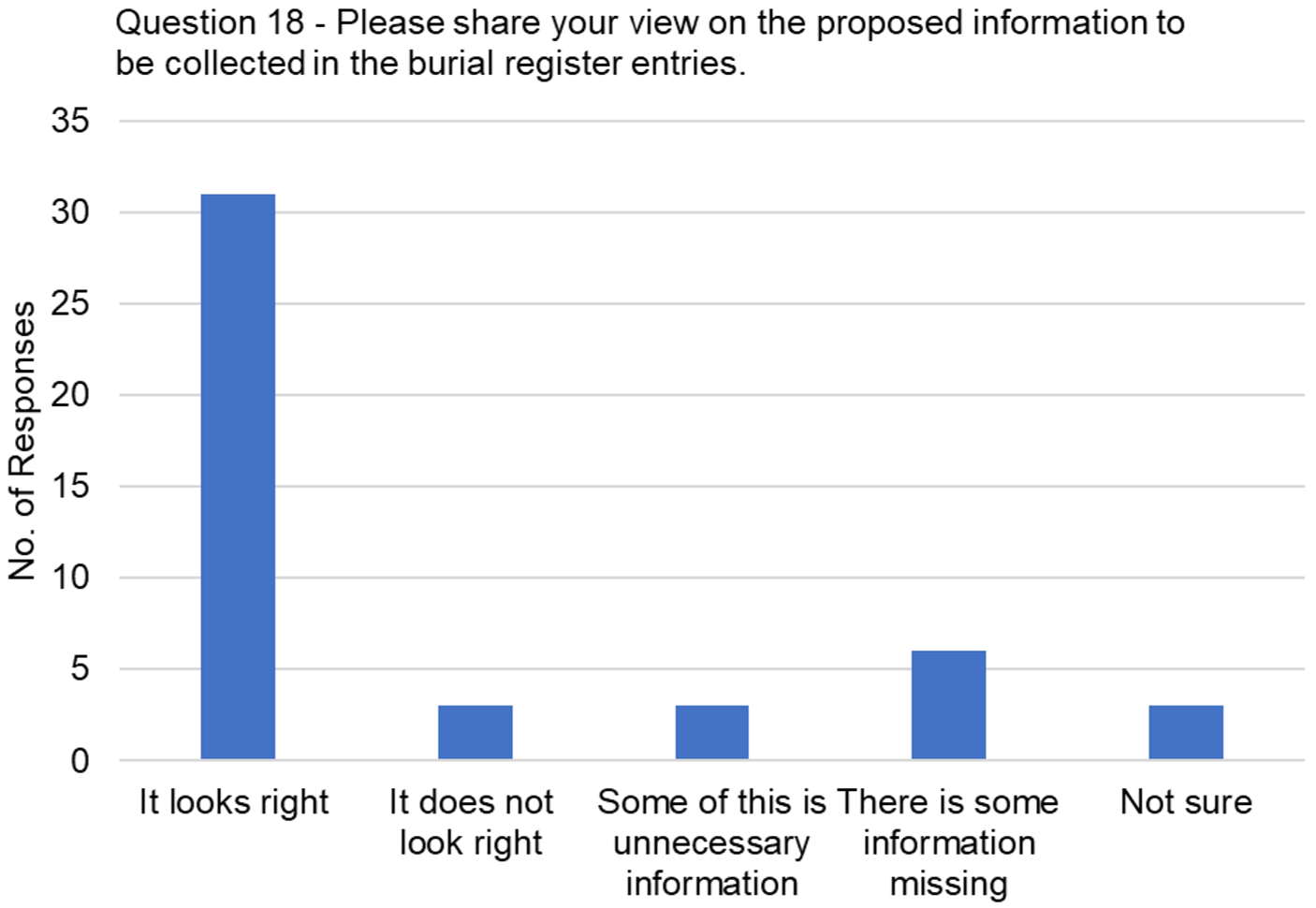
Qualitative data
Respondents were asked to give reasons for their answers and 32 provided comment here. Almost half of respondents simply agreed with the proposed content, with a few adding that the information is similar to what is already collected by burial authorities.
Just over half of respondents, many of whom were still generally supportive of the proposed register content, but somewhat more reserved in their support, provided comments and suggestions for consideration. This included:
- Ensuring that the application form and the register matched in terms of the information they collect
- Second parent on stillborn baby register should be optional
- That the external measurements of the coffin should include handles
- Style and component materials of coffin/casket
- Name as inscribed upon nameplate if different and known by a different name
- Ground conditions at time of interment and reportable factors (e.g. side wall collapse or adjoining grave exposed, drain broken or exposed, subsidence to memorial foundations or pathway/road, etc.)
- Descriptions of markers and memorial monuments, together with inscription
- Coffin/ casket sizes should also be required for stillborn babies/pregnancy loss/body parts.
- Whether the lair is full and whether the lair is intended for more than one person
One (1) respondent felt that the terms ‘applicant’ and ‘Lair Right-Holder’ required clarification.
“To avoid confusion, the terms: Applicant and Lair Right-Holder need to be clearly defined. For example, when Mr X pre-purchases a Right of Burial for a single-depth lair, he is both the Applicant and the Lair Right-Holder. Once Mr X dies and is buried in the lair, who is the Lair Right-Holder?” [Organisation response, burial authority]
Two (2) respondents raised concerns in relation to data protection and anonymity – one in terms of recording an applicant’s details and another in relation to a pregnancy loss where it was suggested a case number could be used rather than a name.
1.4 Private burial
Question 19. What is your view on the proposed list of organisations that an applicant should engage with to ensure they are complying with local requirements? (para 66-68)
This question asked respondents to select as many options as they wanted from a list of predetermined options (quantitative data), and in addition allowed a free text box for further comments (qualitative data).
Quantitative data
Forty-four (44) of the 59 respondents answered this question. The most frequent response (n=28) was “It looks right”. Although respondents could select more than one option, no one did and there was a total of 44 responses, each from a different respondent.
Table 14 and Figure 13 (below) show the number of respondents who selected each option.
| Question 19 What is your view on the proposed list of organisations that an applicant should engage with to ensure they are complying with local requirements? (para 68) | No. of Responses |
|---|---|
| The list is complete | 28 |
| The list is missing some organisations | 7 |
| The list contains unnecessary organisations | 2 |
| Not sure | 7 |
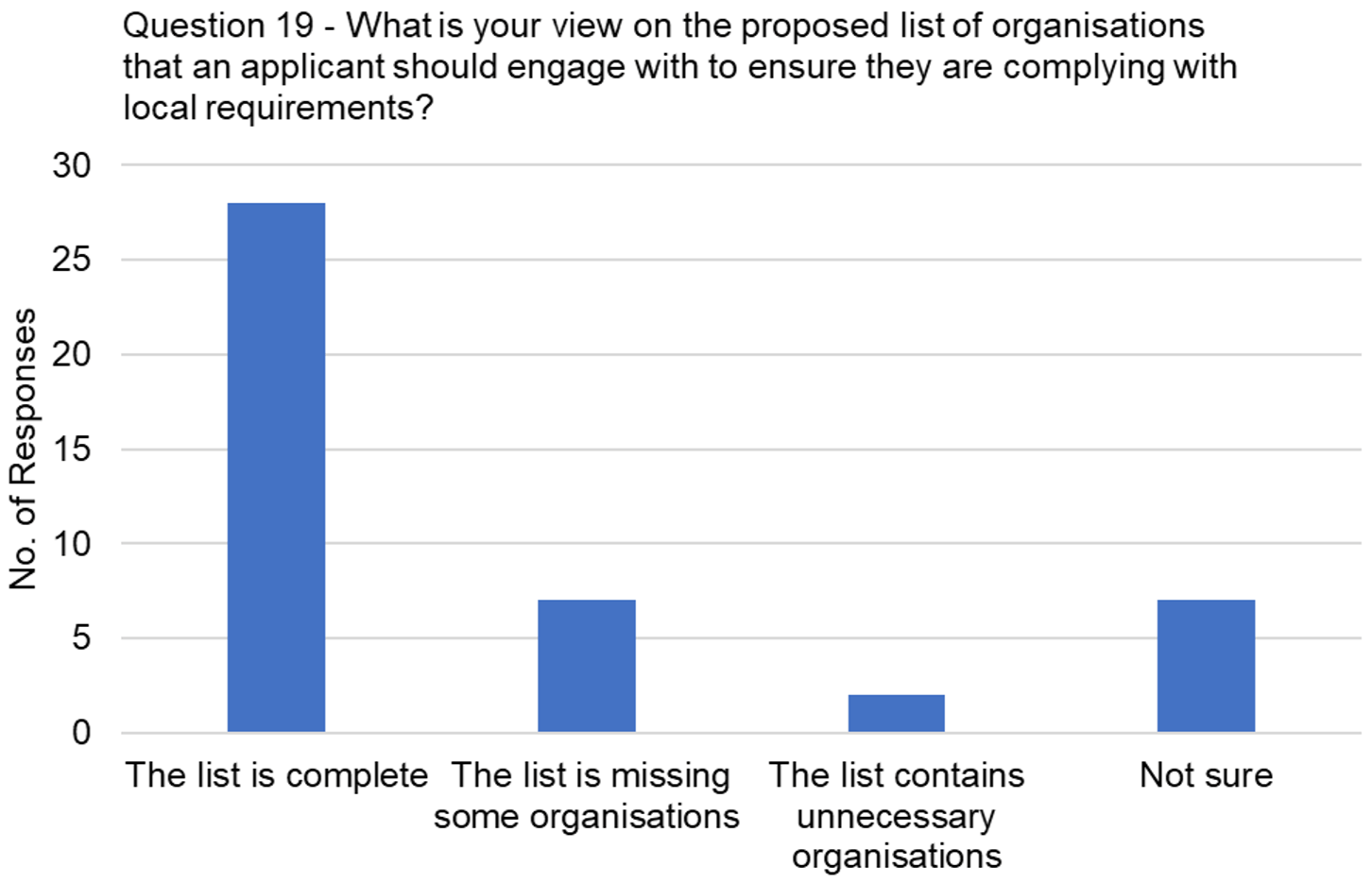
Qualitative data
Respondents were asked to give reasons for their answers and 28 provided comments. Over one third of respondents simply noted their agreement that all relevant organisations had been identified, without further comment.
A number of other respondents were also supportive of the proposals but elaborated further. An example of this was the strong support for the inclusion of archaeological assessment, but with a suggested change to wording to reflect the respective roles of local authority archaeologists and HES.
Some respondents raised concerns that they had with the proposals or with issues they felt were pertinent to consider or clarify in developing this proposal further. These views are summarised.
Theme 1 – Time consuming
Two (2) respondents considered that the list of organisations was long, the process would be time-consuming and it could delay burials.
Theme 2 – Minimal risk
One (1) respondent expressed the view that private burials pose minimum risk, unless a hazard is included on the Certificate of Registration of Death – Form 14, and noted methods available to mitigate risks.
Theme 3 – Not always relevant
One (1) respondent considered it essential to be able to exclude some organisations on a case by case basis where their interests are not relevant.
Theme 4 – Other parties
Respondents mentioned other areas of relevance and interest, for example, one respondent thought the private burial could be included on the Land Register for transparency around property sales. Another queried whether neighbours should be entitled to object to a private burial. Others recommended the inclusion of natural environment concerns (e.g. NatureScot).
Some respondents did not answer the question directly but used this space to voice opinions on private burial in general. These views are valued and are summarised here:
Theme 5 – Local authority role
Although not directly answering the question, a small minority of respondents commented on the role of the local authority. Some felt that one application should be made to the local authority, with the local authority then responsible for forwarding to the relevant agencies.
“This application will be made by a grieving family. I think that a single application should be made possible, online, addressed to the local authority, who should automatically forward the details to:
- The Scottish Environmental Protection Agency
- Scottish Water
- Distribution Network Operators
- The local authority environmental health department
- The local authority archaeology services or Historic Environment Scotland
- The local authority planning department
for screening and reporting back to the local authority coordinator.
The applicant should provide the local authority with confirmation of consent from the owner of the land and any standard security holder.
A single standard fee should be charged by the local authority which should include any charges made by the other agencies.” [Organisation response, burial authority]
One (1) respondent queried which local authority department would be responsible for approving applications. Another considered that it should be the role of planning officers.
“Within private ground outwith local authority burial grounds - Planning Officers must provide feasibility (through structural engineers) to the applicant to determine suitability of location and achievable depth.
Burial authorities should only be informed once a third party agency has reviewed the application and given authority for the interment to take place. Burial authorities should only have responsibility to record the burial within their registers.” [Organisation response, burial authority]
Theme 6 – Ownership
Another respondent noted that the land should be owned outright and not subject to a standard security.
Some respondents made suggestions which are more relevant to the following questions and are therefore considered under those.
Question 20. Do you think an applicant should be required to submit evidence, alongside the application, to demonstrate that the proposed burial site is in line with third party agency and local authority rules and guidelines? (para 66-68)
This question asked respondents to select one option from a list of predetermined options (quantitative data), and in addition allowed a free text box for further comments (qualitative data).
Quantitative data
Forty-four (44) of the 59 respondents answered this question. A majority (n=36, 82%) of respondents answered ‘Yes’ that an applicant should be required to submit evidence, alongside the application, to demonstrate that the proposed burial site is in line with third party agency and local authority rules and guidelines.
Table 15 and Figure 14 (below) show the responses broken down by respondent type (individual or organisational response, and whether, or not, respondents were part of the funeral sector).
| Respondent Type | No. of Responses (Q20) | ||
|---|---|---|---|
| Yes | No | Not Sure | |
| Individual - working in funeral sector | 2 | 0 | 0 |
| Individual - not working in funeral sector | 9 | 0 | 1 |
| Organisation - funeral directors | 0 | 2 | 0 |
| Organisation - burial and/or cremation authority or local government | 22 | 0 | 4 |
| Organisation - trade body | 2 | 0 | 1 |
| Organisation - other | 1 | 0 | 0 |
| All respondents | 36 | 2 | 6 |
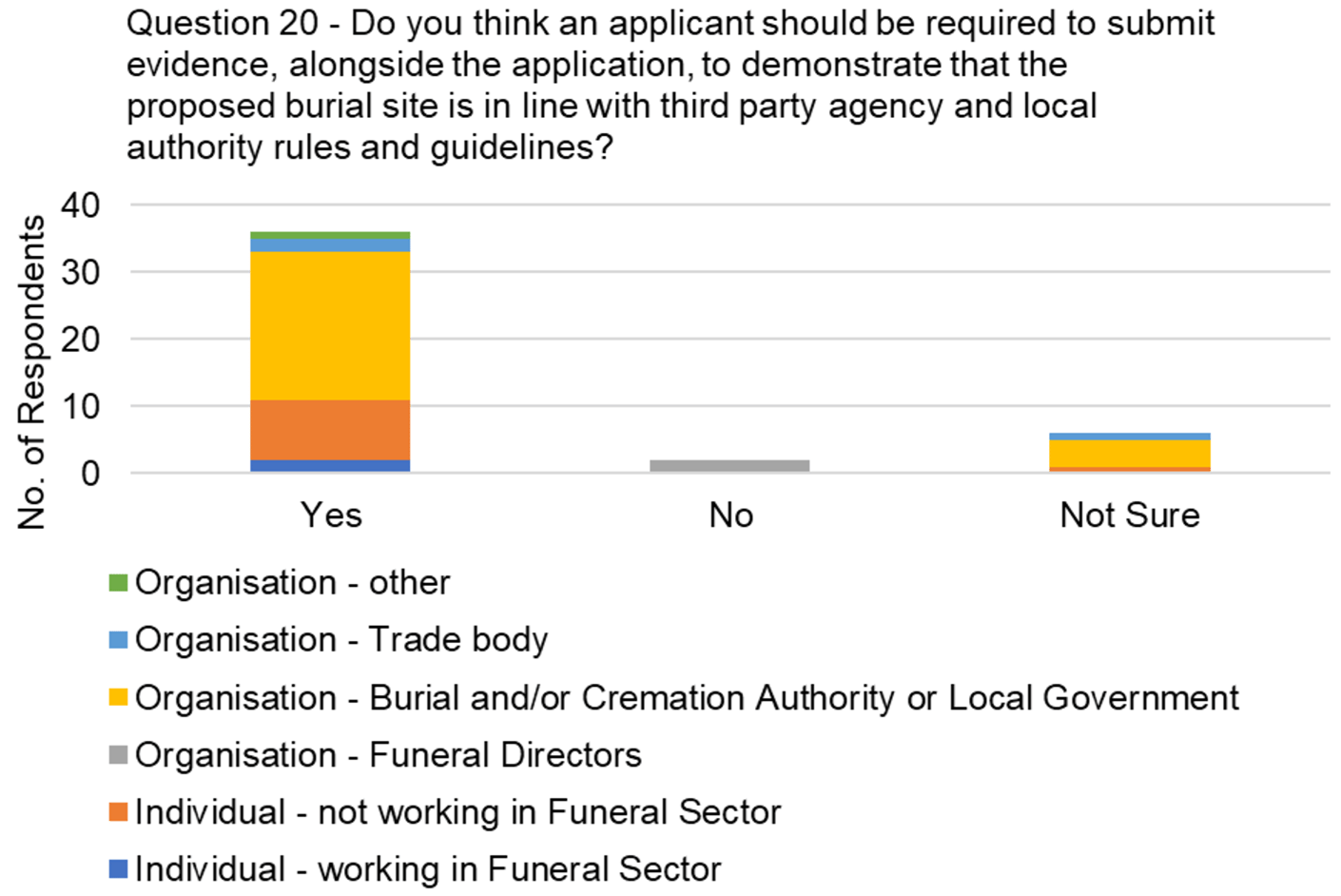
Qualitative data
Thirty-five (35) respondents provided additional comments on whether an applicant should be required to submit evidence. Most responses from those answering ‘Yes’ centred on the need for this step in order to evidence compliance with the previous steps (consulting agencies) and in order for the local authority to make a fully informed decision about the application.
Across the response types (Yes/No/Not Sure) there were several comments about the potential burden that this might have where applicants are recently bereaved. A lengthy process, relying on responses and actions from other agencies and requiring a good understanding of what was required, was thought by some to be overly burdensome on applicants during a period of grieving.
“This is a tricky one. Yes in as much as the applicant needs to understand all aspects of the external environment and should be in possession of all relevant information before submitting an application, so not as to waste a burial authority’s time.
However, an application at need is made during a difficult time. Having to find this level of information and potentially have to deal with multiple agencies as a non-professional could be a lengthy and stressful business, which would inevitably delay the funeral. Any evidence, for or against the application, would come to light in the subsequent feasibility study carried out by a professional or of the local knowledge of, say, the funeral director.” [Organisation response, trade body for funeral directors]
There were some respondents who suggested an alternative might be to have a funeral industry professional (e.g. funeral director or burial authority) act on the behalf of bereaved making such an application.
Other comments included that:
- more information about the proposed application process was needed, including how sites should be recorded.
- the process proposed should ensure local authorities are not held liable for any issues related to the private burial.
- the applicant should submit test hole details to confirm adequate soil depths and absence of groundwater
Question 21. What is your view on the proposed information to be collected in the private burial application form? (para 69 - 71)
This question offered space for comments (qualitative data), without options to select from a predetermined list.
Qualitative data
Thirty-nine (39) respondents provided views. Most of these were short comments noting agreement with the proposed list and a few reiterated points they had made in previous questions. Around one third of respondents suggested specific changes, including:
- Addition of: age of deceased, date and time of burial, whether the body has been embalmed, a named person responsible for maintenance of the site
- Removal of: funeral director details
- opposing opinions from some respondents around the inclusion of coffin details. Some suggested adding more details on coffin (e.g. type, construction, shape) and others suggested no details on coffin should need to be included at all.
- Several respondents (5 local authorities) did not agree with the responsibility being placed on local authorities to assess the feasibility of achievable depth unless they were responsible for the excavation of the lair. Instead, one suggested “a ground investigation report that details ground condition, service check and achievable depth” should be included in evidence presented by the applicant.
- In response to question 27 on the private burial register, one respondent thought that the organisation carrying out the burial, if different to the local authority, should be included on the application and that there should be a requirement for the applicant to advise the burial authority when the burial has taken place.
A few respondents used this space to voice broader concerns with the assessment of private burial. For example, one respondent highlighted the difficulty of obtaining landowner consent where the landowner is the deceased and the estate is not settled. A respondent representing a local authority burial authority thought there should be clarity around the responsibility for ongoing maintenance, repair and the potential for reburial if the remains were disturbed. This same respondent highlighted the lack of local authority funding.
“Current levels of investment for the council would not allow for any processing and assessment etc. of applications for private burial sites, including any onsite assessment and ongoing guidance to applicants. The council would not be in a position to adopt this new service in the absence of additional investment.
The council is concerned that while the current level of requests for private funerals and requests for advice in relation to these is minimal, if the council was obligated by Scottish Government to provide this new service, it would be unable to do so given current levels of investment.” [Organisation response, burial authority]
Question 22. What do you think is a reasonable time limit for local authorities to give decisions on private burial applications? (para 76)
This question asked respondents to select one option from a list of predetermined options (quantitative data), and in addition allowed a free text box for further comments (qualitative data).
Quantitative data
Forty-three (43) of the 59 respondents answered this question. The most frequent response (n=15, 35%) was ‘2 weeks’ but no one option received a majority share of responses.
Table 16 and Figure 15 (below) show the responses broken down by respondent type (individual or organisational response, and whether, or not, respondents were part of the funeral sector).
| Respondent Type | No. of Responses (Q22) | |||||
|---|---|---|---|---|---|---|
| 1 week | 2 weeks | 3 weeks | 1 month | Other | Not sure | |
| Individual - working in funeral sector | 1 | 1 | 0 | 0 | 0 | 0 |
| Individual - not working in funeral sector | 5 | 4 | 0 | 0 | 1 | 1 |
| Organisation - funeral directors | 1 | 0 | 0 | 0 | 1 | 0 |
| Organisation - burial and/or cremation authority or local government | 3 | 9 | 1 | 4 | 3 | 5 |
| Organisation - trade body | 0 | 1 | 2 | 0 | 0 | 0 |
| Organisation - other | 0 | 0 | 0 | 0 | 0 | 0 |
| All respondents | 10 | 15 | 3 | 4 | 5 | 6 |
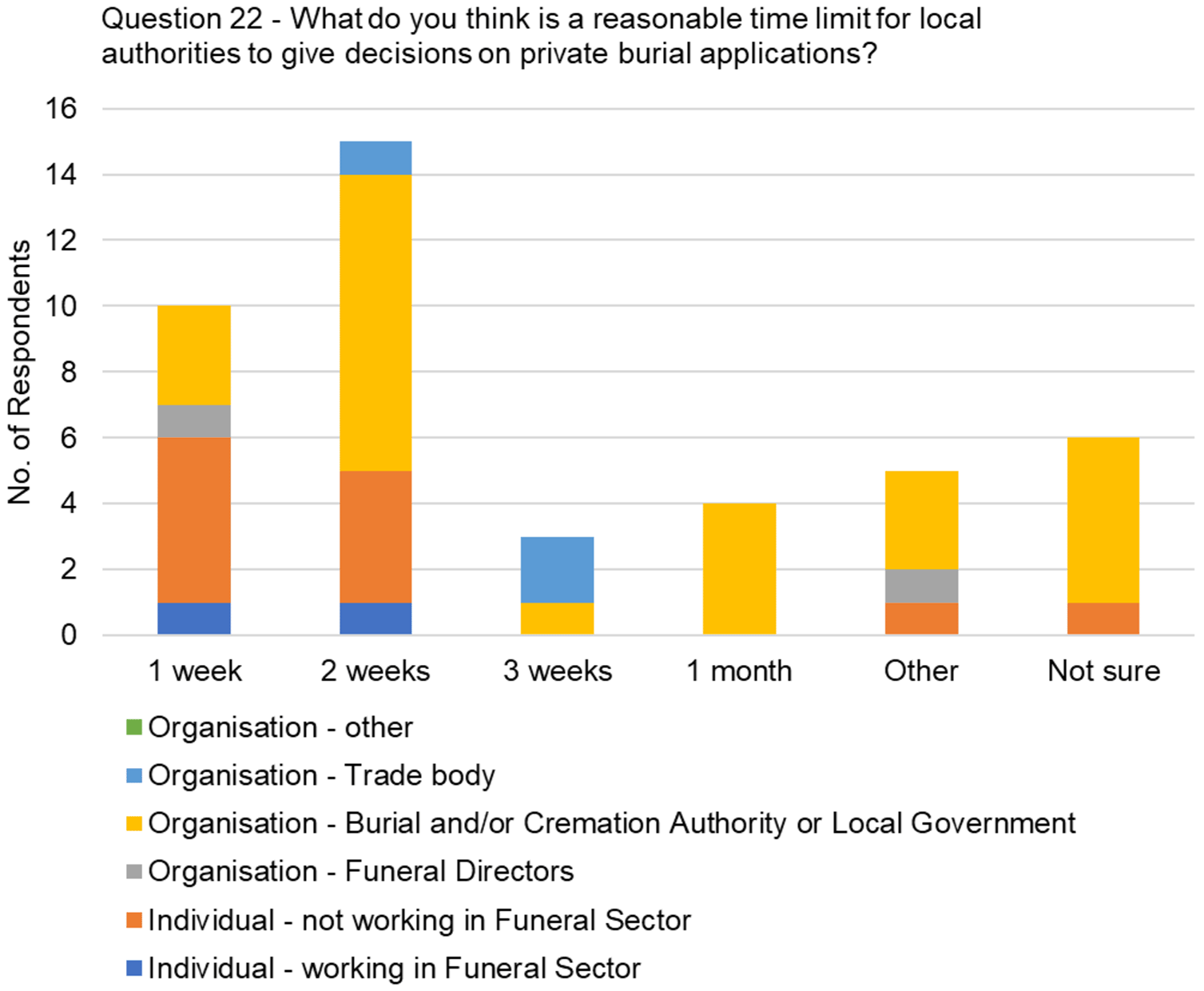
Qualitative data
Thirty-nine (39) respondents provided reasons and comments on the answer they selected.
Most answers centred on either (or both) how feasible it was to complete this process in a particular timescale, and the potential impact on appropriate care of the deceased and bereaved.
Several respondents, regardless of the timescale they suggested, noted that the process should aim to ensure that the burial occurs as soon as possible, however some of these responses acknowledged the number of factors that might impede progress e.g. whether the application was properly completed once the local authority received it, if there were objections lodged, or the resources available within a local authority.
“It will be important for the family to know that a funeral can (or can’t) take place in a timely manner. Equally, the local authority may require sufficient time to make the necessary enquiries. The local authority will need to ensure they have adequate resources to meet any deadline, eg leave, sickness of officers may have to be covered” [Organisation response, trade body for burial authorities]
“On the basis that the feasibility information is accurate and complete and given that the death had occurred, the Burial Authority should be able to provide a decision on applications within one week. This could be dependent on the geography of the specific Burial Authority” [Organisation response, burial authority]
Some respondents suggested a variable approach was needed depending on whether a death had occurred, or whether an application was being made for future private burial (without a recent death). Similarly some respondents suggested a variable approach might also be needed based on different geographic needs and resources (e.g. body storage facilities in rural areas).
Some of the comments from those who suggested the longest timescale (1 month) suggested that they may have misunderstood the timescale as including the pre-application process. Rather, the question sought views on the timescale following the submission of a completed application (i.e. after the third party checks and the feasibility study had concluded). Others gave reasons that centred on the need to give enough time to allow for the different elements of the process to take place, including a period of time following a local authority decision.
“A month seems a reasonable turnaround on application whilst giving sufficient time for burial authorities to be fully informed and review necessary paperwork. However, there should be notes that this timescale is subject to the necessary paperwork being received and completed on time and therefore it is not a guaranteed timescale. Also should there be a timescale between when the burial authority makes a decision to the burial going ahead to make time for any appeals to be made/heard? Planning applications alone can take time to process particularly if a neighbourhood notification requires to be issued. It should also be noted that this is additional work to a burial authority and, as a burial authority, we require to ensure that there are no adverse effects on burials at its own cemeteries.” [Organisation response, Burial authority and cremation authority]
As with Question 21 some local authorities voiced opposition to the level of local authority involvement proposed and lack of investment to provide this new service, and one respondent representing a funeral director business/organisation stated that the proposed process would be unnecessarily obstructive.
Question 23. Please share your views on the Scottish Government’s proposal not to allow for an application for private burial to be made for a person who is not yet deceased. (para 77 - 80)
This question offered space for comments (qualitative data), without options to select from a predetermined list.
Qualitative data
Forty (40) respondents provided comments to this question.
The responses were very mixed with around half in clear support, around 1/3 opposed to the proposal, and the minority taking a more neutral stance. Those in agreement tended to offer straightforward statements of support rather than detailed reasoning, often reiterating some of the reasons offered in the consultation document. Some respondents gave more caveated agreement (e.g. that the application process be done in a “timely fashion”) or suggested that a level of compromise might be more appropriate (e.g. feasibility studies being completed in advance and updated if needed).Some described considering both options but ultimately felt that this was the more feasible approach.
“My initial thought was that it should allow advance applications but having reading through the 7 listed potential drawbacks I support the decision” [Individual response, works in funeral directing]
“Agree with this as views, will, preference may change- keeping this application on file for unknown period of time leads to errors and possible legal challenge at a later date.” [Individual response, does not work in funeral sector]
One respondent (representing a local authority) was opposed to a local authority having any involvement in receiving applications for private burial whether in advance of a death or following one. Those opposed to the proposals included those across the different employment and organisation types, rather than one particular group.
Reasons for opposition included:
- The level of work required being unreasonable (in complexity and timescale) for recently bereaved relatives to be expected to undertake and, as a result, restrictive.
- That it was feasible to undertake certain elements of the process in advance
- Allow people to take on some of the administration in advance of their own death
- Enable advance planning for the burial authority
“Allowing advance applications will speed up the time between death and disposal, ease the burden on storage and allow a grieving family closure…Given the huge delays in the death care management system that Scotland has at the moment, where it is not uncommon for families to wait 4 weeks for a funeral, anything that eases this would appear to be a sensible solution. A private burial application granted in advance by the local authority – with conditions attached – seems sensible and proportionate. After all, it is on land owned by the applicant.
However, some of the concerns laid out by the Government are fair, particularly around applications made well in advance of expected death, which may then lead to more paperwork and delay, rather than less. Yet given the small amount of private burials per year, the proposed approach appears overbearing and unnecessarily bureaucratic. There are pros and cons to both systems but on balance we do not support the Government’s proposal that there should not be an option to apply for a private burial in advance of a person’s death. Each case should be taken entirely on merit.”
[Organisation response, trade body]
Some of the respondents in opposition showed evidence of misunderstanding the proposals i.e. thinking that no arrangements for private burial could be made in advance of death. For clarity, it is proposed that Scottish Government guidance on private burial will be available to assist people to make these preliminary preparations, for example, by giving information on how to contact the planning authority, SEPA or Scottish Water and checking the relevant guidelines. A person could also arrange for a feasibility study to be undertaken to help determine the suitability of the location.
The proposal in the consultation was that a formal application for private burial could not be submitted and approved by a local authority until after the person has died, given possible changes in circumstances over time and various complex legal and practical factors. This would not preclude preliminary preparations being made, however, the onus would be on the living applicant to ensure the burial is in compliance with relevant rules and guidelines at the time of burial. Whilst they can take into account the preparations made by the deceased in advance, consideration of time lapsed and potential changes of circumstance or to guidance would be taken into account. The local authority may request that some checks are repeated.
Question 24. Do you think private burial should be considered on a case-by-case basis? (para 81)
This question asked respondents to select one option from a list of predetermined options (quantitative data), and in addition allowed a free text box for further comments (qualitative data).
Quantitative data
Forty-five (45) of the 59 respondents answered this question. A majority (n=36, 80%) of respondents answered ‘Yes’ that private burial should be considered on a case-by-case basis rather than restrictions being included in the regulations.
Table 17 and Figure 16 (below) show the responses broken down by respondent type (individual or organisation response, and whether, or not, respondents were part of the funeral sector).
| Respondent Type | No. of Responses (Q24) | ||
|---|---|---|---|
| Yes | No - restrictions should be included in the regulations | Not Sure | |
| Individual - working in funeral sector | 2 | 0 | 0 |
| Individual - not working in funeral sector | 7 | 2 | 2 |
| Organisation - funeral directors | 1 | 1 | 0 |
| Organisation - burial and/or cremation authority or local government | 23 | 2 | 1 |
| Organisation - trade body | 2 | 0 | 1 |
| Organisation - other | 1 | 0 | 0 |
| All respondents | 36 | 5 | 4 |
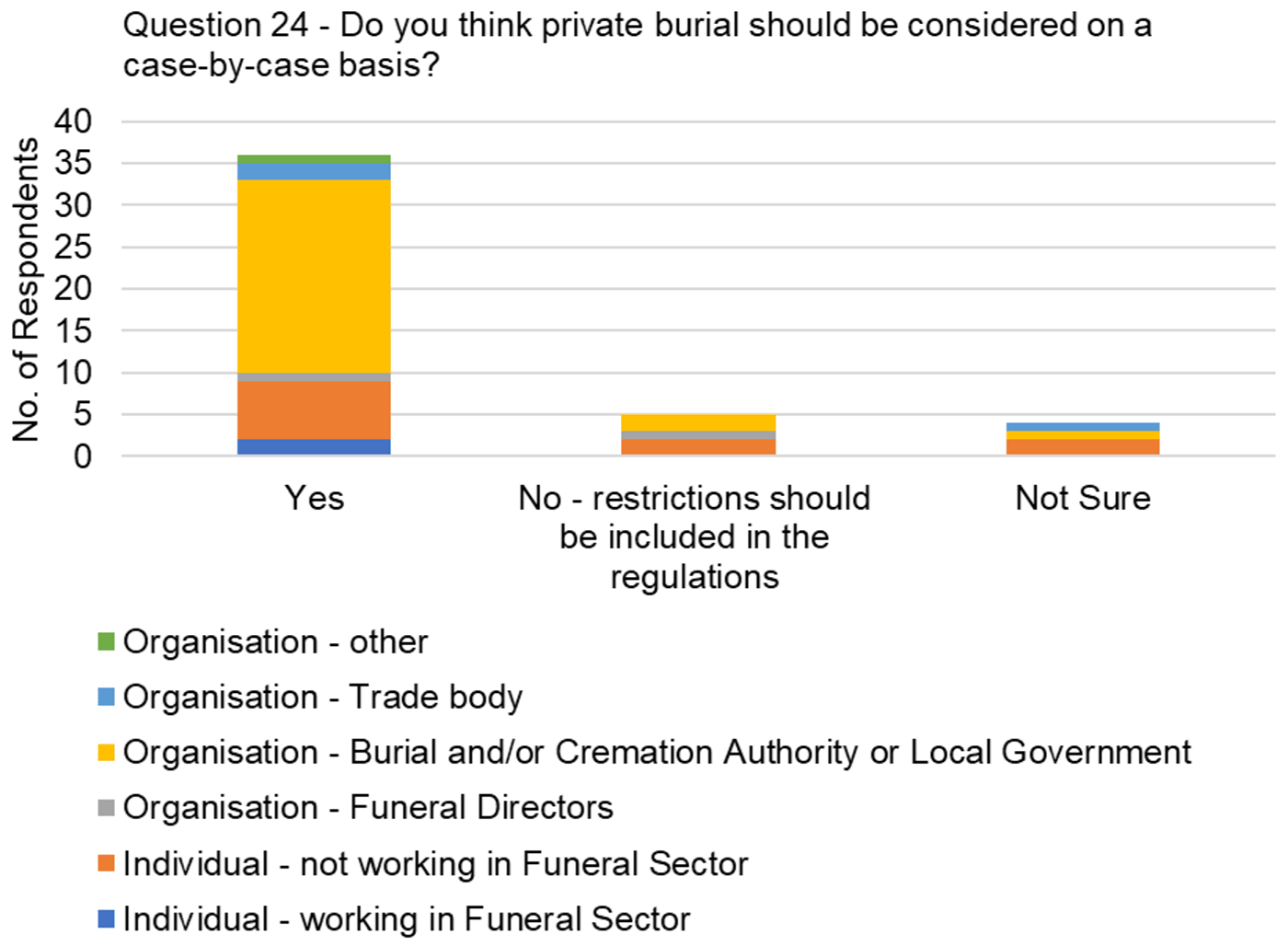
Qualitative data
Respondents were asked to give reasons for their answers and 36 provided comment here. Since the vast majority of respondents had selected ‘Yes’, most of the further comments offered tended to restate their agreement and reasons given in the consultation document. Some of those who answered “No” or “Not Sure” felt that some level of restrictions should be in place.
Very few examples of such restrictions were given – one respondent suggested a minimum distance between lairs to prevent wall collapse on exhumation, another suggested limiting the number of burials on the land before a change of use planning application would be required and restrictions on the distance from the property boundary.
One (1) respondent highlighted the need to make a distinction between private burials on private land not designated as a burial ground and private burials within private burial grounds/cemeteries.
Question 25. Do you think that regulations should give local authorities the power to charge fees for their role in private burial applications? (para 82)
This question asked respondents to select one option from a list of predetermined options (quantitative data), there was no space provided for additional comments but the following question (Question 26) allowed space for respondents to comment on this.
Quantitative data
Forty-three (43) of the 59 respondents answered this question. A majority (n=41, 95%) of respondents answered ‘Yes’ that regulations should give local authorities the power to charge fees for their role in private burial applications.
Table 18 and Figure 17 (below) show the responses broken down by respondent type (individual or organisation response, and whether, or not, respondents were part of the funeral sector).
| Respondent Type | No. of Responses (Q25) | ||
|---|---|---|---|
| Yes | No | Not Sure | |
| Individual - working in funeral sector | 2 | 0 | 0 |
| Individual - not working in funeral sector | 9 | 1 | 1 |
| Organisation - funeral directors | 2 | 0 | 0 |
| Organisation - burial and/or cremation authority or local government | 25 | 0 | 0 |
| Organisation - trade body | 3 | 0 | 0 |
| Organisation - other | 0 | 0 | 0 |
| All respondents | 41 | 1 | 1 |
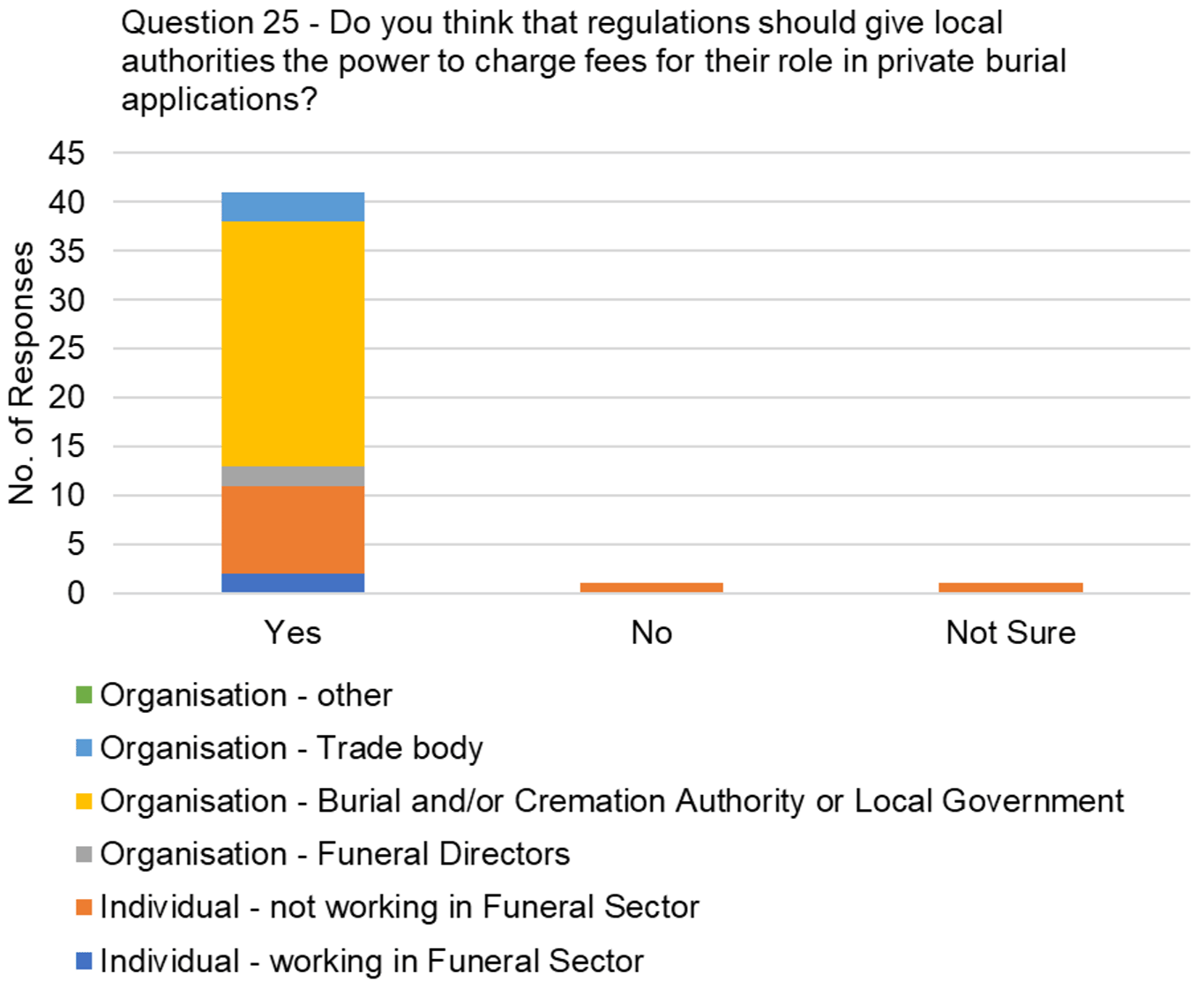
Question 26. If you answered "yes" to question 25, what services should local authorities be able to charge for in relation to private burial? (para 82)
This question offered space for comments (qualitative data), without options to select from a predetermined list.
Qualitative data
Thirty-nine (39) of the 41 respondents who previously answered ‘Yes’ at Question 25 made suggestions of services that should be chargeable. Some respondents simply stated that full cost recovery was appropriate. Others elaborated, as summarised:
- Site visit, risk assessment, test dig and provision of feasibility study/certificate
- Administrative fee for assessment of application
- Coordination of screening from departments and agencies and recovery of costs from the different departments or agencies involved, if required
- Grave digging services including excavation and backfill
- Equipment use – including vehicles, machinery and plant use including fuel charges.
- Data collection/storage and recording the burial in the private burial register
- travel to and from site
A frequent comment made by respondents was that any fee charged should be fair value, kept to a minimum and not generate profit. Whilst some respondents thought there should be a standard fee covering all charges, this was countered by another respondent who did not agree with a blanket charge, but considered that the fee should depend on the specific work that was necessary.
One (1) respondent stated that, as currently happens, a fee should stand even if the feasibility study ultimately recommends against burial in the proposed location.
One (1) respondent representing a local authority which does not currently offer private burial services, felt that:
“If the council are legally required to provide this service, the regulations should give the council the power to charge a fee equivalent of all costs associated with providing this new service including creation of new posts and all associated policy and procedure and vehicles and equipment etc.” [Organisation response, local government]
Question 27. What is your view on the proposed information to be collected in the Register of Private Burial? (para 83)
This question asked respondents to select as many options as they wanted from a list of predetermined options (quantitative data), and in addition allowed a free text box for further comments (qualitative data).
Quantitative data
Forty-four (44) of the 59 respondents answered this question. The most frequent response (n= 28) was “It looks right”. Although respondents could select more than one option, no one did and there was a total of 44 responses, each from a different respondent.
Table 19 and Figure 18 (below) show the number of respondents who selected each option.
| Question 27 What is your view on the proposed information to be collected in the register of private burial? (para 83) | No. of Respondents |
|---|---|
| It looks right | 28 |
| It does not look right | 1 |
| Some of this is unnecessary information | 2 |
| There is some information missing | 11 |
| Not sure | 2 |
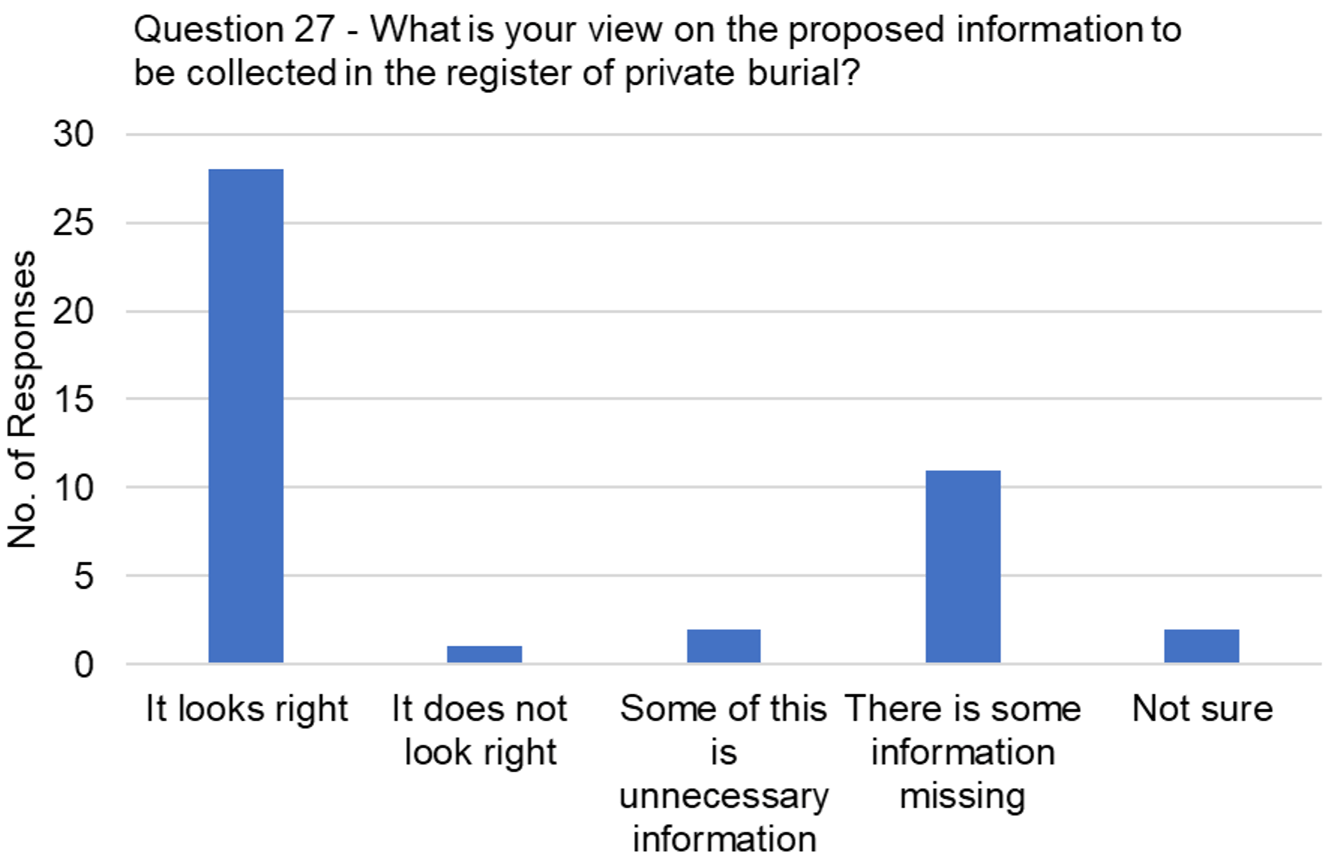
Qualitative data
Thirty-one (31) respondents offered comments on question 27.
Many of the respondents reiterated their selection of “it looks right” and noted their agreement with a short comment of support. A few respondents, whilst agreeing “it looks right” added that it should more closely mirror the content of the burial register for burial grounds.
Those respondents who answered “There is some information missing” suggested including:
- Coordinates (longitude/latitude) and map of burial site
- Depth of burial
- Coffin/casket size and type/material (important if exhumation required at a later date)
- Detail of memorial stone
- Position within the lair
- Name of person approving
- If the deceased person had been exhumed, which burial ground they came from
- Digital address system
- Details of adjacent property (including if they are listed and any planning permission granted for other use of the site)
One (1) respondent felt that addresses of the deceased and applicant were unnecessary. Another respondent felt that only the most basic information should be collected and that the type of burial and applicant details were not required.
One (1) respondent highlighted:
“If we want to record that the funeral has taken place how does this get recorded if the Burial authority aren’t asked to undertake the burial. Organisation undertaking the interment needs to be included on the application and burial confirmed” [Organisation response, burial authority]
Question 28. Please provide any comments on an appropriate way to record the precise location of the private burial site (e.g. coordinates or description). (para 83)
This question offered space for comments (qualitative data), without options to select from a predetermined list.
Qualitative data
Forty (40) respondents answered this question suggesting methods for accurate recording of the private burial site. A number of suggestions were made, with some recommending a combination of more than one of these methods:
- Coordinates (latitude and longitude)
- Ordnance Survey National Grid Reference (10 number grid reference indicates a 1m by 1m square on the map.)
- A map of the site using GIS mapping
- A clear description using permanent geographical features, if possible
- ‘What 3 words’ geocode system
- A photo of the burial site, with landmarks if possible
- A headstone, memorial or other marker to physically mark the site
One (1) respondent noted that the type of coordinates used should be included in the guidance/ regulations to ensure all burial authorities use the same type.
Question 29. Please provide any views on the proposed appeal process for private burial decisions made by local authorities. (para 84 - 88)
This question offered space for comments (qualitative data), without options to select from a predetermined list.
Qualitative data
Thirty-six (36) respondents commented on question 29. Roughly half showed some level of agreement with the proposals, most of these being straightforward statements of agreement but others with more caveated responses or agreeing with the need for appeal but suggesting alterations to the proposal.
“Appeal process seems reasonable. Agree that an internal review by the local authority is unlikely to change the situation and could add time onto the process” [Organisation response, trade body]
“This all looks fine, but there is always the ticking clock. It all looks both cumbersome and time consuming unless there is some form of fast-track process.” [Organisation response, Funeral director business/organisation]
A minority of respondents were opposed to including an appeal process.
“Do not believe there should be an appeals process – the collective agencies decision should be final.” [Organisation response, local government]
Several respondents made reference to time constraints and the need for a quick process. Some, who had previously shown support for application options in advance of a death suggested that including an appeal process gave further weight to the argument for allowing application for private burial before a death.
“As suggested, appealing to the local authority is not productive or sensible. Speed may be inportant [sic] and will certainly be so unless you adopt a scheme such as the one I suggest with pre-arrangement allowed.” [Individual, not employed in funeral sector]
Some made the suggestion that an alternative (or additional) option might be to involve inspectors in the appeal process, and that this might allow a more timely response than the sheriff court.
“It is important to put in place a system that expedites the final outcome rather than allowing unnecessary layers of decision-making or bureaucracy. Rather than go straight to the Sheriff Court, could first appeal not be to the Inspectorate, which may allow a swifter resolution. The legal route should always remain in place if required.” [Organisation response, trade body]
Some respondents asked for more detail to be included:
- Guidance/ explanatory notes for appellants on the broad format of an appeal and the process to be followed
- Whether any other interested parties could lodge an appeal at this stage, for example, in relation to planning permission.
- Whether a material objection would be required (such as on planning grounds) to appeal once a local authority
For clarity, it is intended that if planning permission were required, this would be dealt with under the separate planning process with the objection process built in. This would precede any final decision on the private burial application. The burial regulations will not affect existing regulation and requirements around planning permission.
1.5 Exhumation
Question 30. Where an application for exhumation from a burial ground is made by a relative of the deceased who is also the lair right-holder but is not the nearest relative, do you think the applicant should be required to obtain written consent from the nearest relative(s) and any relatives of the deceased who have the same degree of kinship as the applicant (e.g. the applicants siblings)? (para 96 - 103)
This question asked respondents to select one option from a list of predetermined options (quantitative data), and in addition allowed a free text box for further comments (qualitative data).
Quantitative data
Forty-three (43) of the 59 respondents answered this question. A majority (n=34, 79%) of respondents answered ‘Yes’ in agreement with this proposal.
Table 20 and Figure 19 (below) show the responses broken down by respondent type (individual or organisational response, and whether, or not, respondents were part of the funeral sector).
| Respondent Type | No. of Responses (Q30) | ||
|---|---|---|---|
| Yes | No | Not Sure | |
| Individual - working in funeral sector | 2 | 0 | 0 |
| Individual - not working in funeral sector | 8 | 1 | 1 |
| Organisation - funeral directors | 1 | 1 | 0 |
| Organisation - burial and/or cremation authority or local government | 20 | 3 | 1 |
| Organisation - trade body | 3 | 0 | 0 |
| Organisation - other | 0 | 0 | 2 |
| All respondents | 34 | 5 | 4 |
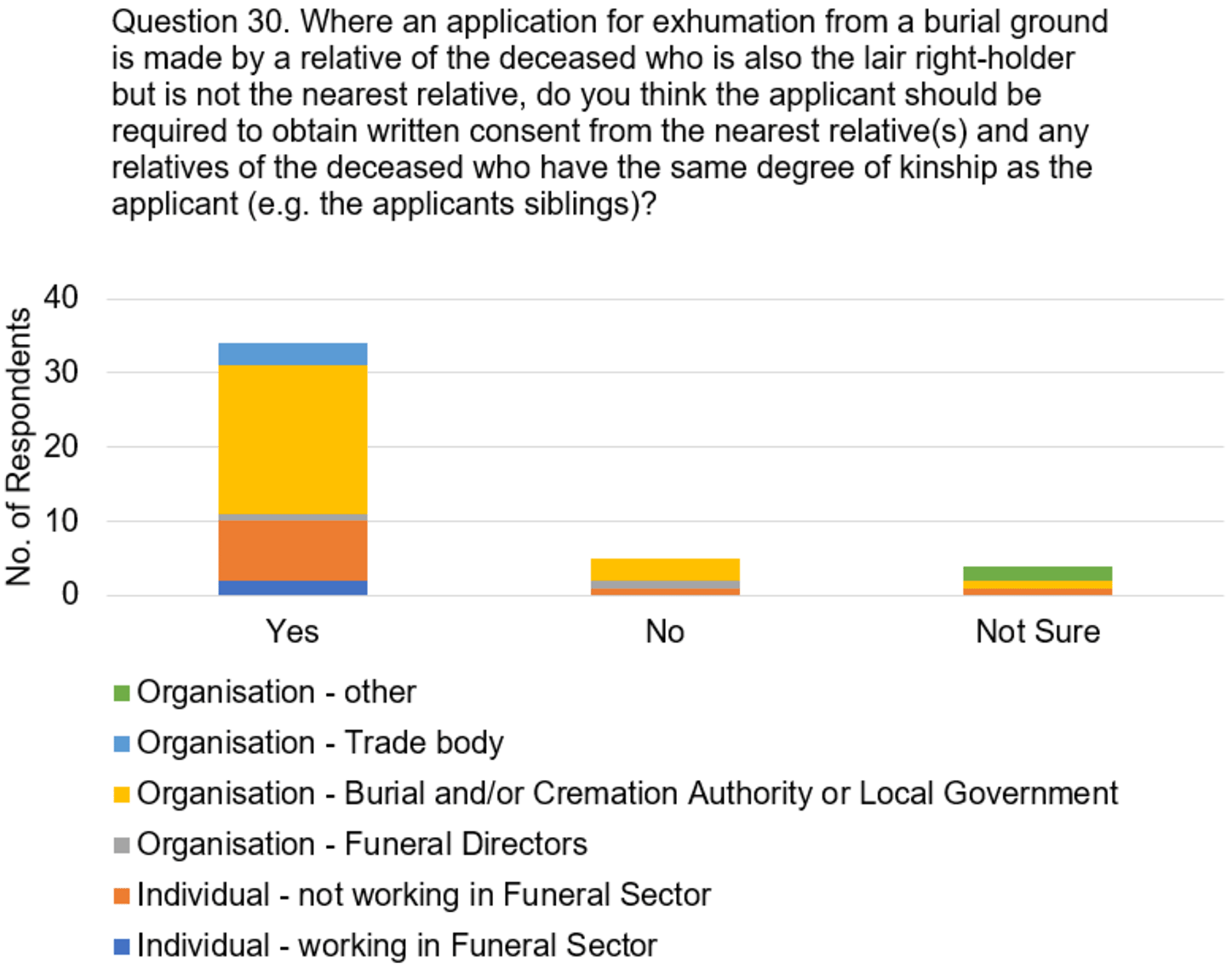
Qualitative data
There were 33 responses to this question. Those who answered “yes” reiterated their agreement. Some focussed their answers on their view that this was a fairer process for relatives, others focussed on this helping to avoid family disputes. Several responses, regardless of whether they agreed with the proposal or not, acknowledged the difficulties with regulations in this area given varying family circumstances and context.
“The rights of the lair right-holder are crucial when considering any activity that impacts that lair, while the nearest relative(s) should be asked for permission if an exhumation is to take place so that all key relatives have given permission. You are right to say modern families are complex and take different forms, and you must consider the higher risk of conflict and non-resolution by not giving enough people a voice. Given these complexities perhaps while in principle a stance is taken, cases could be considered on a case by case basis should there be other influences affecting decision making.” [Organisation response, trade body]
Some respondents who had previously answered “No” felt that the lair right holder should be the only one to make the decision in this case, without needing consent.
“It should be the lair right-holder's decision, otherwise the process becomes unclear and could become legally complex depending on family genealogy and evidence required.” [Organisation response, burial authority]
Question 31. Where an application for exhumation is made by a nearest relative of the deceased but they are not the lair right-holder, should that relative be required to obtain the written consent of the lair right-holder and any relatives of the deceased who have the same degree of kinship as the applicant (e.g. the applicant’s siblings)? (para 104)
This question asked respondents to select one option from a list of predetermined options (quantitative data), and in addition allowed a free text box for further comments (qualitative data).
Quantitative data
Forty-three (43) of the 59 respondents answered this question. A majority (n=37, 86%) of respondents answered ‘Yes’ in agreement with this proposal.
Table 21 and Figure 20 (below) show the responses broken down by respondent type (individual or organisational response, and whether, or not, respondents were part of the funeral sector).
| Respondent Type | No. of Responses (Q31) | ||
|---|---|---|---|
| Yes | No | Not Sure | |
| Individual - working in funeral sector | 2 | 0 | 0 |
| Individual - not working in funeral sector | 8 | 2 | 0 |
| Organisation - funeral directors | 2 | 0 | 0 |
| Organisation - burial and/or cremation authority or local government | 22 | 0 | 2 |
| Organisation - trade body | 3 | 0 | 0 |
| Organisation - other | 0 | 0 | 2 |
| All respondents | 37 | 2 | 4 |
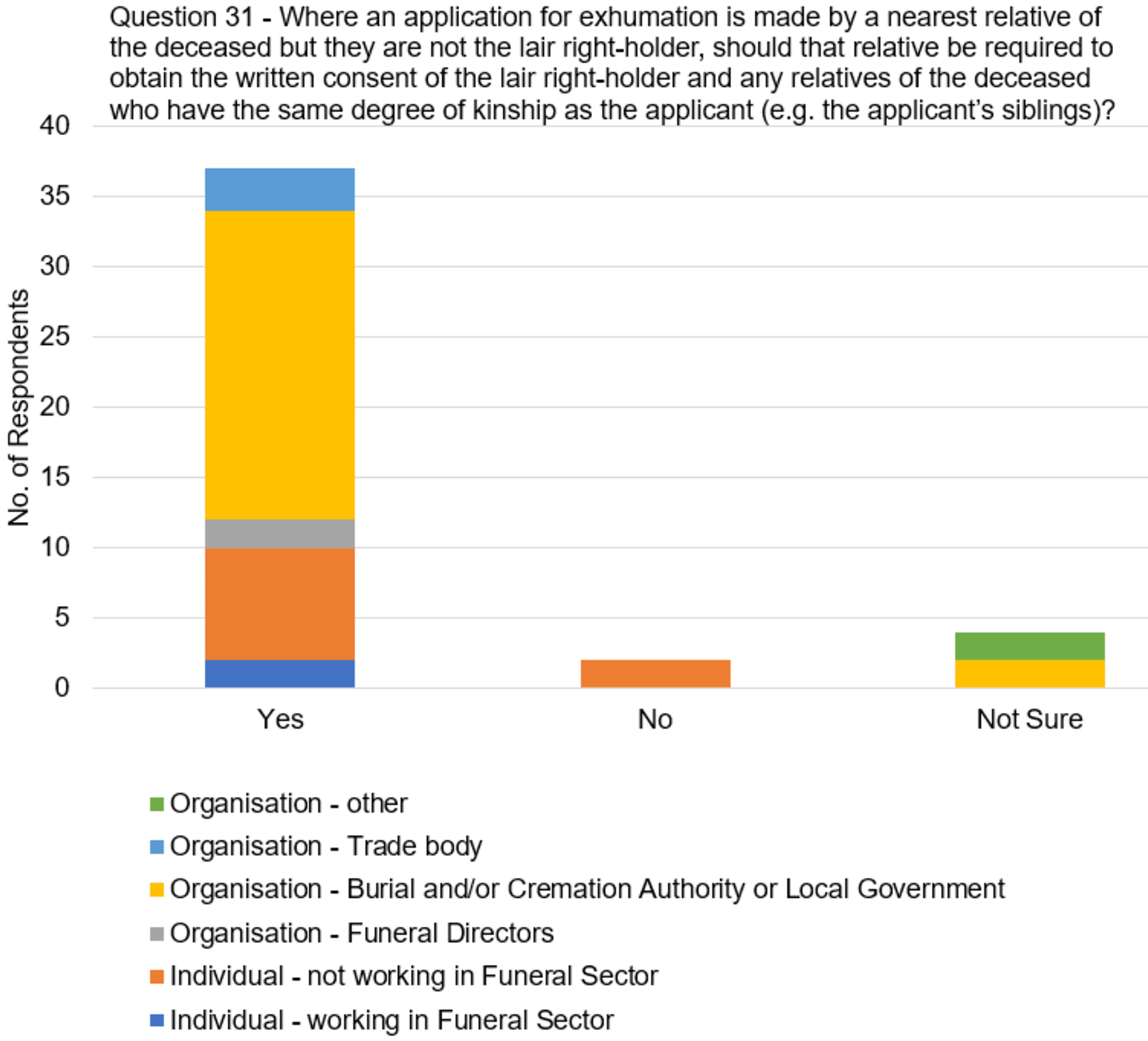
Qualitative data
There were 30 responses and there were limited comments, some restating agreement with the question, others repeating responses they made in the previous question. Several respondents emphasised that they deemed the lair right-holder’s permission to be essential and one respondent felt this was the only permission needed (not nearest relatives). Two (2) respondents suggested that in cases where there are a number of nearest relatives majority agreement could be considered rather than permission given by all. In contrast, one respondent thought that even if a nearest relative was estranged, their consent should still be required as they should have a reasonable expectation that their relative will not be moved, i.e. all relatives should have the right to withhold consent by not engaging with the process.
Question 32. Where an application for exhumation from a burial ground is made by a burial authority, from whom should written consent be obtained? (para 105 - 106)
This question asked respondents to select as many options as they wanted from a list of predetermined options (quantitative data), and in addition allowed a free text box for further comments (qualitative data).
Quantitative data
Forty-three (43) of the 59 respondents answered this question. The most frequent response (40) was ‘Lair right-holder’. Since respondents could select more than one option there was a total of 74 choices made, with 28 respondents selecting more than one option. Of these 28 respondents, 24 selected both ‘Lair right-holder’ and ‘Nearest relatives’, 3 respondents selected all three options and one respondent selected ‘Lair right-holder’ and ‘Other’.
Table 22 and Figure 21 (below) show the number of respondents who selected each option [NB. Respondents could select more than one option].
| Question 32 Where an application for exhumation from a burial ground is made by a burial authority, from whom should written consent be obtained? (para 106) | No. of Responses |
|---|---|
| Lair right-holder | 40 |
| Nearest relatives | 27 |
| Other | 7 |

Qualitative data
There were 36 responses and quite mixed views even among those who had selected the same option – particularly around the extent to which this should be only consultation/notification or seeking permission from relevant parties. Additionally there were quite varied views of what should happen if no one can be contacted and many respondents gave answers that appeared to assume it would be easy to contact the lair right-holder and/or relatives.
One (1) response highlighted that historic graveyards may have limited records in terms of lair right-holders, and others suggested a flexible process might be needed depending on the reasons for the application and the likelihood of being able to contact or gain permission from lair right-holders and relatives.
Question 33. Please share any views you have on the proposed fast-tracked exhumation procedures? (para 107 - 109)
This question offered space for comments (qualitative data), without options to select from a predetermined list.
Qualitative data
There were 36 responses and majority agreement, some giving short statements of agreement others giving more detailed responses raising specific issues. Some respondents were only in partial agreement in terms of which circumstances this process should cover. Generally speaking the majority of respondents welcomed this proposal and noted the need for such a process in order to ensure that burials were not unnecessarily delayed and bereaved people impacted by this.
Several respondents representing burial authorities, funeral directors and trade bodies raised one (or both) of two related issues:
1. Defining exhumation related to current practice in burial
Some of these respondents raised the issue of defining ‘exhumation’ and described a practice of, where possible, moving interred remains down while excavating the grave for more space, explaining this could be done without necessarily bringing the interred remains to the surface. In particular this was felt to be a practical solution for interred ashes and infant burials where enough space could be made by retaining these within the grave while excavating.
“Where there has been an ashes interment prior to a full coffin burial we currently use a common practice method of moving an existing ashes interment within the lair to allow a full excavation and then move the ashes down in the lair on completion of the excavation but never exhumed from the lair.” [Organisation response, burial authority and cremation authority]
2. Applying certain exemptions to the need for exhumation application based on the definition of exhumation
Some respondents viewed the aforementioned practice as not being considered “exhumation” and should therefore be exempt from requiring an application for exhumation. One respondent noted that if an application, fast tracked or otherwise, would be required for this process then this would create additional workload for them that might impact on service delivery.
“We don't feel a fast track exhumation or any exhumation order is required for ashes (regarding delay to a burial as the cremated remains casket can be stepped down as the grave is excavated and no requirement to remove the ashes from the grave. An exhumation is only required if ashes being removed from the grave permanently.” [Organisation response, burial authority]
Another respondent felt that this exemption was particularly important when infant burials are within a lair in order to reduce the impact on the bereaved:
“When previous infant burial/s are within lairs, families are understandably very emotive and a high degree of compassion, professionalism and efficiency should be employed. A funeral must not be delayed in these circumstances. Exhumation exemptions should apply especially to previous infant burials also, shallow buried ashes. Burial authorities should be permitted to deepen previous infant burials and shallow buried ashes when interment applications are in place for subsequent interments without this being considered an exhumation, to protect families from bureaucracy likely to cause them further distress at these highly emotive periods especially for previous infant burials.” [Organisation response, burial authority]
Three (3) respondents noted that if any remains are thought to be archaeological, that emergency advice from the local authority archaeological advisor should be sought.
Question 34. Thinking about the proposed feasibility report factors set out in the information box below, which do you think should be included in a feasibility study for exhumation? (para 111)
This question asked respondents to select as many options as they wanted from a list of predetermined options (quantitative data), and in addition allowed a free text box for further comments (qualitative data).
Quantitative data
Forty-six (46) of the 59 respondents answered this question. The most frequent response (41) was ‘Health and Safety Risk Assessment’. Since respondents could select more than one option there was a total of 145 choices made, with 40 respondents selecting more than one option.
The most frequent combination of choices (17 respondents, 37% of the 46 respondents answering this question) was to select all of the named options (i.e. not ‘other’ or ‘none of the above’) on the list: ‘A check of the condition of the coffin to determine feasibility to exhume’, ‘Health and Safety Risk Assessment’, ‘Archaeological assessment (by local authority archaeologist or HES)’, and ‘Consultation with the CWGC’.
Table 23 and Figure 22 (below) show the number of respondents who selected each option [NB. Respondents could select more than one option].
| Question 34 Thinking about the proposed feasibility report factors set out above, which do you think should be included in a feasibility study for exhumation? (para 111) | No. of Responses |
|---|---|
| A check of the condition of the coffin to determine feasibility to exhume | 34 |
| Health and Safety Risk Assessment | 41 |
| Archaeological assessment (by local authority archaeologist or HES) | 32 |
| Consultation with the CWGC | 30 |
| Other | 8 |
| None of the above | 0 |
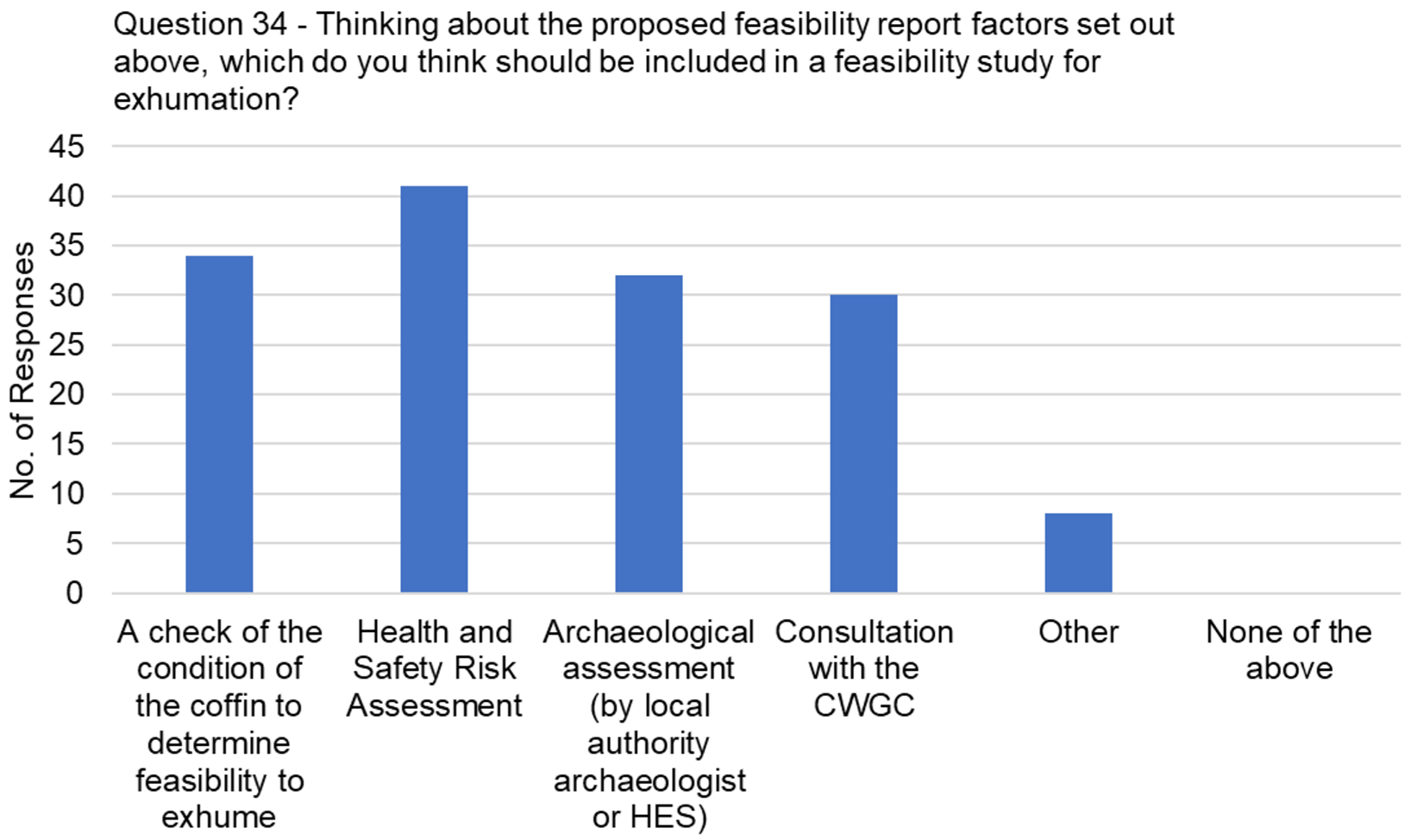
Qualitative data
Respondents were asked to provide any views on anything that should or should not be included in a feasibility report. Of the respondents who provided a comment, most considered the proposed list reasonable and it was suggested that other reports could be included where appropriate, such as the impact the exhumation might have on all neighbouring lairs and memorials.
“In addition to the above, we also believe it is important to note any impact(s) that exhumations may have on adjacent structures and memorials. These impacts should not only be restricted to scheduled monuments as your preamble suggests.”
[Organisation response, burial authority]
Some noted that it would be necessary to excavate the lair to some extent in order to assess the condition of the coffin and having information about the type of coffin would be helpful. One respondent commented on the construction of modern coffins affecting how likely they would be to still be intact:
“With the drop-in long-term survivability (quality of manufacture compared to yesteryear) of modern veneered chipboard, foil, wicker and carboard coffins (some a few days to weeks to breakdown at best) compared to pre-mid-20th Century coffins (solid wood and or lead lined, lasting many decades depending upon ground conditions) the condition of later or modern coffins will not be good."
[Organisation response, funeral director business/organisation]
As part of the initial assessment one respondent noted the need to assess the public health risk, depending on the cause of death. Another noted the impact on those carrying out an exhumation and their wellbeing.
The type of soil in the burial ground and the impact of weather at different times of year were also commented on as things that should be noted in a feasibility report.
“It is important to note that weather conditions can play a huge role during an exhumation and it should be included in the feasibility report. It may be that an exhumation is better being carried out at a particular time of year when weather conditions may be more favourable for an exhumation in a particular location/cemetery. The timescale for when an exhumation should be carried out should form part of the feasibility and the burial authority guidance on this should be followed obviously depending on the circumstances of the exhumation request.” [Organisation response, burial authority]
The inclusion of an archaeological assessment in the list was welcomed although one respondent commented that it should not only be local authority archaeologists.
“Feasibility reports should include "Archaeological assessment" but remove "(by local authority archaeologist or Historic Environment Scotland)"
This is because almost all archaeological work in Scotland is undertaken by private sector archaeological specialist companies. They may be working on behalf of a burial authority, the local authority, Historic Environment Scotland - or any other relevant stakeholder.”
[Organisation response, other]
One respondent commented on the comparison that could be made between individual exhumations and exhumations for reuse of lairs when the coffin is not intact.
“Currently in order to give exhumation consent – if a coffin is discerned not to be intact, exhumation feasibility should not be given, but is it correct that lair restoration criteria (100 years have passed since the last burial, all processes successfully undertaken) remains would be lifted and deepened even if the coffin is not intact? If this is the case, should exhumation regulations match lair restoration regulations? in that if 100 years have passed since the last burial, exhumation feasibility should be given even if the coffin is not intact.”
[Organisation response, burial authority]
Question 35. Do you think there should be a time limit for carrying out an exhumation once authorisation has been given? (para 112)
This question asked respondents to select one option from a list of predetermined options (quantitative data). There was no space provided for additional comments but the following question (Question 36) allowed space for respondents who answered “yes” to comment on this.
Quantitative data
Forty-two (42) of the 59 respondents answered this question. A majority (n=37, 88%) of respondents answered ‘Yes’ in agreement that there should be a time limit for carrying out an exhumation once authorisation has been given.
Table 24 and Figure 23 (below) show the responses broken down by respondent type (individual or organisational response, and whether, or not, respondents were part of the funeral sector).
| Respondent Type | No. of Responses (Q35) | ||
|---|---|---|---|
| Yes | No | Not Sure | |
| Individual - working in funeral sector | 1 | 0 | 0 |
| Individual - not working in funeral sector | 8 | 0 | 1 |
| Organisation - funeral directors | 2 | 0 | 0 |
| Organisation - burial and/or cremation authority or local government | 21 | 2 | 2 |
| Organisation - trade body | 3 | 0 | 0 |
| Organisation - other | 2 | 0 | 0 |
| All respondents | 37 | 2 | 3 |
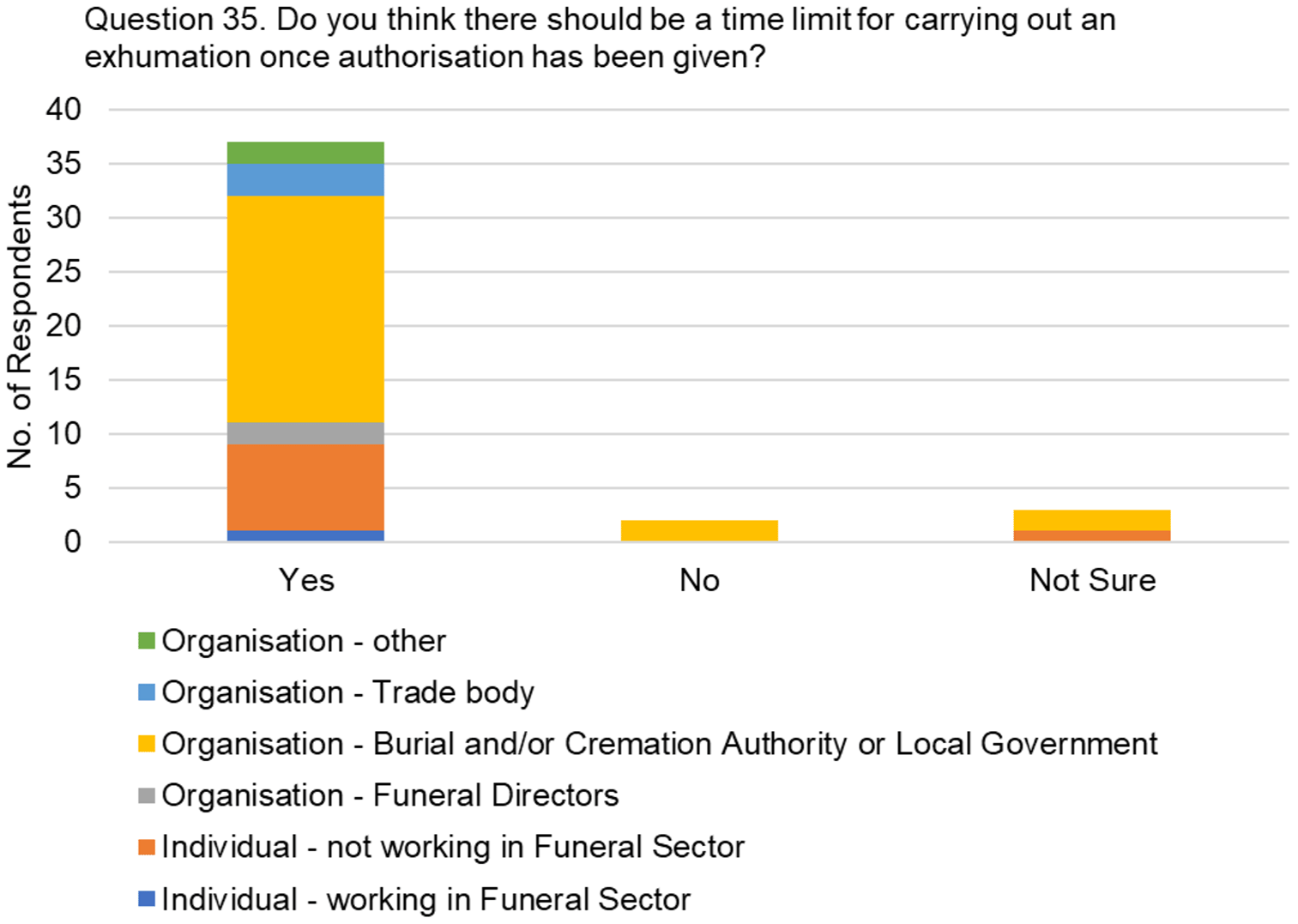
Question 36. If you answered "yes" to question 35, what do you think the time-limit should be? (para 112)
This question asked respondents to select one option from a list of predetermined options (quantitative data), and in addition allowed a free text box for further comments (qualitative data). This question asked that only those who answered ‘yes’ to the previous question (Question 35) should answer, therefore only responses from those respondents (37) have been considered.
Quantitative data
All of the 37 respondents eligible for this question gave answers. The most frequent response (n=16, 43%) was that ‘3 months’ should be the time limit for carrying out an exhumation once authorisation has been given. However no single option received a majority share of responses. Table 24 and Figure 23 (below) show the responses broken down by respondent type (individual or organisational response, and whether, or not, respondents were part of the funeral sector).
| Respondent Type | No. of Responses (Q36) | ||||
|---|---|---|---|---|---|
| 3 months | 6 months | 1 year | 2 years | Other | |
| Individual - working in funeral sector | 0 | 1 | 0 | 0 | 0 |
| Individual - not working in funeral sector | 4 | 1 | 2 | 1 | 0 |
| Organisation - funeral directors | 1 | 1 | 0 | 0 | 0 |
| Organisation - burial and/or cremation authority or local government | 10 | 5 | 6 | 0 | 0 |
| Organisation - trade body | 0 | 2 | 1 | 0 | 0 |
| Organisation - other | 1 | 1 | 0 | 0 | 0 |
| All respondents | 16 | 11 | 9 | 1 | 0 |
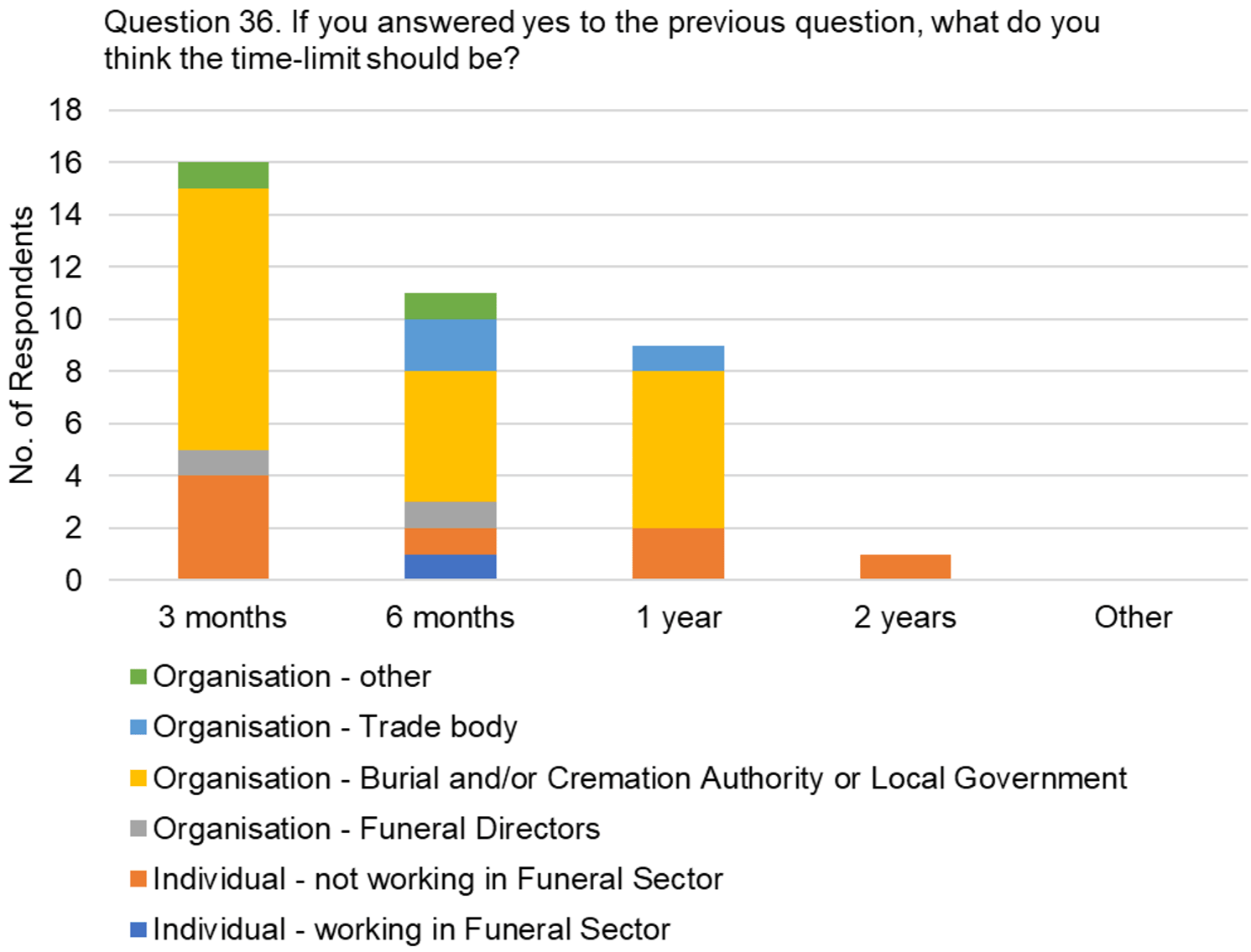
Qualitative data
Comments from respondents to this question favoured not delaying the exhumation once a feasibility report had been done and the exhumation approved, although it was noted that there may be some circumstances, such as bad weather, which might lead to a short delay. Reasons for this view mentioned that long delays may mean that the conditions mentioned in the feasibility report were changed.
“As time goes on the ground conditions, coffin conditions and circumstances may change, so exhumation should occur as quickly as possible following an application being granted.”
[Individual response – not working in funeral sector]
Question 37. Should requests for exhumation of known burials on private land be made to an Inspector of Burial, Cremation and Funeral Directors? (para 115 - 116)
This question asked respondents to select one option from a list of predetermined options (quantitative data), and in addition allowed a free text box for further comments (qualitative data).
Quantitative data
Forty-five (45) of the 59 respondents answered this question. A majority (n=41, 91%) of respondents answered ‘Yes’ that requests for exhumation of known burials on private land should be made to an Inspector of Burial, Cremation and Funeral Directors.
Table 26 and Figure 25 (below) show the responses broken down by respondent type (individual or organisational response, and whether, or not, respondents were part of the funeral sector).
| Respondent Type | No. of Responses (Q37) | ||
|---|---|---|---|
| Yes | No | Not Sure | |
| Individual - working in funeral sector | 2 | 0 | 0 |
| Individual - not working in funeral sector | 7 | 1 | 1 |
| Organisation - funeral directors | 2 | 0 | 0 |
| Organisation - burial and/or cremation authority or local government | 24 | 0 | 2 |
| Organisation - trade body | 3 | 0 | 0 |
| Organisation - other | 3 | 0 | 0 |
| All respondents | 41 | 1 | 3 |
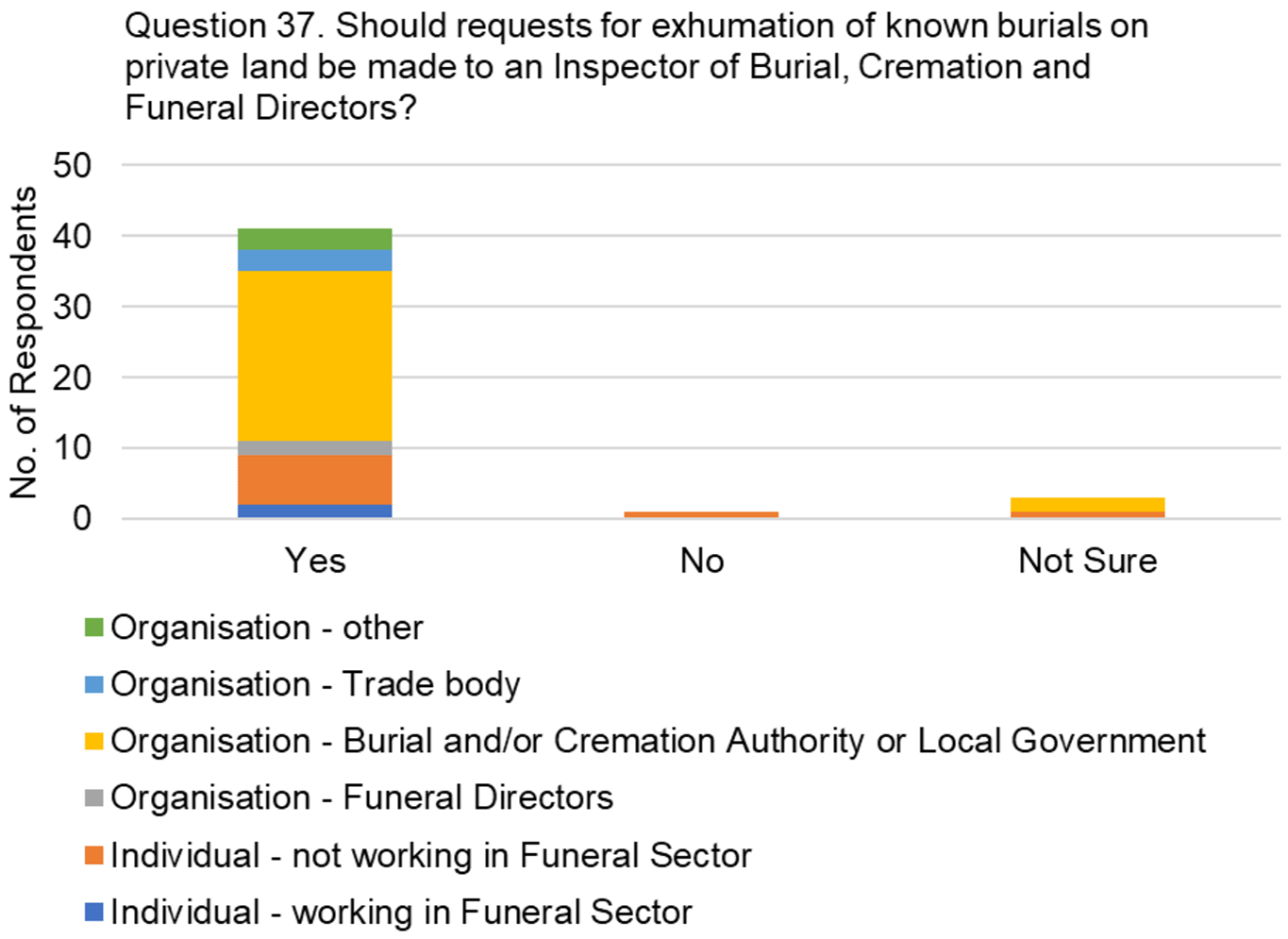
Qualitative data
The majority of respondents who answered “yes” to this question commented that there should be consistency in how exhumations of private burial and those involving public burial grounds are dealt with. One respondent noted there is an argument for greater scrutiny in relation to exhumation of private burials as there is additional regulation and oversight of burial authorities generally.
“Yes it should be treated in the same as an exhumation from a cemetery or burial ground, perhaps more so as it will not be regulated to the same extent as a burial authority.” [Organisation response, third sector]
One respondent questioned whether there was an intention to include exhumation for archaeological purposes in the regulations. They considered this might happen unintentionally. This will be kept in mind as the regulations are developed.
“We support the categories of exhumation that are set out in the consultation paper and agree with these important distinctions. However, we consider there may be the potential for exhumation of remains for archaeological purposes to be caught by this application to the Inspector and we are unsure whether this would be the intention. Because of this, we would highlight the potential need for a timeframe to be specified here to avoid the need for applications for archaeological investigations where the presence of human remains has been predicted in advance and may constitute a 'known burial’. This is distinct from those situations where unexpected remains are identified during works being undertaken, where there are clear procedures in place and protocols to be followed for these unexpected discoveries (category F – discovered human remains).” [Organisation response, burial authority]
Question 38. Where the person applying for exhumation from private land is not related to the deceased (e.g. a new landowner) what arrangements should be made for the exhumed remains? (para 118)
This question offered space for comments (qualitative data), without options to select from a predetermined list.
Qualitative data
There were 43 responses to this question. Three broad themes emerged in the comments provided. They were roughly equal in terms of the frequency with several respondents making two or three comments on the themes. Around 75% of respondents made one of more of these kind of comments.
Theme 1 – the applicant should be responsible for the costs
One of the most frequent comments respondents made focussed on who should be responsible for the costs of reinterment. Most suggested the applicant (landowner) should be responsible for the cost. A few suggested this should be the case only where no relatives had been traced or relatives have not offered alternative plans.
Theme 2 – Tracing relatives
Several respondents focussed comments on their view of tracing and making contact with surviving nearest relatives as particularly important. Some felt that efforts should be made by the applicant to make contact in advance of making an application, and evidence of this process be included as part of the application itself. Others made specific suggestion about how this tracing could be done e.g. local authority records, advertising (similar to suggestions for burial authorities tracing lair right-holders), public databases and details of previous owners of the land.
A couple of responses commented on getting permission from relatives of the deceased to exhume but did not comment on what might happen if consent were not given or relatives could not be traced.
Theme 3 – Reburial considerations
Respondents made suggestions about the kinds of things they felt were important considerations for reburial. These included:
- Relatives wishes
- Ensuring the deceased was treated respectfully
- Considering any known faith-based wishes and assumed original wishes of the deceased based on original burial choice
- Having the reburial as close to the original site as possible
- Historical significance (both to relatives of the deceased and to broader society) should be considered, specialist advice sought in cases of archaeological significance, and accurate recordings made of the process to ensure the relocation can be traced.
One respondent commented on the sensitivities around reburial and faith and suggested that the Inspector could consider this when being asked to decide on an exhumation.
“From a faith based perspective reburial is sensible but from a practical perspective then cremation seems to be the obvious arrangement. Perhaps this is an area where the inspector in granting the license needs to make a judgement and create a condition of the exhumation that its one or the other.” [Organisation response, trade body]
Some respondents suggested that plans for reburial or cremation should be included by the applicant in their application. A few respondents mentioned that the location of a burial on private land should be able to be identified and be part of the conveyancing process when the land is sold. It was noted that presence of information on title deeds might affect application consideration e.g. if title deeds specified ongoing provision for the deceased on the land. One respondent commented on taking different approaches depending on when the landowner became aware of the burial.
“If the burial has a marker it must be assume that a new land owner bought the land knowing that it contained a burial and the land owner will now be responsible for the cost. If the burial was unmarked and unknown at the time of purchase then the local authority should take responsibility.”
[individual response, does not work in the funeral sector]
Question 39. Please share any views you have on exhumation of discovered human remains from outside a burial ground. (para 119 - 125)
This question offered space for comments (qualitative data), without options to select from a predetermined list.
Qualitative data
This question set out various scenarios for when exhumation may be needed following discovery of human remains outwith a burial ground (or a burial on private land) where the found remains are considered to be:
- A recent burial
- A historic (archaeological) burial
- Remains found on land being developed.
The consultation paper proposed that these exhumations should continue to be dealt with via the existing procedures and are not intended to be considered by the Inspectors of Burial, Cremation and Funeral Directors but invited views on the scenarios provided. Most of the respondents agreed with the suggested approach and saw no need to change existing procedures.
One respondent suggested that a local authority should make arrangements for (re)burial or cremation under section 87 of the 2016 Act where the remains are found on land being developed.
“If a building developer unearths a mass grave or grave of unknown identity and the Police have discounted criminal activity, the Local Authority must take charge of the application to exhume and re-inter any remains under Section 87 of B&C (Scot) Act 2016, at the cost of the developer through the aforementioned procedures.”
[Individual response, working in funeral sector]
Two respondents provided the same comments in relation to the seven categories of exhumation identified on paragraph 92 of the consultation paper:
“….we feel that the 7 broad categories identified at the start of section 5 and within Section 92 of the Regulations needs to be expanded for clarity and future proof the regulations to incorporate the following two, principally archaeological, areas of concern:
- Exhumation – within an existing graveyard or place of worship (ie. Church being converted to a house and discovery of a crypt underneath)
- Rescue exhumations – Caused as a result of climate change/natural disaster/soil erosion such as land slips, beach erosion etc.
In terms of ‘Rescue exhumations’, although HES operate a call out system this is operated and designed to cope with small individual burials or sites discovered by chance. It is not designed to cope with the potential to deal with large scale and complex sites covering potentially hundreds of burials and memorials the costs of which could be in the millions of pounds in term of archaeology, conservation etc. Given the potential unknown costs of such works it would be unreasonable also to expect Burial Authorities, wither they Local Authorities or Private, to have the dedicated resources to deal with such cases. As such given the clear public concerns that may arise surrounding such cases if they should arise that recourse to the Scottish Government for separate emergency funding should be available.”
[Organisation response, local government and organisation response, other]
Another respondent also commented on the types of exhumations that could be defined but would fall outwith the proposed exhumation regulations being made under the 2016 Act such as exhumations as a result of soil erosion or archaeological remains.
“While the proposals broadly align with current operational practice, we would highlight that there are ethical issues with the reburial of archaeological remains which may not apply with more recent burials. The established practice for remains that are recovered through an archaeological process is for these to be carefully curated by an appointed museum. It may be helpful to make this distinction clear within the regulations and give consideration now as to how this would be explained in guidance.
We would also suggest that the categories of exhumation are widened to cover a greater range of scenarios – both to consider whether regulatory provisions are needed and to consider the scope of future guidance. These scenarios include exhumation of human remains from a place of worship that is coming out of use (or ruinous) and loss of significant proportions of burial grounds through coastal erosion and extreme weather events.”
[Organisation response, burial authority]
Question 40. What is your view on the proposed information to be collected by each burial authority in the Register of Exhumation relating to the exhumation of human remains carried out in a burial ground for which it is the burial authority? (para 126)
This question asked respondents to select as many options as they wanted from a list of predetermined options (quantitative data), and in addition allowed a free text box for further comments (qualitative data).
Quantitative data
Forty-one (41) of the 59 respondents answered this question. The most frequent response (n= 34) was “It looks right”. Since respondents could select more than one option there was a total of 42 choices made, with 1 respondent selecting more than one option.
Table 27 and Figure 26 (below) show the number of respondents who selected each option [NB. Respondents could select more than one option].
| Question 40 What is your view on the proposed information to be collected by each burial authority in the Register of Exhumation relating to the exhumation of human remains carried out in a burial ground for which it is the burial authority? (para 126) | No. of Responses |
|---|---|
| It looks right | 34 |
| It does not look right | 1 |
| Some of this is unnecessary information | 0 |
| There is some information missing | 7 |
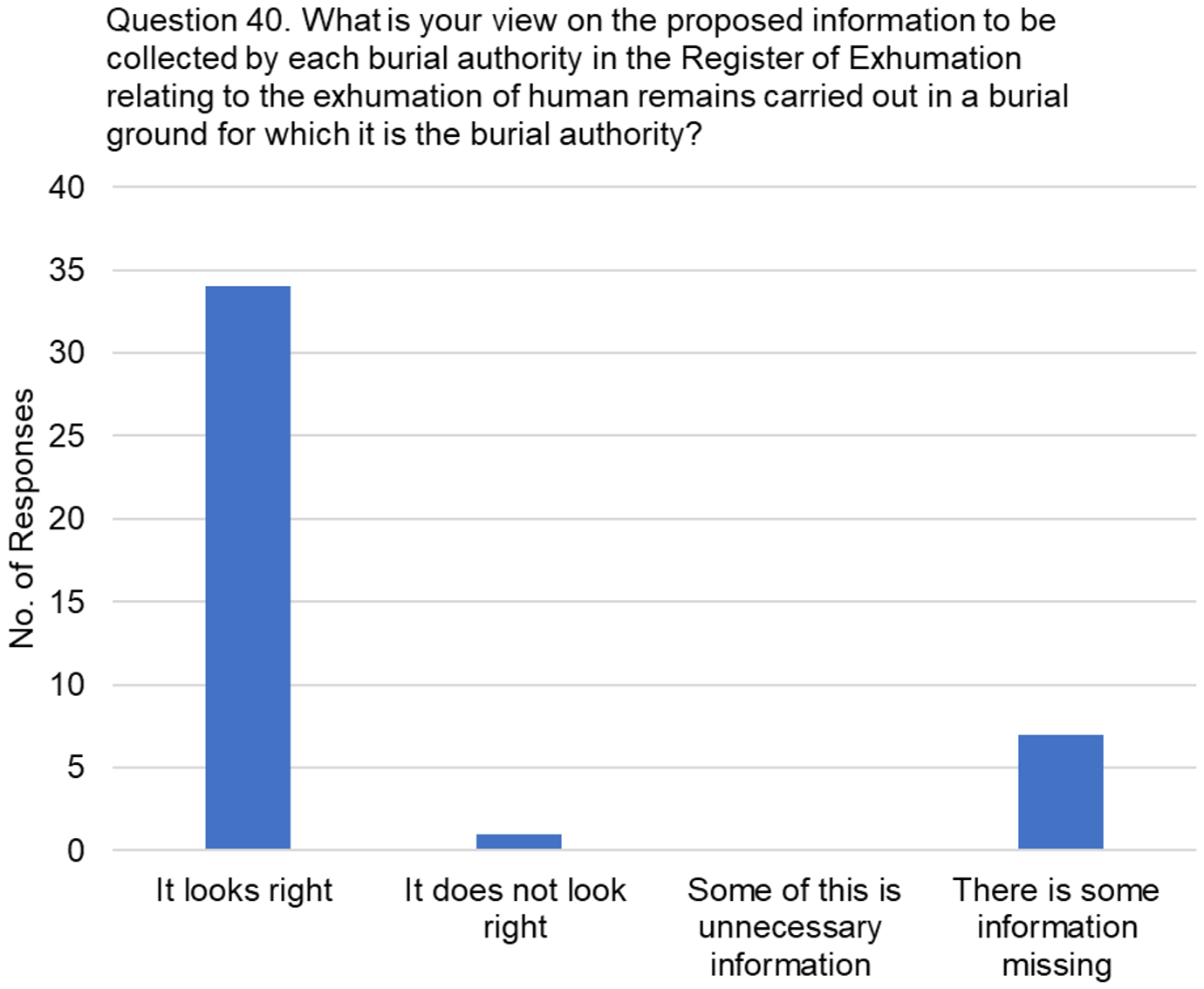
Qualitative data
Some respondents commented that it would be helpful to include a record of the reason for the exhumation in the register and details of any monuments or markers at the site. Others thought that including the precise location of where the exhumation occurred should be included, along with some other suggestions, such as any jewellery and what happened to it.
“Exact pre-exhumation location of grave Lair & section if in a cemetery. Outside a cemetery, exact location or GPS coordinates.
Depth removed from.
Any articles found within grave area.
Condition of existing coffin.
Component material of new coffin (if required)”
[Organisation response, trade body]
“It looks right. We might add however that a query line may be necessary to be added for the exhuming party to record any items found with remains, eg wedding bands, jewellery, etc. and what became of these.”
[Organisation response, third sector]
Question 41. What is your view on the proposed information to be collected by each local authority in the Register of Exhumation relating to the exhumation of human remains authorised for private burial by that local authority? (para 127)
This question asked respondents to select as many options as they wanted from a list of predetermined options (quantitative data), and in addition allowed a free text box for further comments (qualitative data).
Quantitative data
Thirty-eight (38) of the 59 respondents answered this question.
The most frequent response (n= 31) was “It looks right”. Since respondents could select more than one option there was a total of 39 choices made, with 1 respondent selecting more than one option.
Table 28 and Figure 27 (below) show the number of respondents who selected each option [NB. Respondents could select more than one option].
| Question 41 What is your view on the proposed information to be collected by each local authority in the Register of Exhumation relating to the exhumation of human remains authorised for private burial by that local authority? (para 127) | No. of Responses |
|---|---|
| It looks right | 31 |
| It does not look right | 1 |
| Some of this is unnecessary information | 0 |
| There is some information missing | 7 |
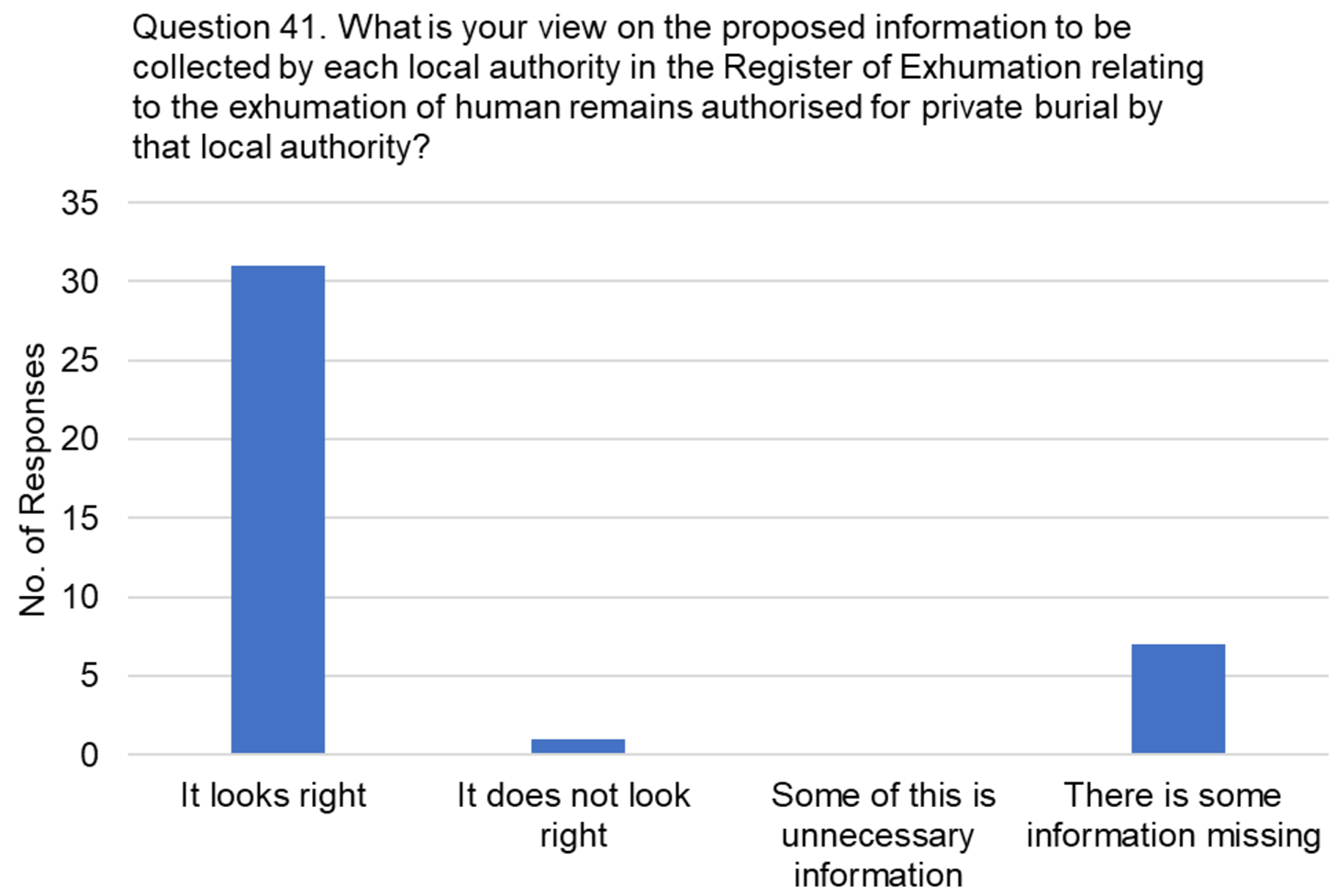
Qualitative data
Question 41 (exhumation of private burial) asked for broadly the same information as question 40 (exhumation from a burial ground) and respondents gave very similar, or the same, responses and comments. Respondents who provided a comment mostly agreed that the suggested list was comprehensive. A few suggested some additional information that could be included as they had done for question 40:
- Details of location where exhumation took place (GPS co-ordinates for home burials and lair location if in a burial ground)
- Depth of burial
- Condition of coffin being exhumed
- Any articles such as jewellery and what happened to them
One respondent noted that the date of birth of the deceased may not be available.
“We do not have dates of birth recorded. Historical records usually only records the date of interment.”
[Organisation response, burial authority]
1.6 Restoration of lairs
Question 42. Do you think that no less than 6 months from the date the notice is issued is an appropriate length of time for the lair right-holder to consent or object to the restoration of a lair? (para 132)
This question asked respondents to select one option from a list of predetermined options (quantitative data), and in addition allowed a free text box for further comments (qualitative data).
Quantitative data
Forty-five (45) of the 59 respondents answered this question. A majority (n=27, 60%) of respondents answered ‘Yes’ that no less than 6 months from the date the notice is issued is an appropriate length of time for the lair right-holder to consent or object to the restoration of a lair.
Table 29 and Figure 28 (below) show the responses broken down by respondent type (individual or organisational response, and whether, or not, respondents were part of the funeral sector).
| Respondent Type | No. of Responses (Q42) | |||
|---|---|---|---|---|
| Yes | No -too long | No - too short | Not sure | |
| Individual - working in funeral sector | 1 | 0 | 0 | 0 |
| Individual - not working in funeral sector | 4 | 1 | 6 | 1 |
| Organisation - funeral directors | 0 | 1 | 1 | 0 |
| Organisation - burial and/or cremation authority or local government | 20 | 1 | 4 | 1 |
| Organisation - trade body | 1 | 0 | 0 | 2 |
| Organisation - other | 1 | 0 | 0 | 0 |
| All respondents | 27 | 3 | 11 | 4 |
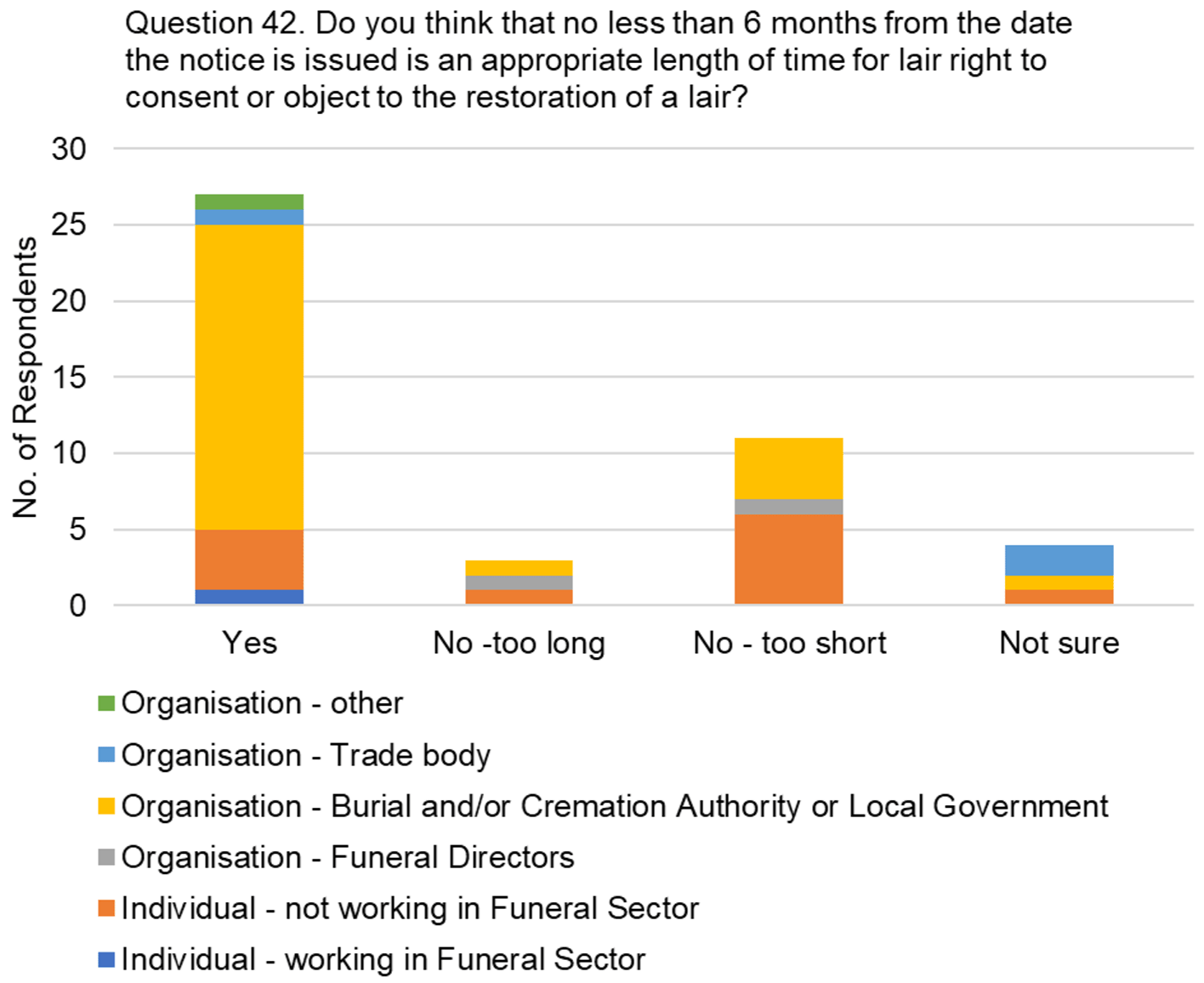
Qualitative data – If you answered ‘no’, please suggest a minimum time period
Although 19 respondents provided comment here, only 17 were considered eligible for inclusion in the analysis as the question was specifically aimed at those who had answered “no” in the first part of the question.
The majority of respondents who gave comments here had selected ‘no - too short’ in the first part of the question and tended to suggest 12 months was more appropriate to give lair right-holders adequate time to object, for example, if they no longer live in the locality, if records are outdated and a transfer of the right of burial is required and to allow proper time for advertising. One (1) respondent added that family and friends may only visit the burial ground on special occasions and 12 months would provide for that added flexibility.
Some respondents noted that a maximum timeframe is more important than a minimum. Two (2) respondents objected to restoration of lairs in general and used this space to voice general opposition. Three (3) respondents selected ‘no - too long’ with comments indicating the notification could be done much quicker, with one respondent suggesting 3-6 months. One (1) respondent highlighted specific faith-based concerns in relation to restoration of lairs in general and these will be considered as the regulations are developed.
Question 43. Do you think that no longer than 12 months from the date the notice is issued is an appropriate length of time for the lair right-holder to consent or object to the restoration of a lair? (para 132)
This question asked respondents to select one option from a list of predetermined options (quantitative data), and in addition allowed a free text box for further comments (qualitative data).
Quantitative data
Forty-five (45) of the 59 respondents answered this question. A majority (n=36, 80%) of respondents answered ‘Yes’ that no longer than 12 months from the date the notice is issued is an appropriate length of time for the lair right-holder to consent or object to the restoration of a lair.
Table 30 and Figure 29 (below) show the responses broken down by respondent type (individual or organisational response, and whether, or not, respondents were part of the funeral sector).
| Respondent Type | No. of Responses (Q43) | |||
|---|---|---|---|---|
| Yes | No -too long | No - too short | Not sure | |
| Individual - working in funeral sector | 1 | 0 | 0 | 0 |
| Individual - not working in funeral sector | 6 | 1 | 4 | 0 |
| Organisation - funeral directors | 2 | 0 | 0 | 0 |
| Organisation - burial and/or cremation authority or local government | 23 | 2 | 1 | 0 |
| Organisation - trade body | 3 | 0 | 0 | 0 |
| Organisation - other | 1 | 0 | 1 | 0 |
| All respondents | 36 | 3 | 6 | 0 |

Qualitative data - If your answered ‘no’, please suggest a maximum time period.
Although 11 respondents provided comment here, only eight were considered eligible for inclusion in the analysis as the question was specifically aimed at those who had answered “no” in the first part of the question.
Four (4) respondents thought the timeframe was too long. Explanations were short and tended to suggest a quicker timeframe would be sufficient.
“It is likely that restoration notices will all be done on mass, at the same time within an area of a cemetery. Therefore there needs to be a practical timescale to manage and monitor replies.” [Organisation response, burial authority]
Four (4) respondents felt the timescale was too short and most of these reiterated similar reasoning to that given in question 42. One suggested that 24 months was more appropriate, another felt 12 months should be a minimum due to the sensitives around reuse of lairs. One burial authority representing a faith group highlighted the impact on small volunteer run burial authorities and suggested that:
“a notice in an annual circular or newsletter at least 12 months before any action is taken should be acceptable” [Organisation response, faith based organisation]
Question 44. Where the burial authority cannot identify the lair right-holder, please provide your views on how a burial authority may publicise the intention to restore the lair. (para 133)
This question offered space for comments (qualitative data), without options to select from a predetermined list.
Qualitative data
Forty-four (44) respondents suggested ideas for publicising the intention to restore lairs for reuse and these comments were similar to the suggestions made under question 9 (publicising the intention to carry out inspections and potential corrective action to make headstones and memorials safe). These are summarised:
- Social media
- A repeated notice in the local paper
- Signage in the burial ground – e.g. entrance and noticeboards
- Restoration notice on the lair itself
- Council website
- Consultation with community groups, funeral directors, elected members, memorial masons and others
- targeted communications for elderly community groups and care home residents
- separate website or dedicated section of local authority website for all aspects of burial where public notices are advertised
- posting a letter to an old address
- notice cascaded through community communication channels publicising information in local and national media specific to relevant faith community
- Notifying local religious leaders and appropriate organisations in the faith community as they may have knowledge of families concerned.
A minority of respondents voiced concerns about public advertising and did not think any restoration of the lair should be carried out until the lair right-holder had expressly agreed, instead suggesting that the burial authority should be required to track the lair right-holder/ nearest relatives by checking relevant records.
Further comments were made such as:
- the need for clear guidance when a lair is first purchased
- that the burial authority should keep records of the actions it has taken to publicise (e.g. photographic evidence of placing signage and notices).
Question 45. What is your view on the proposed information to be collected in the Register of Restored Lairs? (para 134)
This question asked respondents to select as many options as they wanted from a list of predetermined options (quantitative data), and in addition allowed a free text box for further comments (qualitative data).
Quantitative data
Forty-two (42) of the 59 respondents answered this question. The most frequent response (n=33) was “It looks right”. Since respondents could select more than one option there was a total of 43 choices made, with 1 respondent selecting more than one option.
Table 31 and Figure 30 (below) show the number of respondents who selected each option [NB. Respondents could select more than one option].
| Question 45 What is your view on the proposed information to be collected in the Register of Restored Lairs? (para 134) | No. of Responses |
|---|---|
| It looks right | 33 |
| It does not look right | 2 |
| Some of this is unnecessary information | 1 |
| There is some information missing | 6 |
| Not sure | 1 |
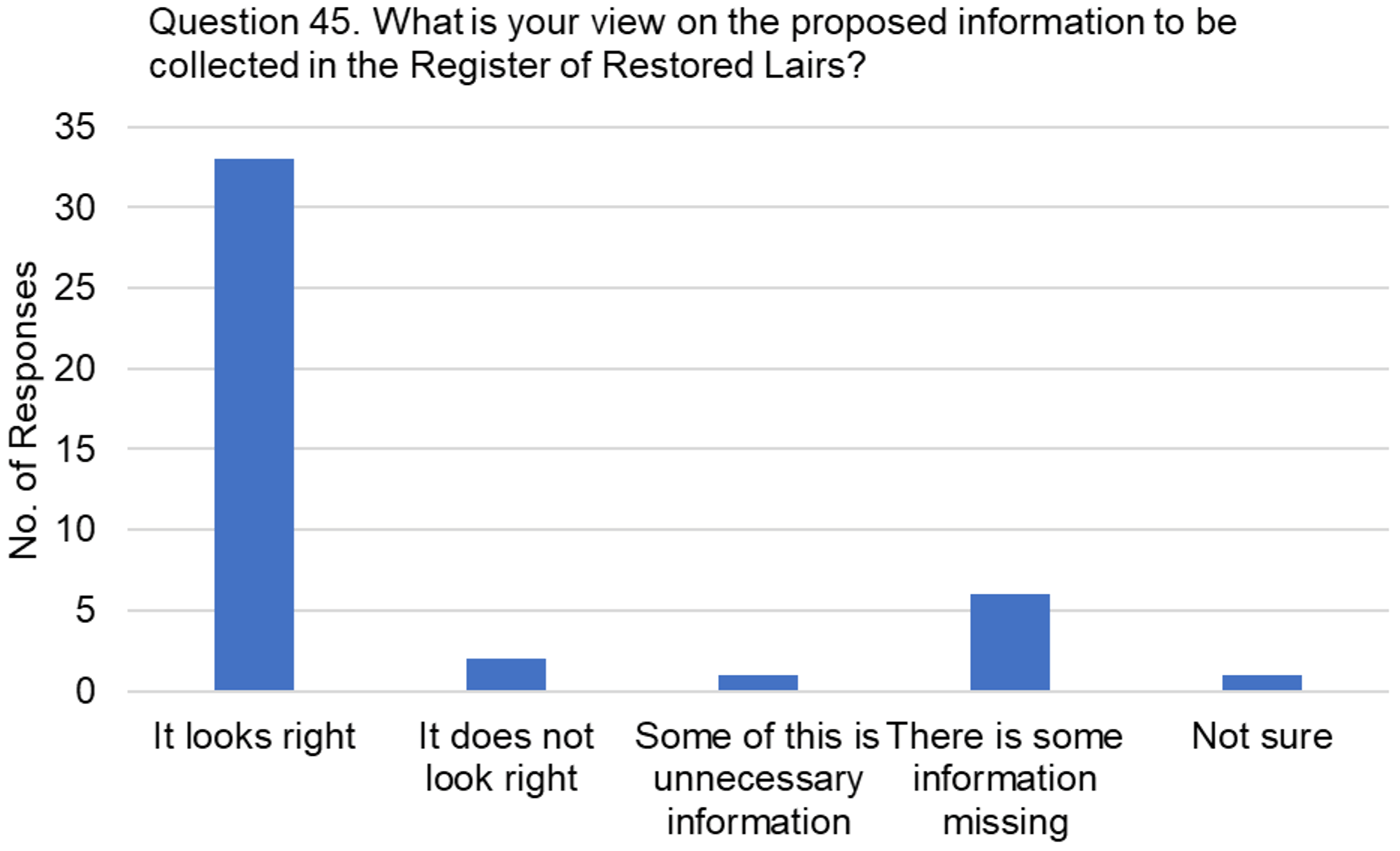
Qualitative data
Respondents were asked to give reasons for the answers they selected and 27 provided comment.
Around half of these respondents simply reiterated their agreement with the information to be collected in the Register of Restored Lairs, noting that the list was comprehensive.
Some respondents, whilst supportive of the proposal and agreeing “it looks right”, caveated this by providing additional comments and suggestions for consideration. In addition, around one third of respondents felt specific information was missing or was unnecessary, and their suggestions are summarised:
- addition of the reason for the exhumation
- confirmation that the lair right-holder has given agreement to the restoration or that the family line is extinct
- that existing memorial details are recorded and photographed
- if the deceased is moved, reburied or subject to another form of disposal, that this is updated under the same register entry
- Photographic record of work done before and after and to make this publicly available and easily accessible
- age and last known address of the deceased should be recorded, where known
- Inclusion of a record of any cremation caskets and their position in the lair
One (1) respondent opined that certain register information would not be required in every case – e.g. objections.
Two (2) respondents were in opposition to the restoration of lairs in principle and stated this in their comments.
Question 46. If the lair is to be used for a further burial and it is not possible to return a headstone to its original position do you have any views on how it should be preserved or retained? (para 135)
This question offered space for comments (qualitative data), without options to select from a predetermined list.
Qualitative data
Forty-one (41) respondents answered this question and comments have been summarised under 3 themes.
Theme 1 - Relocation of a headstone
One of the most frequent responses to this question was respondents suggesting there should be an allocated area for display of these original headstones alongside similar stones from restored lairs. Additionally some suggested that a marker should be on the original lair and/or a reference to the original lair position alongside the headstone itself.
“My issue here would be that if a headstone is replaced after exhumation then in most cases there is insufficient space for a new stone. My preference would be for the stone to be removed entirely and a smaller marker installed as a replacement. This would also define the lair as 'restored'” [Organisation response, burial authority]
Others suggested that the original headstone could be placed alongside any new stone e.g. at the back with inscription facing out, laid flat there or buried in the lair. Some suggested that if it is being moved that it should be kept as close to the original lair as possible, and within the same burial ground. Some respondents commented that burial authority storage capacity may be a challenge.
Some respondents suggested that a new, smaller marker could be placed at the original lair, and that this could also include details of digital records that could be accessed (see ‘Recording headstone details’ below). A few respondents commented on disposal of headstones suggesting recycling/reuse might be possible, and that disposal should be “sympathetic” and “appropriate”.
Theme 2 - Recording headstone details
Nearly half of respondents made suggestions around recording the details of headstones. Many of these suggested digital records, written and photographed, should contain as many details of the headstone and inscription as possible. Public access to these records was also raised, with suggestions of use of QR codes (which could be displayed on any lair markers) to link to this.
Respondents representing organisations concerned with conservation and heritage emphasised that archaeological and specialise heritage advice should be sought, and consideration given to historic significance of headstones, including in decisions around whether these should be moved or not, as well as in terms of recording, storing and curating these if they are moved.
“Due consideration should be given to headstones of significance or of early date (18thC and earlier) for them to be either retained on site, offered to a local museum or in certain circumstances if they are removed they may be worthy of being subjected to Treasure Trove (taking into consideration recent examples of unexpected Early Medieval carvings being found on stones in graveyards). Individual headstones may on occasion also be subject to Listed or Scheduled status in their own right and due process will need to be followed in those circumstances before any final decisions are made on repositioning.” [Organisation response, burial authority]
Theme 3 - Reinstatement or repair of a headstone
Some respondents voiced opposition to removing a headstone from its original lair and felt that efforts should be made to repair and reinstate headstones, or replace these with new ones if that repair was not possible.
1.7 Any other comments
Question 47. Please provide any additional views or comments you may have on any aspect of the proposed burial regulations.
This question offered space for comments (qualitative data), without options to select from a predetermined list.
Qualitative data
Twenty-eight (28) respondents provided additional views on the burial regulations. Some of these comments were short statements of support for the Scottish Government’s proposals. Others were general complaints about the condition of particular burial grounds. However, the majority of respondents used this space to provide substantial comments on a variety of different and important issues. Although the detail of these comments cannot be presented in full here, a number of common areas were identified and are summarised below.
Theme 1 - Transfer of Right of Burial
A number of respondents remarked that they would welcome a shared approach to the transfer of right of burial either in regulations, guidance or a code of practice.
Theme 2 - Resource implications
Two (2) respondents representing local authority burial authorities expressed concerns about the additional resource that will be required to implement the regulations, especially in relation to private burial.
Theme 3 - Heritage
Three (3) respondents raised concerns around the lack of protection for historical burial grounds. Respondents highlighted a lack of data to assist in their management, a lack of awareness among burial authorities of statutory designations (listed or scheduled) and the importance of protecting undesignated burial sites and features.
Theme 4 – other comments
Other comments made, include (not exhaustive):
- Clarification on what happens to the existing human remains once the lair has been restored
- Minimum depth of last coffin burial
- Electronic transfer of documentation
- Standardisation of memorial masonry – e.g. the supply and setting of memorial foundations, registration and qualifications of stonemasons, insurance.
- Concerns around the diversity and representation on the Burial Regulations Working Group, which too heavily consisted of local authority burial authorities to the detriment of other sectors
- Concerns around burial authority staffing levels resulting in funeral directors carrying and lowering coffins
- Guidance or regulation on emergency exhumation – e.g. loss of part of a burial ground through extreme weather events due to climate change and the need for emergency funding from the Scottish Government.
- The need for greater emphasis on environmental sustainability
- Clarity on the process to be followed where remains are found in a burial ground during routine maintenance or addition of utilities and where origins are unclear.
- Concerns around standard burial application forms and the number of forms.
One (1) respondent felt that the consultation had not been well advertised and should be extended.
One (1) respondent, representing a local authority burial authority, used this space to provide a separate comprehensive response to the consultation from the local authority’s archaeology team. The comments made here have been considered and reported under each of the relevant consultation questions.
Contact
Email: BurialAndCremation@gov.scot
There is a problem
Thanks for your feedback